 |
 |
 |
 |
 |
 |
| |
 |
|
 |
 |
 |
  |
  |
 |
 |
 |
 |
|
  |
 |
 |
|
 |
 |
  |
 |
 |
|
 |
 |
  |
 |
 |
|
 |
 |
  |
 |
 |
|
 |
 |
  |
 |
 |
|
 |
 |
  |
 |
 |
|
 |
 |
  |
 |
 |
|
 |
 |
  |
 |
 |
|
 |
 |
  |
 |
 |
|
 |
 |
  |
 |
 |
|
 |
 |
  |
 |
 |
|
 |
 |
  |
 |
 |
|
 |
 |
  |
 |
 |
|
 |
 |
  |
 |
 |
|
 |
 |
  |
 |
 |
|
 |
 |
  |
 |
 |
|
 |
 |
  |
 |
 |
|
 |
 |
  |
 |
 |
|
 |
 |
  |
 |
 |
|
 |
 |
  |
 |
 |
|
 |
 |
  |
 |
 |
|
 |
 |
  |
 |
 |
|
 |
 |
  |
 |
 |
|
 |
 |
  |
 |
 |
|
 |
 |
  |
 |
 |
|
 |
 |
  |
 |
 |
|
 |
 |
  |
 |
 |
|
 |
 |
  |
 |
 |
|
 |
 |
  |
 |
 |
|
 |
 |
  |
 |
 |
|
 |
 |
  |
 |
 |
|
 |
 |
  |
 |
 |
|
 |
 |
  |
 |
 |
|
 |
 |
  |
 |
 |
|
 |
 |
  |
 |
 |
|
 |
 |
  |
 |
 |
|
 |
 |
  |
 |
 |
|
 |
 |
  |
 |
 |
|
 |
 |
  |
 |
 |
|
 |
 |
  |
 |
 |
|
 |
 |
  |
 |
 |
|
 |
 |
  |
 |
 |
|
 |
 |
  |
 |
 |
|
 |
 |
  |
 |
 |
|
 |
 |
  |
 |
 |
|
 |
 |
  |
 |
 |
|
 |
 |
  |
 |
 |
|
 |
 |
  |
 |
 |
|
 |
 |
  |
 |
 |
|
 |
 |
  |
 |
 |
|
 |
 |
  |
 |
 |
|
 |
 |
  |
 |
 |
|
 |
 |
  |
 |
 |
|
 |
 |
  |
 |
 |
|
 |
 |
  |
 |
 |
|
 |
 |
  |
 |
 |
|
 |
 |
  |
 |
 |
|
 |
 |
  |
 |
 |
|
 |
 |
  |
 |
 |
|
 |
 |
  |
 |
 |
|
 |
 |
  |
 |
 |
|
 |
 |
  |
 |
 |
|
 |
 |
  |
 |
 |
|
 |
 |
  |
 |
 |
|
 |
 |
  |
 |
 |
|
 |
 |
  |
 |
 |
|
 |
 |
  |
 |
 |
|
 |
 |
  |
 |
 |
|
 |
 |
  |
 |
 |
|
 |
 |
  |
 |
 |
|
 |
 |
  |
 |
 |
|
 |
 |
  |
 |
 |
|
 |
 |
  |
 |
 |
|
 |
 |
  |
 |
 |
|
 |
 |
  |
 |
 |
|
 |
 |
  |
 |
 |
|
 |
 |
  |
 |
 |
|
 |
 |
  |
 |
 |
|
 |
 |
  |
 |
 |
|
 |
 |
  |
 |
 |
|
 |
 |
  |
 |
 |
|
 |
 |
  |
 |
 |
|
 |
 |
  |
 |
 |
|
 |
 |
  |
 |
 |
|
 |
 |
  |
 |
 |
|
 |
 |
  |
 |
 |
|
 |
 |
  |
 |
 |
|
 |
 |
  |
 |
 |
|
 |
 |
  |
 |
 |
|
 |
 |
  |
 |
 |
|
 |
 |
  |
 |
 |
|
 |
 |
  |
 |
 |
|
 |
 |
  |
 |
 |
|
 |
 |
  |
 |
 |
|
 |
 |
  |
 |
 |
|
 |
 |
  |
 |
 |
|
 |
 |
  |
 |
 |
|
 |
 |
  |
 |
 |
|
 |
 |
  |
 |
 |
|
 |
 |
  |
 |
 |
|
 |
 |
  |
 |
 |
|
 |
 |
  |
 |
 |
|
 |
 |
  |
 |
 |
|
 |
 |
  |
 |
 |
|
 |
 |
  |
 |
 |
|
 |
 |
  |
 |
 |
|
 |
 |
  |
 |
 |
|
 |
 |
  |
 |
 |
|
 |
 |
  |
 |
 |
|
 |
 |
  |
 |
 |
|
 |
 |
  |
 |
 |
|
 |
 |
  |
 |
 |
|
 |
 |
  |
 |
 |
|
 |
 |
  |
 |
 |
|
 |
 |
  |
 |
 |
|
 |
 |
  |
 |
 |
|
 |
 |
  |
 |
 |
|
 |
 |
  |
 |
 |
|
 |
 |
  |
 |
 |
|
 |
 |
  |
 |
 |
|
 |
 |
  |
 |
 |
|
 |
 |
  |
 |
 |
|
 |
 |
  |
 |
 |
|
 |
 |
  |
 |
 |
|
 |
 |
  |
 |
 |
|
 |
 |
  |
 |
 |
|
 |
 |
  |
 |
 |
|
 |
 |
  |
 |
 |
|
 |
 |
  |
 |
 |
|
 |
 |
  |
 |
 |
|
 |
 |
  |
 |
 |
|
 |
 |
  |
 |
 |
|
 |
 |
  |
 |
 |
|
 |
 |
  |
 |
 |
|
 |
 |
  |
 |
 |
|
 |
 |
  |
 |
 |
|
 |
 |
  |
 |
 |
|
 |
 |
  |
 |
 |
|
 |
 |
  |
 |
 |
|
 |
 |
  |
 |
 |
|
 |
 |
  |
 |
 |
|
 |
 |
  |
 |
 |
|
 |
 |
  |
 |
 |
|
 |
 |
  |
 |
 |
|
 |
 |
  |
 |
 |
|
 |
 |
  |
 |
 |
|
 |
 |
  |
 |
 |
|
 |
 |
  |
 |
 |
|
 |
 |
  |
 |
 |
|
 |
 |
  |
 |
 |
|
 |
 |
  |
 |
 |
|
 |
 |
  |
 |
 |
|
 |
 |
  |
 |
 |
|
 |
 |
  |
 |
 |
|
 |
 |
  |
 |
 |
|
 |
 |
  |
 |
 |
|
 |
 |
  |
 |
 |
|
 |
 |
  |
 |
 |
|
 |
 |
  |
 |
 |
|
 |
 |
  |
 |
 |
|
 |
 |
  |
 |
 |
|
 |
 |
  |
 |
 |
|
 |
 |
  |
 |
 |
|
 |
 |
  |
 |
 |
|
 |
 |
  |
 |
 |
|
 |
 |
  |
 |
 |
|
 |
 |
  |
 |
 |
|
 |
 |
  |
 |
 |
|
 |
 |
  |
 |
 |
|
 |
 |
  |
 |
 |
|
 |
 |
  |
 |
 |
|
 |
 |
  |
 |
 |
|
 |
 |
  |
 |
 |
|
 |
 |
  |
 |
 |
|
 |
 |
  |
 |
 |
|
 |
 |
  |
 |
 |
|
 |
 |
  |
 |
 |
|
 |
 |
  |
 |
 |
|
 |
 |
  |
 |
 |
|
 |
 |
  |
 |
 |
|
 |
 |
  |
 |
 |
|
 |
 |
  |
 |
 |
|
 |
 |
  |
 |
 |
|
 |
 |
  |
 |
 |
|
 |
 |
  |
 |
 |
|
 |
 |
  |
 |
 |
|
 |
 |
  |
 |
 |
|
 |
 |
  |
 |
 |
|
 |
 |
  |
 |
 |
|
 |
 |
  |
 |
 |
|
 |
 |
  |
 |
 |
|
 |
 |
  |
 |
 |
|
 |
 |
  |
 |
 |
|
 |
 |
  |
 |
 |
|
 |
 |
  |
 |
 |
|
 |
 |
  |
 |
 |
|
 |
 |
  |
 |
 |
|
 |
 |
  |
 |
 |
|
 |
 |
  |
 |
 |
|
 |
 |
  |
 |
 |
|
 |
 |
  |
 |
 |
|
 |
 |
  |
 |
 |
|
 |
 |
  |
 |
 |
|
 |
 |
  |
 |
 |
|
 |
 |
  |
 |
 |
|
 |
 |
  |
 |
 |
|
 |
 |
  |
 |
 |
|
 |
 |
  |
 |
 |
|
 |
 |
  |
 |
 |
|
 |
 |
  |
 |
 |
|
 |
 |
  |
 |
 |
|
 |
 |
  |
 |
 |
|
 |
 |
  |
 |
 |
|
 |
 |
  |
 |
 |
|
 |
 |
  |
 |
 |
|
 |
 |
  |
 |
 |
|
 |
 |
  |
 |
 |
|
 |
 |
  |
 |
 |
|
 |
 |
  |
 |
 |
|
 |
 |
  |
 |
 |
|
 |
 |
  |
 |
 |
|
 |
 |
  |
 |
 |
|
 |
 |
  |
 |
 |
|
 |
 |
  |
 |
 |
|
 |
 |
  |
 |
 |
|
 |
 |
  |
 |
 |
|
 |
 |
  |
 |
 |
|
 |
 |
  |
 |
 |
|
 |
 |
  |
 |
 |
|
 |
 |
  |
 |
 |
|
 |
 |
  |
 |
 |
|
 |
 |
  |
 |
 |
|
 |
 |
  |
 |
 |
|
 |
 |
  |
 |
 |
|
 |
 |
  |
 |
 |
|
 |
 |
  |
 |
 |
|
 |
 |
  |
 |
 |
|
 |
 |
  |
 |
 |
|
 |
 |
  |
 |
 |
|
 |
 |
  |
 |
 |
|
 |
 |
  |
 |
 |
|
 |
 |
  |
 |
 |
|
 |
 |
  |
 |
 |
|
 |
 |
  |
 |
 |
|
 |
 |
  |
 |
 |
|
 |
 |
  |
 |
 |
|
 |
 |
  |
 |
 |
|
 |
 |
  |
 |
 |
|
 |
 |
  |
 |
 |
|
 |
 |
  |
 |
 |
|
 |
 |
  |
 |
 |
|
 |
 |
  |
 |
 |
|
 |
 |
  |
 |
 |
|
 |
 |
  |
 |
 |
|
 |
 |
  |
 |
 |
|
 |
 |
  |
 |
 |
|
 |
 |
  |
 |
 |
|
 |
 |
  |
 |
 |
|
 |
 |
  |
 |
 |
|
 |
 |
  |
 |
 |
|
 |
 |
  |
 |
 |
|
 |
 |
  |
 |
 |
|
 |
 |
  |
 AR on Social Networks AR on Social Networks |
 |
|
 |
 |
  |
 Opening of new building for the Yacht Club de Monaco by Foster + Partners Opening of new building for the Yacht Club de Monaco by Foster + Partners |
 |
June 27, 2014
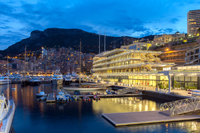 Opening celebrations were held at the Yacht Club de Monaco, led by HSH Prince Albert II and attended by Lord Foster and the club’s members. The new building forms the centrepiece of the remodelled harbour – its impressive new social and sporting facilities preserve the club’s heritage and traditions, while reinforcing Monaco as the leading international centre for yachting excellence and further developing the Principality’s thriving yacht industry. Opening celebrations were held at the Yacht Club de Monaco, led by HSH Prince Albert II and attended by Lord Foster and the club’s members. The new building forms the centrepiece of the remodelled harbour – its impressive new social and sporting facilities preserve the club’s heritage and traditions, while reinforcing Monaco as the leading international centre for yachting excellence and further developing the Principality’s thriving yacht industry.
Designed in response to the local climate, the new clubhouse sets high standards for sustainable design – the building is powered by renewable energy and incorporates photovoltaic cells, solar thermal panels and sea water cooling systems to take advantage of the sun and waterfront site. The architecture is a celebration of sailing – its large, deck-like terraces step up along the harbour to offer unrivalled views out to races at sea, as well as views inland over the Formula 1 Grand Prix circuit.
Lord Foster: “The building is a little like a city in microcosm, with schools, parks, offices, restaurants, a network of interior circulation ‘streets’ and a hierarchy of public and private, social and functional spaces. It is a continuation of Monaco’s dense urban fabric, as well as the Yacht Club’s traditions and will be an important part of civic life. Every child in Monaco learns sailing at some stage during their education and those lessons will be in the new building – as a result, the Yacht Club will become even more rooted, in a public sense, in the Principality and part of its cultural and urban fabric.” |
 |
 |
  |
 schmidt hammer lassen architects designs new cultural home for Chinese Labour Union schmidt hammer lassen architects designs new cultural home for Chinese Labour Union |
 |
May 16, 2014
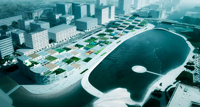 schmidt hammer lassen architects has completed the design for a unique new cultural home for the city Labour Union in Ningbo, China. The 100,000 square metre project, known as the Home of Staff, was won by schmidt hammer lassen architects in an international competition in 2013. With an eclectic mix of functions, split across two separate buildings, the project is linked by a landscape park stretching over half a kilometre. The Home of Staff provides support, health, education, culture and leisure facilities for almost 3 million Ningbo Labour Union members. schmidt hammer lassen architects has completed the design for a unique new cultural home for the city Labour Union in Ningbo, China. The 100,000 square metre project, known as the Home of Staff, was won by schmidt hammer lassen architects in an international competition in 2013. With an eclectic mix of functions, split across two separate buildings, the project is linked by a landscape park stretching over half a kilometre. The Home of Staff provides support, health, education, culture and leisure facilities for almost 3 million Ningbo Labour Union members.
The Ningbo Labour Union has named the project the Home of Staff as they see it as a second home for the members they represent. The project sits at the centre of Ningbo New East Town on the edge of a new ecological wetland area forming the new cultural hub of the city, including the New Ningbo Library, also designed by schmidt hammer lassen architects.
“We have designed the Home of Staff as a series of stepped building volumes that are linked by a landscape that rises from a central public park to become a series of accessible green roof terraces”, explains Morten Schmidt, founding partner at schmidt hammer lassen architects. “The volumes, which from the air appear like a pixelated image, rise up at each end and form two individual buildings that are connected by a sunken walkway and a series of park pavilions.” |
 |
 |
  |
 Extension and renovation of Vendsyssel Hospital in Denmark by C.F. Møller Extension and renovation of Vendsyssel Hospital in Denmark by C.F. Møller |
 |
May 15, 2014
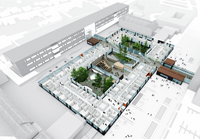 C.F. Møller has won the competition for the extension and refurbishment of the Vendsyssel Hospital in Hjørring (Denmark). This design proposals seeks to enhance the overarching architectonic identity of the hospital and to integrate buildings and landscapes in various ways, including a rooftop children's oasis. C.F. Møller has won the competition for the extension and refurbishment of the Vendsyssel Hospital in Hjørring (Denmark). This design proposals seeks to enhance the overarching architectonic identity of the hospital and to integrate buildings and landscapes in various ways, including a rooftop children's oasis.
The task includes construction of a new treatment facility (covering about 14,000 m2), a mother and child unit and the overall planning of the extension and refurbishment of the Vendsyssel Hospital site including existing buildings.
The design of the new wings creates an enclosed form surrounding large, well-lit courtyards. The structure is transparent; a circulation loop connects the individual treatment areas and allows for flexibility and overlaps between neighbouring functions. The result is a logical, self-explanatory structure. There are efficient and highly functional links making it easy to find your way around the building.
The clear-cut yet distinctive architecture features sterling materials, in combination with a strong emphasis on landscape, including a series of outdoor spaces with integrated planting, paving and stormwater handling, successfully exploiting every opportunity to create healing architecture. One special characteristic of the building is the layout of the third-floor paediatric unit, which includes a bright and children-friendly interior design, and an enclosed and protected playground, resembling a green oasis, on the roof. |
 |
 |
  |
 Marseille Vieux Port wins European Prize for Urban Public Space Marseille Vieux Port wins European Prize for Urban Public Space |
 |
April 30, 2014
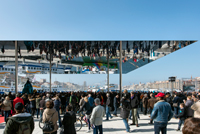 The redevelopment of Marseille’s Vieux Port was jointly awarded the 2014 European Prize for Urban Public Space. The biennial prize, which attracted 274 entries from 30 countries, is organized by seven architecture institutions and is the only award of its kind in Europe. The redevelopment of Marseille’s Vieux Port was jointly awarded the 2014 European Prize for Urban Public Space. The biennial prize, which attracted 274 entries from 30 countries, is organized by seven architecture institutions and is the only award of its kind in Europe.
The Prize was established to recognise the public character of urban spaces and their capacity for promoting social cohesion. The regeneration of the Vieux Port, designed by landscape architect Michel Desvigne Paris (MDP) and architect Foster + Partners, has reclaimed the quaysides as a civic space, removing traffic to create a safe, pedestrian friendly public realm and creating space for performances and events. The landscape design includes new granite paving, which echoes the colour of the original limestone cobbles. The practice has designed a new range of street furniture specifically for the project, as well as the new wooden nautical clubs over the water.
Architecturally, the waterfront has been enhanced using very discreet means. At the broad eastern edge of the harbour, designed by Foster + Partners, a blade of reflective stainless steel shelters a flexible new pavilion for events and markets. Open on all sides, the 46 by 22 metre ‘ombrière’ is held aloft on slender pillars, 6 metres high. The underside of the canopy is a mirror for the sea and life of the port – from the water, it resembles nothing more than a simple line of silver on the horizon. |
 |
 |
  |
 Basketball stadium in Dongguan, China, by gmp von Gerkan Marg and Partners Basketball stadium in Dongguan, China, by gmp von Gerkan Marg and Partners |
 |
April 14, 2014
 In the southern Chinese city of Dongguan – a city of several million – a basketball stadium has been completed to plans by architects von Gerkan, Marg and Partners (gmp). The building can be seen from afar and is a landmark that provides identity and orientation to the people in the new district of Liaobu. The stadium has space for nearly 15,000 visitors and can be used for sports and other events; it is the new main competition venue for one of the most successful Chinese basketball teams, the Dongguan Leopards. Basketball is increasingly popular with the Chinese, particularly so since Yao Ming, who is celebrated as a national hero, made his entry into the US basketball league – the NBA. In the southern Chinese city of Dongguan – a city of several million – a basketball stadium has been completed to plans by architects von Gerkan, Marg and Partners (gmp). The building can be seen from afar and is a landmark that provides identity and orientation to the people in the new district of Liaobu. The stadium has space for nearly 15,000 visitors and can be used for sports and other events; it is the new main competition venue for one of the most successful Chinese basketball teams, the Dongguan Leopards. Basketball is increasingly popular with the Chinese, particularly so since Yao Ming, who is celebrated as a national hero, made his entry into the US basketball league – the NBA.
The design of the stadium transforms the elements of the sport of basketball in various ways: situated on a raised platform, the circular ring is reminiscent of the hoop of a basketball basket to which the facade is attached like the net to the hoop. The typical orange colour of the ball appears behind the net-like facade in the form of the external structure of the arena, and also features in the interior design.
The stadium is surrounded by extensive parkland which acts as a buffer zone between the building and the relatively noisy surrounding roads. The design of the landscape takes its cue from the shape of the stadium. Extensive green areas and curved pathways along water features surround the stadium and serve as sport and leisure areas. |
 |
 |
  |
 House of Music in Aalborg, Denmark, by Coop Himmelb(l)au House of Music in Aalborg, Denmark, by Coop Himmelb(l)au |
 |
April 10, 2014
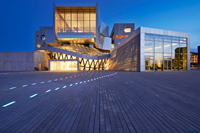 After four years of construction, the "House of Music" in Aalborg, Denmark was ceremoniously opened by the Danish Queen Margrethe II. After four years of construction, the "House of Music" in Aalborg, Denmark was ceremoniously opened by the Danish Queen Margrethe II.
This cultural centre was designed by the Viennese architectural studio Coop Himmelb(l)au as a combined school and concert hall: its open structure promotes the exchange between the audience and artists, and the students and teachers. "The idea behind the building can already be read from the outer shape. The school embraces the concert hall," explained Wolf D. Prix, design principal and CEO of Coop Himmelb(l)au.
U-shaped rehearsal and training rooms are arranged around the core of the ensemble, a concert hall for about 1,300 visitors. A generous foyer connects these spaces and opens out with a multi-storey window area onto an adjacent cultural space and a fjord. Under the foyer, three more rooms of various sizes complement the space: the intimate hall, the rhythmic hall, and the classic hall. Through multiple observation windows, students and visitors can look into the concert hall from the foyer and the practice rooms and experience the musical events, including concerts and rehearsals. |
 |
 |
  |
 2014 Pritzker Prize goes to Shigeru Ban 2014 Pritzker Prize goes to Shigeru Ban |
 |
March 25, 2014
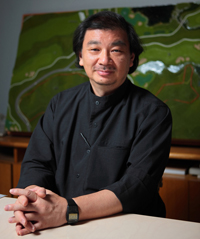 Shigeru Ban will receive the 2014 Pritzker Architecture Prize. Shigeru Ban will receive the 2014 Pritzker Architecture Prize.
Shigeru Ban, a Tokyo-born, 56-year-old architect with offices in Tokyo, Paris and New York, is rare in the field of architecture. He designs elegant, innovative work for private clients, and uses the same inventive and resourceful design approach for his extensive humanitarian efforts. For twenty years Ban has traveled to sites of natural and man-made disasters around the world, to work with local citizens, volunteers and students, to design and construct simple, dignified, low-cost, recyclable shelters and community buildings for the disaster victims.
Reached at his Paris office, Shigeru Ban said, “Receiving this prize is a great honor, and with it, I must be careful. I must continue to listen to the people I work for, in my private residential commissions and in my disaster relief work. I see this prize as encouragement for me to keep doing what I am doing – not to change what I am doing, but to grow.“
In all parts of his practice, Ban finds a wide variety of design solutions, often based around structure, materials, view, natural ventilation and light, and a drive to make comfortable places for the people who use them. From private residences and corporate headquarters, to museums, concert halls and other civic buildings, Ban is known for the originality, economy, and ingeniousness of his works, which do not rely on today’s common high-tech solutions.
His architecture is often called “sustainable”, and environmentally friendly, but he says, “When I started working this way, almost thirty years ago, nobody was talking about the environment. But this way of working came naturally to me. I was always interested in low cost, local, reusable materials.”
» Read more |
 |
 |
  |
 Serpentine Galleries Pavilion 2014 by Smiljan Radic Serpentine Galleries Pavilion 2014 by Smiljan Radic |
 |
March 17, 2014
 The Serpentine has commissioned Chilean architect Smiljan Radic to design the Serpentine Galleries Pavilion 2014. Radic is the fourteenth architect to accept the invitation to design a temporary Pavilion outside the entrance to the Serpentine Gallery in Kensington Gardens. The commission is one of the most anticipated events in the cultural calendar, and has become one of London’s leading summer attractions since launching in 2000. The Serpentine has commissioned Chilean architect Smiljan Radic to design the Serpentine Galleries Pavilion 2014. Radic is the fourteenth architect to accept the invitation to design a temporary Pavilion outside the entrance to the Serpentine Gallery in Kensington Gardens. The commission is one of the most anticipated events in the cultural calendar, and has become one of London’s leading summer attractions since launching in 2000.
Smiljan Radic’s design follows Sou Fujimoto’s cloud-like structure, which was visited by almost 200,000 people in 2013 and was one of the most visited.
Occupying a footprint of some 350 square metres on the lawn of the Serpentine Gallery, plans depict a semi-translucent, cylindrical structure, designed to resemble a shell, resting on large quarry stones.
Smiljan Radic, designer of the fourteenth Serpentine Pavilion, said: “The Serpentine 2014 Pavilion is part of the history of small romantic constructions seen in parks or large gardens, the so-called follies, which were hugely popular from the end of the 16th Century to the start of the 19th. Externally, the visitor will see a fragile shell suspended on large quarry stones. This shell - white, translucent and made of fibreglass - will house an interior organised around an empty patio, from where the natural setting will appear lower, giving the sensation that the entire volume is floating. At night, thanks to the semi-transparency of the shell, the amber tinted light will attract the attention of passers-by, like lamps attracting moths.” |
 |
 |
  |
 Tallest building in Austria by Dominique Perrault Tallest building in Austria by Dominique Perrault |
 |
March 3, 2014
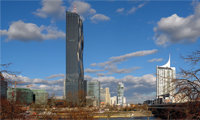 The DC Tower 1 is now open after three years of construction. With its height of 250 meters and 60 floors the DC Tower 1 is the tallest building in Austria. The DC Tower 1 is now open after three years of construction. With its height of 250 meters and 60 floors the DC Tower 1 is the tallest building in Austria.
The renowned French architect Dominique Perrault is responsible for the spectacular architecture. The appearance of the DC Tower 1 is mainly characterized by its extraordinary "folded" facade and slim structure that results from the height of 250m and a width of only average 28m and a length of 59m.
Architect Dominique Perrault comments the DC Tower 1: "In planning it was not primarily a matter of setting new record heights, but to create a well-designed building, which stands out with its sophisticated design and the high quality of the property. The height of the tower stems from the ambition to preserve the attractive aesthetics of a slender tower at the obstruction of the proposed cubature extent. With this first tower the city of Vienna has demonstrated that the punctual and controlled emergence of high-rises can participate in creating the city and produce contemporary, economical, high-energy performance mixed-use buildings adapted to metropolitan business requirements and lifestyles." |
 |
 |
  |
 Martin Luther King Library in Washington D.C., from Mies to Mecanoo Martin Luther King Library in Washington D.C., from Mies to Mecanoo |
 |
February 22, 2014
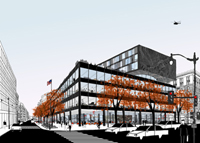 D.C. Mayor Vincent Gray announced the design team Mecanoo and Martinez + Johnson is chosen to revitalize the Martin Luther King Jr. Memorial Library. The city’s aim for their Central Public Library project is to deliver a next generation library building that embraces Washington DC’s contemporary culture and changing needs. The MLK Library will be an attractive catalyst for community activity. The MLK Library, completed in 1972, is designed by one of the great 20th Century architect Mies van der Rohe and honors the legacy of Dr. Martin Luther King Jr.. D.C. Mayor Vincent Gray announced the design team Mecanoo and Martinez + Johnson is chosen to revitalize the Martin Luther King Jr. Memorial Library. The city’s aim for their Central Public Library project is to deliver a next generation library building that embraces Washington DC’s contemporary culture and changing needs. The MLK Library will be an attractive catalyst for community activity. The MLK Library, completed in 1972, is designed by one of the great 20th Century architect Mies van der Rohe and honors the legacy of Dr. Martin Luther King Jr..
The potentially $150 million project will redesign the 250,000 square foot interior of the 1970s library to modernize the building. The MLK Library is the hub of the Public Library system in Washington, D.C. It's the only library designed by modernist Ludwig Mies van der Rohe, and opened three years after his death in 1972. The teams were asked to submit two ideas: what they would do if it was a straight library renovation, as well as possibilities for a mixed-use building with additional floors above the existing building. Mayor Vincent Gray: “This takes us to a new stage. I am excited about the "bold vision" for the renovated library.” |
 |
 |
  |
 The Brits Who Built the Modern World exhibition in London The Brits Who Built the Modern World exhibition in London |
 |
February 10, 2014
 In February 2014 the Royal Institute of British Architects (RIBA) will open a brand new gallery at its Art Deco headquarters in central London. The opening exhibition, The Brits Who Built the Modern World, will tell the story of how a single generation of exceptional architects – born within five years of each other in the 1930s – gave 21st Century British architecture an unrivalled reputation around the world. In February 2014 the Royal Institute of British Architects (RIBA) will open a brand new gallery at its Art Deco headquarters in central London. The opening exhibition, The Brits Who Built the Modern World, will tell the story of how a single generation of exceptional architects – born within five years of each other in the 1930s – gave 21st Century British architecture an unrivalled reputation around the world.
Norman Foster, Richard Rogers, Nicholas Grimshaw, Michael and Patty Hopkins and Terry Farrell have designed many of the world’s landmark buildings, from the Reichstag in Berlin to the Pompidou Centre in Paris and The Peak in Hong Kong. What unites these six architects is that they left European modernism behind and became protagonists of the next movement in architecture, known as ‘high-tech’ or ‘industrial style’. Their inspiration came from cars, Meccano and engineers. They replaced typically modernist concrete with steel skeletons and lightweight, ‘clip on’, prefabricated materials. It was a style that each of them developed individually, but which they all successfully exported, turning it and them into a global commodity.
The exhibition also explores the changing identity of cities internationally: landmark buildings were increasingly commissioned to ‘brand’ or regenerate a city and few architects were more popular for the role than the six featured in the exhibition. |
 |
 |
  |
 Ardmore Residence in Singapore by Ben van Berkel / UNStudio Ardmore Residence in Singapore by Ben van Berkel / UNStudio |
 |
November 18, 2013
 The Ardmore Residence at 7 Ardmore Park in Singapore is located in a prime location close to the Orchard Road luxury shopping district and enjoys both expansive views of the panoramic cityscape of Singapore City and the vast green areas of its immediate western and eastern surroundings. The Ardmore Residence at 7 Ardmore Park in Singapore is located in a prime location close to the Orchard Road luxury shopping district and enjoys both expansive views of the panoramic cityscape of Singapore City and the vast green areas of its immediate western and eastern surroundings.
The primary concept for the design of the 36 storey, 17.178 m² residential tower is a multi-layered architectural response to the natural landscape inherent to the ‘Garden City’ of Singapore. This landscape concept is integrated into the design by means of four large details: the articulation of the facade, which through its detailing creates various organic textures and patterns; expansive views across the city made possible by large glazed areas, bay windows and double-height balconies; the interior ‘living landscape’ concept adopted for the design of the two apartment types and the introduction of transparency and connectivity to the ground level gardens by means of a raised structure supported by an open framework.
Ben van Berkel: “The highly textural façade of the Ardmore Residence works in unison with the organisation of the individual apartments, affording both extensive daylight to the unique residential spaces and panoramic views over the city of Singapore. The façade further generates a unique reading of the building in the neighborhood, with its layered contours extending the appearance beyond four façades and providing a variety of profiles and perspectives.” |
 |
 |
  |
 Vendsyssel Theatre and Experience Centre in Hjørring, Denmark Vendsyssel Theatre and Experience Centre in Hjørring, Denmark |
 |
November 17, 2013
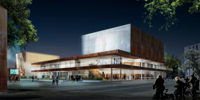 As part of a team, schmidt hammer lassen architects has won the competition to design Vendsyssel Theatre and Experience Centre in Hjørring, Denmark. With this 4,200 square metre building, Hjørring gains a vibrant cultural hub in which to feature the city’s various cultural activities. The winning design was submitted by a team including schmidt hammer lassen architects, Arkitektfirmaet Finn Østergaard, Brix & Kamp, ALECTIA, Gade & Mortensen Akustik, AIX Arkitekter, Filippa Berglund scenography, and LIW Planning. As part of a team, schmidt hammer lassen architects has won the competition to design Vendsyssel Theatre and Experience Centre in Hjørring, Denmark. With this 4,200 square metre building, Hjørring gains a vibrant cultural hub in which to feature the city’s various cultural activities. The winning design was submitted by a team including schmidt hammer lassen architects, Arkitektfirmaet Finn Østergaard, Brix & Kamp, ALECTIA, Gade & Mortensen Akustik, AIX Arkitekter, Filippa Berglund scenography, and LIW Planning.
”We have designed a project where the architectural and functional concept has five main themes: integration in the city, openness, functionality, flexibility and materiality,” explained John Foldbjerg Lassen, Founding Partner at schmidt hammer lassen architects. “We have designed a significant building which relates to its function in a pragmatic way. It invites both active use and quiet breaks. It is a building which radiates its cultural meaning – it dares to be different, without stealing the focus from the existing qualities in the city.”
The Theatre and Experience Centre consists of a complex of buildings – a city within the city. Its characteristic corten steel façade, with its warm rusty red colours, corresponds well with the area’s existing plaster and brick façades; thereby creating an aesthetic whole between the city, the front plaza and the theatre building. |
 |
 |
  |
 The Couch, Club House for Amsterdam’s Tennisclub IJburg by MVRDV The Couch, Club House for Amsterdam’s Tennisclub IJburg by MVRDV |
 |
November 15, 2013
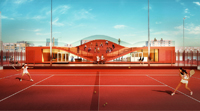 Tennisclub IJburg and MVRDV announce that permission has been granted to start construction of The Couch, a new club house for the young tennis club, which was founded in 2010 on a new artificial island in the east of Amsterdam. The roof of the 322m2 club house, designed by MVRDV, is folded upwards and downwards to act as an informal spectator tribune for the club. This ‘Couch’ can seat up to 200 spectators. Construction will start this month, with completion expected before summer 2014. Tennisclub IJburg and MVRDV announce that permission has been granted to start construction of The Couch, a new club house for the young tennis club, which was founded in 2010 on a new artificial island in the east of Amsterdam. The roof of the 322m2 club house, designed by MVRDV, is folded upwards and downwards to act as an informal spectator tribune for the club. This ‘Couch’ can seat up to 200 spectators. Construction will start this month, with completion expected before summer 2014.
The club house is a long open volume with services on either side such as dressing rooms, a kitchen, storage and toilets. The main space is multifunctional, so it can be used for the club’s many events. The wide glass front to the north side allows extensive natural lighting and provides a view out over the waters of the IJ-lake.
The tennis club, currently with 1100 members, has 10 clay courts and a tennis school. The new club house will be the centre of the club’s activities.
MVRDV developed the clubhouse together with co-architect Studio Bouwkunde and structural engineer ABT. Contractor Ballast Nedam Bouw will realise the building, which will be MVRDV’s eighth building in Amsterdam. |
 |
 |
  |
 Kutaisi International Airport, Georgia, by UNStudio Kutaisi International Airport, Georgia, by UNStudio |
 |
November 9, 2013
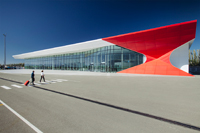 UNStudio's recently completed Kutaisi International Airport, Georgia, serves domestic and international flights for use by tourists, national politicians and international diplomats. The airport is destined to become a central hub, with up to one million travellers targeted in 2014-2015. UNStudio's recently completed Kutaisi International Airport, Georgia, serves domestic and international flights for use by tourists, national politicians and international diplomats. The airport is destined to become a central hub, with up to one million travellers targeted in 2014-2015.
The architecture of the terminal refers to a gateway, in which a clear structural layout creates an all-encompassing and protective volume. Both the exterior corner detail – which functions as a crossing-point and point of recognition - and the so called 'umbrella' structure within the terminal building – which operates as a roundabout for passenger flows - operate as the two main architectural details around which all of the airport functions are organised.
The umbrella further guarantees views from the terminal plaza to the apron and to the Caucasus on the horizon and vice versa. The central point in the umbrella is an exterior patio which is used for departing passengers. The transparent space around this central area is designed to ensure that flows of passengers are smooth and that departure and arrival flows do not coincide.
The project was designed and constructed in two years, under lead consultancy of UNStudio, with the airport already having begun operations by September 2012. Both design and construction saw the involvement of numerous local and international companies, with openness and knowledge sharing proving to be essential to fulfilling the tight schedule. |
 |
 |
  |
 International School Ikast-Brande by C.F. Møller International School Ikast-Brande by C.F. Møller |
 |
November 7, 2013
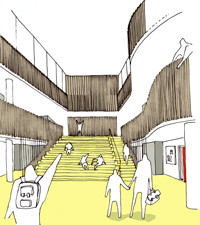 The International School in Ikast-Brande (ISIB) has inaugurated a new 2,600 m2 building, which includes a school, after-school and kindergarten. C.F. Møller has designed the complex like a small town with individual volumes located around a square and winding streets. The International School in Ikast-Brande (ISIB) has inaugurated a new 2,600 m2 building, which includes a school, after-school and kindergarten. C.F. Møller has designed the complex like a small town with individual volumes located around a square and winding streets.
The International School, which only teaches in English, is so popular that it has now been expanded with new facilities. 130 students are ready for the new school year at the International School, which with the new building can accommodate up to 200 students.
Inside the two-storey building of light brickwork, there are omnipresent views to the green landscape and a pleasant natural light influx, creating a bright and friendly environment for the children and staff. The window openings are placed in a pixelated and lively pattern that allows natural light deep into the rooms - and opens the views for big and small alike.
Centrally located in the school complex is a long superstructure with a curved form. The superstructure contains ventilation systems and skylights, and is clad in translucent facade panels and double-glazed windows, respectively. The curved form is continued in the sinuous balconies framing the central “square”, which acts as a multi-purpose space for drama, music, dining and lectures as well as the main social space of the school.
The new school is located as an addition to an existing educational complex. The surrounding park-like landscape is partially designed as shady woodlands, with embedded playgrounds and playing fields, and a smaller screened area for the kindergarten. |
 |
 |
  |
 Typhoon Haiyan Typhoon Haiyan |
 |
|
 |
 |
  |
 schmidt hammer lassen architects' pavilions for the Shanghai West Bund Biennial open schmidt hammer lassen architects' pavilions for the Shanghai West Bund Biennial open |
 |
October 27, 2013
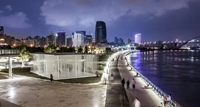 The Shanghai West Bund Biennial for Architecture and Contemporary Art, China, officially opened this week, and it has pavilions designed by Danish schmidt hammer lassen architects. Based on the themes Reflecta and Fabrica, the biennial showcases contemporary architecture, art and theatre. schmidt hammer lassen architects were invited to design pavilions alongside some of China’s most respected architects and selected international architectural practices, including the 2012 Pritzker Prize winner Wang Shu. The Shanghai West Bund Biennial for Architecture and Contemporary Art, China, officially opened this week, and it has pavilions designed by Danish schmidt hammer lassen architects. Based on the themes Reflecta and Fabrica, the biennial showcases contemporary architecture, art and theatre. schmidt hammer lassen architects were invited to design pavilions alongside some of China’s most respected architects and selected international architectural practices, including the 2012 Pritzker Prize winner Wang Shu.
“The Cloud pavilion is the quintessence of lightness, immateriality and fuzziness,” explained Kristian Lars Ahlmark, partner at schmidt hammer lassen architects. “By hanging hundreds of white ropes from the pavilion’s ceiling, an effect is created where The Cloud is always changing. Visitors moving or a light breeze creates a subtle movement of the ropes, underlining the organic nature of the installation and the immateriality of the space. In Chinese culture, a cloud is an important symbol and a sign of good fortune.”
schmidt hammer lassen architects has just relocated to larger office facilities in Shanghai and has experienced an increasing success in Asia. Current projects include Green Valley, a sustainable regeneration project on the former Shanghai World Expo site, a headquarters for the Ningbo Daily Media Group and a redevelopment of a former coal storage building, which will become a new art gallery and museum for an international art dealer. |
 |
 |
  |
 Another gas plant in Denmark by C.F. Møller Another gas plant in Denmark by C.F. Møller |
 |
October 10, 2013
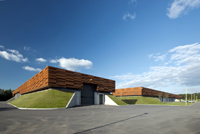 The new gas plant has just recently been officially opened by a posse of dignitaries, including Denmark's Minister for Climate, Energy and Building, Martin Lidegaard. C.F. Møller has designed the plant as an architectural feature in the open landscape. The form of the buildings was also specially chosen in order to achieve optimum safety conditions at the plant. The new gas plant has just recently been officially opened by a posse of dignitaries, including Denmark's Minister for Climate, Energy and Building, Martin Lidegaard. C.F. Møller has designed the plant as an architectural feature in the open landscape. The form of the buildings was also specially chosen in order to achieve optimum safety conditions at the plant.
"We began by asking ourselves a question: Can we push the boundaries for how we see technical plants? Can we create a gas plant in dialogue with the landscape and yet focus on the energy supply infrastructure, on which we all depend?" says Julian Weyer, architect and partner at C.F. Møller.
A technical site is normally swaddled in greenery to prevent it from becoming an eyesore in the natural environment. And here the opposite is true.
The new technical plant emerges from the landscape as a grassy embankment. The remainder of the building appears almost to hover over the mound and is clad with rust-coloured Corten steel plating.
Natural gas supplies from the North Sea are dwindling. To ensure a regular and safe energy supply in the future, Denmark has to be able to receive gas from continental Europe. Energinet.dk has therefore constructed 94 kilometres of "gas motorway" from Egtved to Germany. This extension of the fossil gas system may well be a decisive step on the road to a green energy system, which is projected by 2050 to use only renewable energy. |
 |
 |
  |
 New landmark in Copenhagen district inaugurated New landmark in Copenhagen district inaugurated |
 |
October 3, 2010
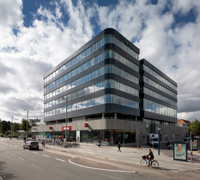 The Danish engineering company MOE opened the doors to their new head office in Buddinge near Copenhagen, Denmark. schmidt hammer lassen architects has designed the 7,500-square-metre building organized as one long spiral staircase. The result is a dynamic office environment that creates synergy and encourages movement. The Danish engineering company MOE opened the doors to their new head office in Buddinge near Copenhagen, Denmark. schmidt hammer lassen architects has designed the 7,500-square-metre building organized as one long spiral staircase. The result is a dynamic office environment that creates synergy and encourages movement.
Instead of designing a classic atrium building, schmidt hammer lassen architects proposed a Yin Yang shape, where two building volumes are staggered and at the same time interlocked. The idea of the building as an atrium with an active staircase was taken to the extreme. The building itself became one long staircase where the working areas are placed on what look like oversized landings.
“The result is an office building with displaced levels linked by two staircases, where you use the staircase to move from one floor to the next without landings. Instead of having four to five levels we end up having nine levels but with a leap of half a storey at a time,” states Kristian Lars Ahlmark, partner at schmidt hammer lassen architects.
The office building is pre-certified as DGNB silver and meets the requirements of the Danish 2015 energy classification. The energy-optimizing measures in the building include high-insolating windows, heat recovery and 300 square metres of solar cell panel on the roof. The DGNB certification also includes measures regarding accessibility and bicycle parking. |
 |
 |
  |
 The SSE Hydro in Glasgow, Scotland, by Foster + Partners The SSE Hydro in Glasgow, Scotland, by Foster + Partners |
 |
September 28, 2013
 The SSE Hydro, Scotland’s largest purpose-built public event arena, will open to the public with a concert by Rod Stewart on 30 September. Its free spanning roof of 120 metres, large enough to encompass Glasgow's Queen Street railway station, encloses a highly flexible amphitheatre for an audience of up to 13,000. Externally, the arena is wrapped in lightweight translucent panels taking the excitement of the concert to the city – the whole building can be illuminated to glow as a beacon of colour on the waterfront. The SSE Hydro, Scotland’s largest purpose-built public event arena, will open to the public with a concert by Rod Stewart on 30 September. Its free spanning roof of 120 metres, large enough to encompass Glasgow's Queen Street railway station, encloses a highly flexible amphitheatre for an audience of up to 13,000. Externally, the arena is wrapped in lightweight translucent panels taking the excitement of the concert to the city – the whole building can be illuminated to glow as a beacon of colour on the waterfront.
The new building joins the landmark Clyde Auditorium on the northern bank of the River Clyde within Glasgow’s former docks, and has been designed from the inside-out to ensure excellent views of the stage and high quality acoustics. The flexible arena has capacity for 12,000 seated or 13,000 with standing in the performance bowl, and includes 11 hospitality boxes, two large VIP suites and a club seating level. As well as accommodating a wide variety of concerts and stage sets, the SSE Hydro will also be configured as a sporting venue to host netball and gymnastics during Glasgow’s 2014 Commonwealth Games.
Designed to reduce energy demands, the building combines natural and mechanical ventilation – fresh air is drawn into the building above the entrances, and vented at a high level. The SSE Hydro is integrated with the district-wide public transport and the surrounding landscaping provides a valuable new civic amenity – the building is set back from the river to frame a new public space between the arena and conference centre. In addition, a low concrete bank curves around the base of the arena, concealing catering and support spaces and providing an attractive green, landscaped plinth. |
 |
 |
  |
 Archive Evangelical Lutheran State Church of Bavaria in Nuremberg by gmp Archive Evangelical Lutheran State Church of Bavaria in Nuremberg by gmp |
 |
September 25, 2013
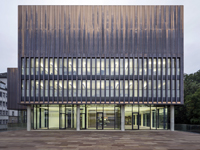 The Evangelical Lutheran State Church of Bavaria has inaugurated its new archive in Nuremberg. The new building, which was designed by architects von Gerkan, Marg and Partners (gmp), took three years to build and is located on a former factory site in the direct vicinity of the existing main building. With 34 kilometres of shelving, the State Church archive now has more than twice the storage space compared to previously and, in addition, accommodates a restoration workshop and enough space for visitor rooms. In the “Memory of Evangelical Bavaria”, the Church is archiving – amongst many other original documents – letters by Martin Luther and documents by popes and emperors, as well as numerous historically important books and paintings. The State Church archive has been designed to include passive air conditioning of the archives. The Evangelical Lutheran State Church of Bavaria has inaugurated its new archive in Nuremberg. The new building, which was designed by architects von Gerkan, Marg and Partners (gmp), took three years to build and is located on a former factory site in the direct vicinity of the existing main building. With 34 kilometres of shelving, the State Church archive now has more than twice the storage space compared to previously and, in addition, accommodates a restoration workshop and enough space for visitor rooms. In the “Memory of Evangelical Bavaria”, the Church is archiving – amongst many other original documents – letters by Martin Luther and documents by popes and emperors, as well as numerous historically important books and paintings. The State Church archive has been designed to include passive air conditioning of the archives.
The new building consists of two intersecting solid cubes which seem to float above a transparent receding ground floor. The structure rises from a basement floor about one metre high along the road, which develops into full storey height along the downward slope towards the south, including a large terrace which offers views of the Wöhrder See lake. |
 |
 |
  |
 GIS Station by C.F. Møller GIS Station by C.F. Møller |
 |
September 21, 2013
 C. F. Møller has created a new design concept for switchgear stations for the Danish energy infrastructure operator Energinet.dk. The first 400 kW station is now ready for operation. C. F. Møller has created a new design concept for switchgear stations for the Danish energy infrastructure operator Energinet.dk. The first 400 kW station is now ready for operation.
The Danish Parliament wishes to upgrade the visual appearance of the Danish power grid. As a result, Energinet.dk has decided not to construct a new large open-air switchgear station in Vejen, Jutland, but instead build a gas-insulated switchgear station - also called a GIS station. The idea has been to give the technical enclosure of the station, placed in the open landscape, a distinct architectonic profile, and at the same time maximize the future flexibility.
The new Station Revsing is one of the nerve centres in the Danish power grid, through which increasing volumes of sustainable energy – mostly wind power – will be transported. The GIS station is an important part of 175 kilometres of new 400 kW high voltage cable up through central Jutland. The link has been built to upgrade the power grid and to ensure that wind power from Danish wind farms is transported to the areas where it is needed.
The station has been designed as a series of modules. Arranged in series, the modules create a transparent gill-like envelope with triangular openings, letting ample daylight into the interior and allowing glimpses of the GIS units at the heart of the building. |
 |
 |
  |
 Pier 6 of Brooklyn Bridge Park by BIG Bjarke Ingels Pier 6 of Brooklyn Bridge Park by BIG Bjarke Ingels |
 |
September 20, 2013
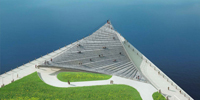 BIG MVVA have unveiled their design for Pier 6 of Brooklyn Bridge Park, a public space and pavilion in form of a massive wood-clad triangular viewing platform for events and skyline gazing. BIG MVVA have unveiled their design for Pier 6 of Brooklyn Bridge Park, a public space and pavilion in form of a massive wood-clad triangular viewing platform for events and skyline gazing.
BIG’s proposal for Brooklyn Bridge Park, a project that has revitalized the New York City waterfront, consists of a 6,000 ft2 (560 m2) triangular cross-laminated timber structure, serving both as pavilion and platform. Sloping upwards 17.5 feet (5.3 m) in height from the foot of the large gathering lawn, the platform provides magnificent views of the surrounding harbor, the Statue of Liberty, the Manhattan skyline, and the Brooklyn Bridge. In conjunction with the adjacent greenery, Pier 6 will be dominated by a flower field and treed areas giving the area seasonal displays of color.
The surface of terraced stairs, softly illuminated, will allow for large and small events and is fully ADA accessible. The pavilion, supported by thin steel columns, is brightly lit with uplights and provides shade, shelter and space for indoor activities. Movable site furniture underneath the platform will accommodate a variety of programs, from food carts and picnicking to community events and small performances.
Bjarke Ingels comments: “The Mantaray is a small public platform at the end of the pier - equally accessible above and below. Its namesake organic slopes and curves have been shaped by concerns for accessibility, safety, shelter, structure - like a manmade reef evolved to accommodate human life.” |
 |
 |
  |
 Nice Eco Stadium in Côte d'Azur by Jean-Michel Wilmotte Nice Eco Stadium in Côte d'Azur by Jean-Michel Wilmotte |
 |
September 19, 2013
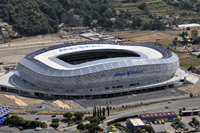 The Allianz Riviera is the first of the new stadiums that will be built for UEFA Euro 2016. Designed as a large multi-purpose facility with 45,000 seats, it will be the first landmark structure of – and the showcase for – the Var Eco Valley, a vast urban and regional development programme that has been declared project of national interest. The Allianz Riviera is the first of the new stadiums that will be built for UEFA Euro 2016. Designed as a large multi-purpose facility with 45,000 seats, it will be the first landmark structure of – and the showcase for – the Var Eco Valley, a vast urban and regional development programme that has been declared project of national interest.
“The Allianz Riviera has received very strong backing from the city goverment who wanted an exemplary project in terms of sustainable development,” confirms Xavier Lortat-Jacob, chief executive of Nice Eco Stadium, the VINCI Concessions-led company that holds the partnership contract and will become the stadium’s operator.
“For us, it wasn’t a matter of simply ‘greenwashing’ the project. We structured the design approach around environmental issues, and the way we articulated that priority has been a keystone of our success.” The project has been developed by architect Jean-Michel Wilmotte. It combines bold innovation and eco-design. Examples include the stadium’s wooden lattice structure, the natural ventilation system that leverages the dominant winds of the Var plain, and the photovoltaic panels that make it energy positive.
The stadium will be used mainly by OGC Nice, the city’s resident football club. Currently located in Paris, France’s national sports museum will be moved to the new facility. 5,000 sq. metres of space will be dedicated to the new museum. |
 |
 |
  |
 Werkraum Bregenzerwald by Peter Zumthor Werkraum Bregenzerwald by Peter Zumthor |
 |
August 14, 2013
 The Werkraum Bregenzerwald in Andelsbuch, in the Austrian state of Vorarlberg, designed by Peter Zumthor, is now open. The timber and concrete building combines a contemporary, minimalist design with the area's centuries-old local traditions. The relatively modestly-shaped low structure features a striking, large wooden roof and generous, glass-enclosed exhibition spaces. Equipped with offices, seminar and meeting rooms and display areas, it was designed in painstaking detail to provide a much needed space for the association's activities and also to act as a platform for promoting the work and value of local crafts. The Werkraum Bregenzerwald in Andelsbuch, in the Austrian state of Vorarlberg, designed by Peter Zumthor, is now open. The timber and concrete building combines a contemporary, minimalist design with the area's centuries-old local traditions. The relatively modestly-shaped low structure features a striking, large wooden roof and generous, glass-enclosed exhibition spaces. Equipped with offices, seminar and meeting rooms and display areas, it was designed in painstaking detail to provide a much needed space for the association's activities and also to act as a platform for promoting the work and value of local crafts.
"The building was conceived as a showcase and a meeting point for the crafts", says Renate Breuss. "The result reflects our values and suits our purpose very well - to be a meeting point for the people of the valley and for people from abroad, for crafts and culture. Zumthor brings together the rural context with the world, the local qualities and spirits with the international." |
 |
 |
  |
 gmp exhibition in Beijing gmp exhibition in Beijing |
 |
August 9, 2013
 The international touring exhibition, “Designing in Dialogue. The architecture of von Gerkan, Marg and Partners”, is hosted by the Chinese National Museum, Beijing, which was converted and extended by gmp - von Gerkan, Marg and Partners in 2011. The international touring exhibition, “Designing in Dialogue. The architecture of von Gerkan, Marg and Partners”, is hosted by the Chinese National Museum, Beijing, which was converted and extended by gmp - von Gerkan, Marg and Partners in 2011.
For this purpose, gmp is cooperating with the Chinese architectural magazine UED and Verseidag.
The opening ceremony on 8th of August, which was followed by a symposium, was attended by Meinhard von Gerkan, his partners Nikolaus Goetze, Stephan Schütz and Wu Wei as well as personalities from the Chinese architectural scene and other guests.
The exhibition runs until 25th of August. |
 |
 |
  |
 Thames Hub. Foster + Partners propose the new London Airport Thames Hub. Foster + Partners propose the new London Airport |
 |
July 22, 2013
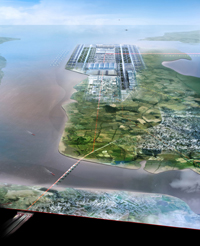 Foster + Partners has formally submitted plans for a new four-runway hub airport on the Isle of Grain in the Thames Estuary to the government’s Airports Commission. The Thames Hub Airport proposal has been advocated by Mayor of London, Boris Johnson and has been developed with the support of a number of leading organisations. Foster + Partners has formally submitted plans for a new four-runway hub airport on the Isle of Grain in the Thames Estuary to the government’s Airports Commission. The Thames Hub Airport proposal has been advocated by Mayor of London, Boris Johnson and has been developed with the support of a number of leading organisations.
The new hub airport can open in 2029 with capacity for 110 million passengers per year at a cost of £24bn, and has the flexibility to grow to 150 million passengers per year and beyond. The majority of flights can approach the airport over water, relieving five million Londoners of the noise, pollution and dangers of flight paths over the capital. Unlike Heathrow, the airport can operate 24-hours a day. The airport has a viable private funding model, which ensures that it will be financially sustainable and can achieve a fair price for passengers and airlines.
The proposed site capitalises on the eastward thrust of London’s development and existing investments in high-speed rail, reducing the need for additional surface access by connecting with High Speed 1, High Speed 2 and Crossrail. Journey times by rail from St Pancras would be just 26 minutes, or 40 minutes by rail from Waterloo.
The Thames Hub Airport can open within 16 years. A third Heathrow runway would take the same time to build and would be full within a decade of opening, necessitating a fourth runway. |
 |
 |
  |
 Yongjia World Trade Centre in Wenzhou by UNStudio Yongjia World Trade Centre in Wenzhou by UNStudio |
 |
July 20, 2013
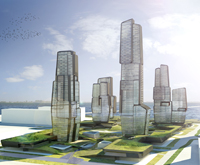 UNStudio's design has been selected as the winning entry in the competition for the Yongjia World Trade Centre in Wenzhou. UNStudio's design has been selected as the winning entry in the competition for the Yongjia World Trade Centre in Wenzhou.
The Yongjia World Trade Centre, located in the new riverside city of Wenzhou, presents a functional shift of the WTC area from a business and financial district to a mixed-use development incorporating cultural and recreational facilities and a high percentage of residential properties.
The notion of precious objects on a tray drives the main design concept, where the continuous podium landscape occupies the entire site and serves as a tray-like, green plain for the towers. On the tower scale ‘frames’ underline the concept of neighbourhoods in the sky which create unique locations with distinct identities. Where these frames overlap the so-called ‘Eyes’ are located. These are communally used spaces such as sky gardens and lounges, or social gathering places for office areas that afford the best views towards the river and Wenzhou city centre. |
 |
 |
  |
 Urban Hybrid in Emmen, Switzerland, by MVRDV Urban Hybrid in Emmen, Switzerland, by MVRDV |
 |
July 19, 2013
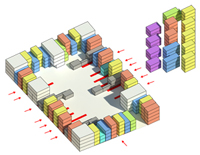 The city of Emmen has announced that investment corporation Senn BPM AG together with MVRDV are the winners of the Feldbreite competition for a housing block with 95 homes of 16 different types. The urban hybrid development combines characteristics of city dwelling – central location, privacy, underground parking – with the characteristics of suburban life: gardens, multilevel living and a neighbourhood community. Construction is envisioned to start in 2015. The city of Emmen has announced that investment corporation Senn BPM AG together with MVRDV are the winners of the Feldbreite competition for a housing block with 95 homes of 16 different types. The urban hybrid development combines characteristics of city dwelling – central location, privacy, underground parking – with the characteristics of suburban life: gardens, multilevel living and a neighbourhood community. Construction is envisioned to start in 2015.
Instead of the housing block asked for by the brief, MVRDV created a mixed urban block with small apartment buildings at the corners, townhouses along the streets and garden and patio houses inside the block. The 16 different housing types, which vary in size from 30 to 130 m2 and from one to four floors, will naturally attract a mixed group of inhabitants, an important factor in creating a vivid urban environment.
Each house or apartment will have its own façade colour, emphasizing its individual ownership. A pastel range of colour was chosen based on the specific colours traditionally found in historic Swiss town centres in the Lucerne area, such as Beromünster.
An important aspect of the project is the high quality of construction in combination with relatively low prices. Clients will be able to buy a more or less finished house – comparable to the basic model of a new car – with options leading up to almost full fit and finish possible. Home owners with little money can therefore delay investment, or do the work themselves, and still live in a high quality, new build home. |
 |
 |
  |
 A new super hospital in Køge, Denmark, by C.F. Møller A new super hospital in Køge, Denmark, by C.F. Møller |
 |
June 10, 2013
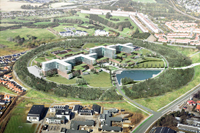 Rådgivergruppen USK, headed by C.F. Møller, Alectia and Rambøll, has been named as the winner of the competition to build the new Køge University Hospital, with a budget of DKK 4 billion (approx. € 530 million). Rådgivergruppen USK, headed by C.F. Møller, Alectia and Rambøll, has been named as the winner of the competition to build the new Køge University Hospital, with a budget of DKK 4 billion (approx. € 530 million).
Køge University Hospital (USK) is an expansion of the existing Køge Hospital, which will be increased threefold to a total area of 177,000 m2. This is a visionary project in terms of both architecture and functionality. The hospital's various functions can be structured on a highly flexible basis, with good opportunities to support Region Zealand's vision of holistic patient care.
"The design is based on the existing hospital's qualities and potential, and presents a cohesive sustainable, architectural, functional and technical vision of a clear, compact, green and inviting hospital complex," says Klavs Hyttel, architect and partner in C.F. Møller.
Køge Hospital is located in a striking, ring-formed forest area. It was built by C.F. Møller in 1983-88, and the facility comprises a low, densely built hospital complex with a single overall traffic system and pleasant and welcoming courtyard gardens and day rooms. |
 |
 |
  |
 Gebr. Heinemann headquarters in Hamburg by gmp Gebr. Heinemann headquarters in Hamburg by gmp |
 |
June 3, 2013
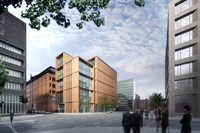 The architects von Gerkan, Marg and Partners (gmp) have won first prize in the competition for the extension of Gebr. Heinemann Headquarters in Hamburg’s HafenCity. The new building designed for the Hamburg-based, tradition-rich trading company impressed the jury as “an independent urban-planning and architectural contribution characterized by timeless, harmoniously self-contained architecture.” Gebr. Heinemann, originally founded as a ship supplier in Hamburg’s Speicherstadt district in 1879 and now a well-known, modern Hansea- tic trading house on the international travel market, invited eight architectural firms to participate in the competition. The architects von Gerkan, Marg and Partners (gmp) have won first prize in the competition for the extension of Gebr. Heinemann Headquarters in Hamburg’s HafenCity. The new building designed for the Hamburg-based, tradition-rich trading company impressed the jury as “an independent urban-planning and architectural contribution characterized by timeless, harmoniously self-contained architecture.” Gebr. Heinemann, originally founded as a ship supplier in Hamburg’s Speicherstadt district in 1879 and now a well-known, modern Hansea- tic trading house on the international travel market, invited eight architectural firms to participate in the competition.
The task was to extend the two existing warehouse buildings between the Magdeburg Harbor and Shanghai- allee to create an “ensemble of three striking blocks that form a harmonious triad representing the 19th, 20th, and 21st centuries.” The new structure directly adjacent to the headquarters and including underground parking, six floors of offices, and two recessed floors, will be built in line with the “Sustainable Construction in HafenCity” gold standard. |
 |
 |
  |
 Correctional facility in Greenland by schmidt hammer lassen and Friis & Moltke Correctional facility in Greenland by schmidt hammer lassen and Friis & Moltke |
 |
May 17, 2013
 As part of a Danish design team, schmidt hammer lassen architects has won the competition to design the correctional facility Ny Anstalt in Nuuk, the capital of Greenland. The winning design for the 8,000 square metre facility was submitted by a team including Rambøll as full service contractor, architects Friis & Moltke and landscape architects Møller & Grønborg. Ny Anstalt is the first such facility in Greenland. As part of a Danish design team, schmidt hammer lassen architects has won the competition to design the correctional facility Ny Anstalt in Nuuk, the capital of Greenland. The winning design for the 8,000 square metre facility was submitted by a team including Rambøll as full service contractor, architects Friis & Moltke and landscape architects Møller & Grønborg. Ny Anstalt is the first such facility in Greenland.
The contrast between beauty and roughness is a guiding theme for the project. Openness, light, views, security and flexibility are the leading values behind the design.
“We have designed a project which incorporates the contrast between the rough and the beautiful. Our project matches the unique and beautiful surroundings and supports the focus of the Danish Prison and Probation Service on the balance between punishment and rehabilitation. The whole idea behind the project is to add qualities to the complex that will enhance rehabilitation and diminish physical and psychological violence,” explained Morten Schmidt, Founding Partner at schmidt hammer lassen architects. |
 |
 |
  |
 Harpa in Reykjavik, Iceland, wins Mies van der Rohe Award 2013 Harpa in Reykjavik, Iceland, wins Mies van der Rohe Award 2013 |
 |
May 2, 2013
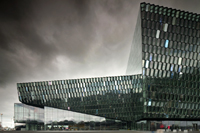 Harpa, the Reykjavik Concert Hall and Conference Centre in Iceland, is the winner of the 2013 European Union Prize for Contemporary Architecture - Mies van der Rohe Award. Designed by Henning Larsen Architects, Batteríið Architects and Studio Olafur Eliasson, the building has helped to transform and revitalise Reykjavik harbour and brought the city and harbour district closer together. The 'Emerging Architect Special Mention' award goes to María Langarita and Víctor Navarro for the Nave de Música Matadero (Red Bull Music Academy) in Madrid, Spain. The award ceremony will take place on 7 June at the Mies van der Rohe Pavilion in Barcelona, coinciding with the celebration of the 25th anniversary of the prize. Harpa, the Reykjavik Concert Hall and Conference Centre in Iceland, is the winner of the 2013 European Union Prize for Contemporary Architecture - Mies van der Rohe Award. Designed by Henning Larsen Architects, Batteríið Architects and Studio Olafur Eliasson, the building has helped to transform and revitalise Reykjavik harbour and brought the city and harbour district closer together. The 'Emerging Architect Special Mention' award goes to María Langarita and Víctor Navarro for the Nave de Música Matadero (Red Bull Music Academy) in Madrid, Spain. The award ceremony will take place on 7 June at the Mies van der Rohe Pavilion in Barcelona, coinciding with the celebration of the 25th anniversary of the prize.
Harpa's crystalline structure was inspired by Icelandic landscapes and traditions. Its dramatic design captures and reflects the light of the city, ocean and sky to thrilling effect.
Wiel Arets, Chair of the Jury, said: "Harpa has captured the myth of a nation – Iceland – that has consciously acted in favour of a hybrid-cultural building during the middle of the ongoing Great Recession. The iconic and transparent porous 'quasi brick' appears as an ever-changing play of coloured light, promoting a dialogue between the city of Reykjavik and the building's interior life. By giving an identity to a society long known for its sagas, through an interdisciplinary collaboration between Henning Larsen Architects and artist Olafur Eliasson, this project is an important message to the world and to the Icelandic people, fulfilling their long expected dream." |
 |
 |
  |
 Queen Alia International Airport in Amman, Jordan, by Foster + Partners Queen Alia International Airport in Amman, Jordan, by Foster + Partners |
 |
April 3, 2013
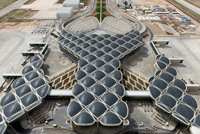 The new Queen Alia International Airport, the spectacular new gateway to Amman, is now open. The airport has a highly efficient passive design, which has been inspired by local traditions, and is based on a flexible modular solution that allows for future expansion – the new building secures the city’s position as the main hub for the Levant region and allows the airport to grow by 6 per cent per annum for the next twenty-five years, increasing capacity from 3.5 million to 12 million passengers per annum by 2030. The new Queen Alia International Airport, the spectacular new gateway to Amman, is now open. The airport has a highly efficient passive design, which has been inspired by local traditions, and is based on a flexible modular solution that allows for future expansion – the new building secures the city’s position as the main hub for the Levant region and allows the airport to grow by 6 per cent per annum for the next twenty-five years, increasing capacity from 3.5 million to 12 million passengers per annum by 2030.
Mouzhan Majidi - Chief Executive, Foster + Partners - said: “Queen Alia International Airport has been an extraordinary project – it has transformed Amman into a niche hub, while offering critical growth for the wider economy through regional links. The new terminal building is energy efficient, will accommodate phased expansion and provides a dynamic symbol for Jordan. Our early involvement from the conceptual design stage, supporting the selection of operators, and through detailed design and work on site has involved many of our specialist in-house teams, from architects to climate analysts, space planners and geometry specialists. It has been a pleasure to work with our Jordanian colleagues and the team at AIG, and it is great to see the results of this work come to life today.” |
 |
 |
  |
 Windconvertor EWICON revealed: wind’mill’ without moving blades Windconvertor EWICON revealed: wind’mill’ without moving blades |
 |
March 28, 2013
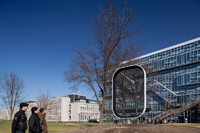 Is there such a thing as a wind mill without moving blades? Have a look for yourself! From Wednesday the 27th of March on, a scale model of the bladeless windmill can be viewed in front of the faculty of Electrical Engineering, Mathematics and Computer Science at Delft University of Technology. Mecanoo Architects designed the model EWICON (Electrostatic WIndenergy CONvertor) using technology developed by Delft University of Technology in a consortium with Wageningen UR and commercial companies in an economy-ecology-government partnership program context. The breakthrough wind convertor transforms wind energy into electricity without the use of moving mechanical parts. The result: greatly reduced wear and tear, lower maintenance costs, and zero noise pollution or shadow casting. The EWICON can be installed on land or sea, and can also be integrated on to the roof of a tall building. Is there such a thing as a wind mill without moving blades? Have a look for yourself! From Wednesday the 27th of March on, a scale model of the bladeless windmill can be viewed in front of the faculty of Electrical Engineering, Mathematics and Computer Science at Delft University of Technology. Mecanoo Architects designed the model EWICON (Electrostatic WIndenergy CONvertor) using technology developed by Delft University of Technology in a consortium with Wageningen UR and commercial companies in an economy-ecology-government partnership program context. The breakthrough wind convertor transforms wind energy into electricity without the use of moving mechanical parts. The result: greatly reduced wear and tear, lower maintenance costs, and zero noise pollution or shadow casting. The EWICON can be installed on land or sea, and can also be integrated on to the roof of a tall building.
The EWICON has an abstract appearance with a flowing steel frame in the shape of a squared -0- supporting a framework of horizontal steel tubes. Within this framework, electrically charged droplets are created and blown away by the wind. The movement of the droplets creates an electric current, which can be passed on to the grid. |
 |
 |
  |
 2013 Pritzker Prize goes to Toyo Ito 2013 Pritzker Prize goes to Toyo Ito |
 |
March 17, 2013
 Toyo Ito, a 71 year old architect whose architectural practice is based in Tokyo, Japan, will be the recipient of the 2013 Pritzker Architecture Prize. It was announced today by Thomas J. Pritzker, chairman of The Hyatt Foundation which sponsors the prize. Ito is the sixth Japanese architect to become a Pritzker Laureate – the first five being the late Kenzo Tange in 1987, Fumihiko Maki in 1993, Tadao Ando in 1995, and the team of Kazuyo Sejima and Ryue Nishizawa in 2010. Toyo Ito, a 71 year old architect whose architectural practice is based in Tokyo, Japan, will be the recipient of the 2013 Pritzker Architecture Prize. It was announced today by Thomas J. Pritzker, chairman of The Hyatt Foundation which sponsors the prize. Ito is the sixth Japanese architect to become a Pritzker Laureate – the first five being the late Kenzo Tange in 1987, Fumihiko Maki in 1993, Tadao Ando in 1995, and the team of Kazuyo Sejima and Ryue Nishizawa in 2010.
The formal ceremony for what has come to be known throughout the world as architecture’s highest honor will be at the John F. Kennedy Presidential Library and Museum in Boston, Massachusetts on Wednesday, May 29. This marks the first time the ceremony has been held in Boston, and the location has particular significance because it was designed by another Pritzker Laureate, Ieoh Ming Pei who received the prize in 1983.
Pritzker Prize jury chairman, The Lord Palumbo, spoke from his home in the United Kingdom, quoting from the jury citation that focuses on the reasons for this year’s choice: “Throughout his career, Toyo Ito has been able to produce a body of work that combines conceptual innovation with superbly executed buildings. Creating outstanding architecture for more than 40 years, he has successfully undertaken libraries, houses, parks, theaters, shops, office buildings and pavilions, each time seeking to extend the possibilities of architecture. A professional of unique talent, he is dedicated to the process of discovery that comes from seeing the opportunities that lie in each commission and each site.”
» Read more |
 |
 |
  |
 New Istanbul International Financial Center by HOK New Istanbul International Financial Center by HOK |
 |
March 15, 2013
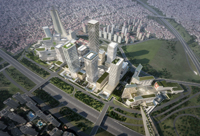 HOK developed the master plan for the Istanbul International Financial Center (IIFC) in Turkey, which is being built on a 170-acre site on the city's Asian side. HOK developed the master plan for the Istanbul International Financial Center (IIFC) in Turkey, which is being built on a 170-acre site on the city's Asian side.
The Turkish government's goal for the landmark IIFC project is to establish Istanbul as a global center for finance. The IIFC will house the head offices of the country’s financial market governing bodies, state-owned and private banks, and related businesses. It will include approximately 45 million square feet of office, residential, retail, conference, hotel and park space.
In addition to creating the master plan, architectural and landscape design standards, and sustainability guidelines, HOK currently is designing two of the IIFC's high-rise office towers.
HOK's master plan for the IIFC creates four distinct districts focusing on culture, commerce, civic functions and governance. Strategically located between the Ataşehir and Ümraniye districts, the site offers easy accessibility and views to the historic center of Istanbul.
Major infrastructure improvements include a transportation system featuring a new subway line and station as well as new infrastructure for sustainable power, water, data and security. These systems are integrated into a podium that provides a surface for a new urban park.
Turkish construction company Akdeniz Group has begun excavation work on the site, and the IIFC is scheduled for completion at the end of 2016. |
 |
 |
  |
 Cathedral of the Northern Lights by schmidt hammer lassen Cathedral of the Northern Lights by schmidt hammer lassen |
 |
February 18, 2013
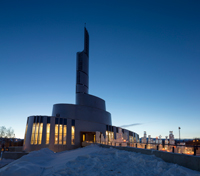 The Crown Princess of Norway, Mette-Marit, has just inaugurated the Cathedral of the Northern Lights situated in the Norwegian town of Alta approximately 500 km north of the Arctic Circle. Even before the inauguration, the 47-metre-high cathedral, designed by schmidt hammer lassen architects in cooperation with Link Arkitektur, was perceived as a symbol and an architectural landmark for the entire area. The Crown Princess of Norway, Mette-Marit, has just inaugurated the Cathedral of the Northern Lights situated in the Norwegian town of Alta approximately 500 km north of the Arctic Circle. Even before the inauguration, the 47-metre-high cathedral, designed by schmidt hammer lassen architects in cooperation with Link Arkitektur, was perceived as a symbol and an architectural landmark for the entire area.
In 2001, when the architecture competition for the Cathedral of the Northern Lights was arranged, the city council in Alta did not just want a new church: they wanted an architectural landmark that would underline Alta’s role as a public venue from which the natural phenomenon of the northern lights could be observed.
“The Cathedral of the Northern Lights is in its design a result of the surrounding nature and local culture. The building is a landmark, which through its architecture symbolizes the extraordinary natural phenomenon of the Arctic northern lights,” explains John F. Lassen, Founding Partner at schmidt hammer lassen architects. He continues: “The cathedral reflects, both literally and metaphorically, the northern lights: ethereal, transient, poetic and beautiful. It appears as a solitary sculpture in interaction with the spectacular nature.” |
 |
 |
  |
 Serpentine Gallery Pavilion 2013 will be designed by Sou Fujimoto Serpentine Gallery Pavilion 2013 will be designed by Sou Fujimoto |
 |
February 17, 2013
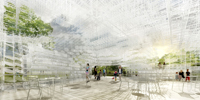 The Serpentine Gallery Pavilion 2013 will be designed by multi award-winning Japanese architect Sou Fujimoto. The Serpentine Gallery Pavilion 2013 will be designed by multi award-winning Japanese architect Sou Fujimoto.
He is the thirteenth and, at 41, youngest architect to accept the invitation to design a temporary structure for the Serpentine Gallery.
Widely acknowledged as one of the most important architects coming to prominence worldwide, Sou Fujimoto is the leading light of an exciting generation of artists who are re-inventing our relationship with the built environment. Inspired by organic structures, such as the forest, the nest and the cave, Fujimoto's signature buildings inhabit a space between nature and artificiality.
Julia Peyton-Jones, Director, and Hans Ulrich Obrist, Co-Director, Serpentine Gallery, said: "We are thrilled to be working with one of the most fascinating architects in the world today. A visionary, who has conceived an extraordinary response to our invitation to design the Serpentine Gallery Pavilion, Sou Fujimoto has designed a structure that will enthral everyone that encounters it throughout the summer."
Fujimoto is the third Japanese architect to accept the invitation to design the Serpentine Gallery Pavilion, following Toyo Ito in 2002 and Kazuyo Sejima & Ryue Nishizawa of SANAA in 2009. |
 |
 |
  |
 Wurzburg State Fire Brigade School by gmp Wurzburg State Fire Brigade School by gmp |
 |
February 16, 2013
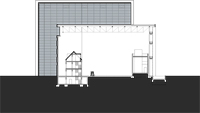 The architects von Gerkan, Marg and Partners (gmp) will build the new State Fire Brigade School in Würzburg. In the summer of 2012, gmp were awarded the contract following a negotiated tendering procedure and the company has now presented its design to Würzburg’s Commission for Urban Design and Architecture. The project involves a new practice hall on the site of the Fire Brigade School in order to meet the changed requirements of the training program. The architects von Gerkan, Marg and Partners (gmp) will build the new State Fire Brigade School in Würzburg. In the summer of 2012, gmp were awarded the contract following a negotiated tendering procedure and the company has now presented its design to Würzburg’s Commission for Urban Design and Architecture. The project involves a new practice hall on the site of the Fire Brigade School in order to meet the changed requirements of the training program.
The site is in a very exposed location so that the new practice hall building will be visible from afar, and will clearly mark the position of the State Fire Brigade School within the Zellerau neighborhood.
The total floor space comprises about 7,700 square meters and includes faithful replicas of apartments, hospital rooms, office rooms and catering facilities for the purpose of simulated fire drill activities; in addition there is a fair-faced concrete training wall at the east elevation which is intended for practice exercises with ladders. |
 |
 |
  |
 2013 RIBA Norman Foster Travelling Scholarship call for entries 2013 RIBA Norman Foster Travelling Scholarship call for entries |
 |
January 29, 2013
 The 2013 RIBA Norman Foster Travelling Scholarship has launched and is inviting applications from schools of architecture around the world. A £6,000 grant will be awarded to one student by a panel of judges which includes Lord Foster and the President of the RIBA. The 2013 RIBA Norman Foster Travelling Scholarship has launched and is inviting applications from schools of architecture around the world. A £6,000 grant will be awarded to one student by a panel of judges which includes Lord Foster and the President of the RIBA.
First established in 2006, the scholarship is now in its sixth year and is intended to fund international research on a topic related to the survival of our towns and cities, in a location of the student’s choice. Past RIBA Norman Foster Scholars have travelled through the Americas, Europe, Africa, South East Asia, the Middle and the Far East, and Russia. Proposals for research might include: learning from the past to inform the future; the future of society; the density of settlements; sustainability; the use of resources; the quality of urban life; and transport.
Lord Foster: “As a student I won a prize that allowed me to spend a summer travelling through Europe and to study first hand buildings and cities that I knew only from the pages of books. It was a revelation – liberating and exhilarating in so many ways. Today it is my privilege to fund the RIBA Norman Foster Travelling Scholarship, which I hope will have a lasting legacy – offering the chance for discovery and the inspiration for exciting new work – for generations to come.”
The deadline for submissions is Friday 26 April 2013.
» www.architecture.com/fosterscholarship |
 |
 |
  |
 In Dialogue with the World In Dialogue with the World |
 |
January 14, 2013
 The exhibition In Dialogue with the World opens on 17 January 2013 at the esteemed exhibition venue, the Danish Architecture Centre (DAC), in Copenhagen, Denmark. In Dialogue with the World shows how architects today engage far beyond aesthetics when designing buildings. The exhibition In Dialogue with the World opens on 17 January 2013 at the esteemed exhibition venue, the Danish Architecture Centre (DAC), in Copenhagen, Denmark. In Dialogue with the World shows how architects today engage far beyond aesthetics when designing buildings.
In this exhibition three distinguished Danish architecture companies - Henning Larsen Architects, schmidt hammer lassen architects and ADEPT - invite us to listen to their personal, uncensored accounts of what it is like to work in the field of architecture in the 21st century. They will describe how they relate to citizens, culture, history and urban structures, when they design new architecture.
With the title Give More, the schmidt hammer lassen architects’ part of the exhibition uses eight selected projects as examples of how buildings, aside from being beautiful, give more.
"In the exhibition, we focus on architecture as a tool for designing the framework for life. For schmidt hammer lassen architects, architecture is not a goal in itself. It is a means to create positive changes for people, places and communities. Architecture should not only be beautiful to look at, it should make a difference," according to founding partner of schmidt hammer lassen architects, Mr Bjarne Hammer.
The exhibition will run from 18 January to 10 March 2013. |
 |
 |
  |
 La Serenissima Building in Milan by Park Associati La Serenissima Building in Milan by Park Associati |
 |
January 10, 2013
 Park Associati has completed the refurbishment of La Serenissima Building in Milan. Park Associati has completed the refurbishment of La Serenissima Building in Milan.
This building, formerly Campari Building, located in the heart of Milan, was designed in the 60's by Ermenegildo e Eugenio Soncini for the company Campari. It is a one of series of constructions, that in the years of the economic boom, become representative of the new communicative power of the Italian industry.
The building is distinguished by the burnished colour finish of the metal structures on the facade, the tinted glass of the curtain wall system, the brown paintwork and the smaller volume used as a residential unit. During its heyday, the building would have been considered modern and technologically advanced. However, in its contemporary condition, many of its undeniably fascinating aspects have proved to be uneconomical particularly in terms of energy saving. The new owner has decided to redesign the building respecting the original layout. |
 |
 |
  |
 gmp wins competion for Kunsthalle Mannheim gmp wins competion for Kunsthalle Mannheim |
 |
January 3, 2013
 The architects von Gerkan, Marg and Partners (gmp) have been awarded the contract to design the new Kunsthalle Mannheim. This was the decision made by the Kunsthalle‘s jury. After three architect’s practices were awarded first place in a closed, anonymous competition back in July 2012, these practices were asked to revise their designs. The practices were gmp, Staab Architects and Peter Pütz Architects. Irrespective of the negotiation procedure, an exhibition started in October at which the public were able to familiarize themselves with the three winning entries. The architects von Gerkan, Marg and Partners (gmp) have been awarded the contract to design the new Kunsthalle Mannheim. This was the decision made by the Kunsthalle‘s jury. After three architect’s practices were awarded first place in a closed, anonymous competition back in July 2012, these practices were asked to revise their designs. The practices were gmp, Staab Architects and Peter Pütz Architects. Irrespective of the negotiation procedure, an exhibition started in October at which the public were able to familiarize themselves with the three winning entries.
The Kunsthalle design created by gmp portrays a symbolic identity, both on the outside and on the inside: the idea was to create a place that is easily remembered, and which appeals with its functional and urban quality. Analogous to the chess board type layout of Mannheim’s inner city, the design is a composition of several cubes, the regularity of which is however broken by an offset arrangement in terms of height and width, and also by the arrangement of squares within the development.
Visitors experience different sized rooms full of excitement and with a range of different air spaces. This creates a range of vistas inside and outside of the building. With the concept of a louvred facade, the design clearly distinguishes itself from neighboring buildings in terms of its color scheme and materials. The intention was to choose a warm metal color which on the one hand does not replicate the red of the regional sandstone but, on the other hand, does not appear cold in spite of its timeless feel. The plain architecture, with its translucent facade envelope, radiates a strong presence. |
 |
 |
  |
 New Year New Year |
 |
|
 |
 |
  |
 Designs for the New York Public Library by Norman Foster Designs for the New York Public Library by Norman Foster |
 |
December 30, 2012
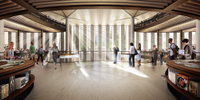 The New York Public Library unveiled proposals for the integration of the Circulating Library into its flagship Stephen A. Schwarzman Building on 42nd Street – Lord Foster presented the plans at the launch of the public exhibition. The New York Public Library unveiled proposals for the integration of the Circulating Library into its flagship Stephen A. Schwarzman Building on 42nd Street – Lord Foster presented the plans at the launch of the public exhibition.
The project aims to safeguard the building’s legacy and precious books for future generations. The existing research library will be retained as it is today, with more space for researchers, as will many of the public spaces – the project will open twice as much of the building to the public and will restore the logic of the Neo-Classical design to improve the experience of the library’s historic halls. The two circulating collections will be housed in a spectacular light-filled new space with views of Bryant Park, previously occupied by book stacks.
The Library expects construction to begin in 2013, and to be completed in 2018, pending various approvals. All three buildings involved will remain open throughout construction. |
 |
 |
  |
 Inauguration of the IBC Innovation Factory by schmidt hammer lassen Inauguration of the IBC Innovation Factory by schmidt hammer lassen |
 |
December 29, 2012
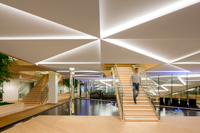 The IBC Innovation Factory by schmidt hammer lassen architects is designed to support new ways of learning. The 12,800 square metres educational building has gone through a total refurbishment and was be officially inaugurated by His Royal Highness the Prince Consort of Denmark. The IBC Innovation Factory by schmidt hammer lassen architects is designed to support new ways of learning. The 12,800 square metres educational building has gone through a total refurbishment and was be officially inaugurated by His Royal Highness the Prince Consort of Denmark.
The IBC Innovation Factory is the result of a refurbishment project of the paint manufacturer GORI’s factory from 1978, which set new standards for factories at the time. In the spirit of the original factory, schmidt hammer lassen architects, in collaboration with International Business College (IBC) Kolding, has created the settings for a ground-breaking and creative learning environment, aiming to become the world’s best. The ambition is to be a training camp for future innovators.
“With the acquisition of the GORI factory in the summer of 2010, the IBC gained access to a unique physical environment characterized by an impressive pioneering spirit and vision. It was the first factory plant in Denmark to unite production and management in one large room, allowing visual connection between the two,” explained Founding Partner at schmidt hammer lassen architects, Mr John Foldbjerg Lassen, and he continued, “The large paint tanks were decorated by the French artist Jean Dewasne, in the conviction that art in the workplace would inspire employees and provide a better working environment. The same idea inspired the incorporation of badminton courts and Ping-Pong tables on the production floor for the employees.” |
 |
 |
  |
 Year by year Year by year |
 |
|
 |
 |
  |
 12.12.12 Louvre-Lens by SANAA 12.12.12 Louvre-Lens by SANAA |
 |
December 12, 2012
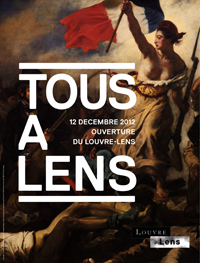 The Louvre-Lens opens today. Designed in close coordination between architects and landscapers, presents an unprecedented relationship and dialog between the museum and the landscaped setting surrounding it. This porous relationship between architecture and setting is often reflected in the term «Park Museum». Despite its impressive size, the museum is harmoniously and subtly embedded into its surroundings, the former coal mine taken over by nature, whose fragile beauty and entire breadth have been preserved. The Louvre-Lens opens today. Designed in close coordination between architects and landscapers, presents an unprecedented relationship and dialog between the museum and the landscaped setting surrounding it. This porous relationship between architecture and setting is often reflected in the term «Park Museum». Despite its impressive size, the museum is harmoniously and subtly embedded into its surroundings, the former coal mine taken over by nature, whose fragile beauty and entire breadth have been preserved.
The Japanese architects from SANAA, Kazuyo Sejima and Ryue Nishizawa wanted to avoid creating a dominating fortress, opting instead for a low, easily accessible structure that integrates into the site without imposing on it by its presence. The structure is made up of five building of steel and glass. There are four rectangles and one large square with slightly curved walls whose angles touch. It is reminiscent of the Louvre Palace, with its wings laid almost flat. The architects wanted to bring to mind boats on a river coming together to dock gently with each other. The facades are in polished aluminum, in which the park is reflected, ensuring continuity between the museum and the surrounding landscape. The roofs are partially in glass, reflecting a particular advantage to bringing in light, both for exhibiting the works and for being able to the sky from inside the building. Natural light is controlled by means of a concealment device in the roof and interior shades forming the ceiling. Designed as an answer to the vaulted ceiling, the surface retains in its light the change of seasons, hours and exhibitions. |
 |
 |
  |
 Tribute to Oscar Niemeyer by Norman Foster Tribute to Oscar Niemeyer by Norman Foster |
 |
December 6, 2012
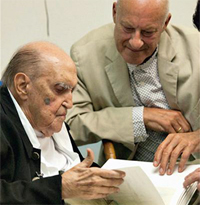 I was deeply saddened to learn of the death of Oscar Niemeyer. He was an inspiration to me – and to a generation of architects. Few people get to meet their heroes and I am grateful to have had the chance to spend time with him in Rio last year. I was deeply saddened to learn of the death of Oscar Niemeyer. He was an inspiration to me – and to a generation of architects. Few people get to meet their heroes and I am grateful to have had the chance to spend time with him in Rio last year.
For architects schooled in the mainstream Modern Movement, he stood accepted wisdom on its head. Inverting the familiar dictum that ‘form follows function’, Niemeyer demonstrated instead that, ‘When a form creates beauty it becomes functional and therefore fundamental in architecture’.
It is said that when the pioneering Russian cosmonaut, Yuri Gagarin visited Brasilia he likened the experience to landing on a different planet. Many people seeing Niemeyer’s city for the first time must have felt the same way. It was daring, sculptural, colourful and free - and like nothing else that had gone before. Few architects in recent history have been able to summon such a vibrant vocabulary and structure it into such a brilliantly communicative and seductive tectonic language.
Norman Foster
» Read more |
 |
 |
  |
 Circuit of the Americas - Formula1 United States Grand Prix Circuit of the Americas - Formula1 United States Grand Prix |
 |
|
 |
 |
  |
 Circuit of the Americas - Formula1 United States Grand Prix Circuit of the Americas - Formula1 United States Grand Prix |
 |
|
 |
 |
  |
 A new beacon for the top sports city of Eindhoven by Mecanoo A new beacon for the top sports city of Eindhoven by Mecanoo |
 |
October 31, 2012
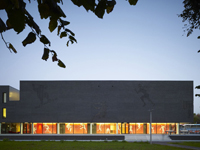 Sport encourages friendship and solidarity and serves as an inspiration. Sport is healthy, relaxing, and above all, fun. This is evident in the sports college that Mecanoo architecten was commissioned to build by the council of Eindhoven and Fontys University of Applied Sciences on the Genneper Parken ‘sports estate’ in Eindhoven. The 16,500 m2 sports complex is now open. The event was celebrated by many renowned Dutch sporting personalities, including recent Olympic medal winners Marleen Veldhuis, Ranomi Kromowidjojo and Marianne Vos. The state of the art complex accommodates educational facilities for 2,000 students, five sports halls, a climbing wall, a restaurant and an underground car park with 200 parking places. Sport encourages friendship and solidarity and serves as an inspiration. Sport is healthy, relaxing, and above all, fun. This is evident in the sports college that Mecanoo architecten was commissioned to build by the council of Eindhoven and Fontys University of Applied Sciences on the Genneper Parken ‘sports estate’ in Eindhoven. The 16,500 m2 sports complex is now open. The event was celebrated by many renowned Dutch sporting personalities, including recent Olympic medal winners Marleen Veldhuis, Ranomi Kromowidjojo and Marianne Vos. The state of the art complex accommodates educational facilities for 2,000 students, five sports halls, a climbing wall, a restaurant and an underground car park with 200 parking places.
The building is a crucial link in the development of Genneper Parken, the sports and recreational area, confirming Eindhoven as a Sports City.
Ellen van der Wal from Mecanoo explains: “We wanted to create a social building. Everyone is familiar with the stereotypical image of the sports hall as a dull closed box, an association we wanted to avoid.”
As the building is intended both for education and for top sports and amateur sports, the architect was also confronted with a logistical challenge. In the evenings and at weekends when sports clubs make use of the building, it had to be possible to screen off the educational function. This was challenging, but the many different spaces were successfully forged to create a harmonious whole. The sports college presents itself as a powerful entity with a single theme: sport is fun. |
 |
 |
  |
 Five architectural firms beyond star architecture Five architectural firms beyond star architecture |
 |
October 22, 2012
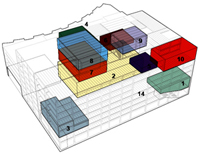 The setting is the former industrial compound of Danish brewery giant Carlsberg in central Copenhagen. This historic context frames one of the most important urban developments in creating the future Copenhagen. The new city is to be developed over the next 25 years and will host a programme of education, housing, culture business and recreational areas. The setting is the former industrial compound of Danish brewery giant Carlsberg in central Copenhagen. This historic context frames one of the most important urban developments in creating the future Copenhagen. The new city is to be developed over the next 25 years and will host a programme of education, housing, culture business and recreational areas.
UCC, University College Capital, the biggest new stakeholder, plans to move all their activities into a new headquarter of approximately 57,000 m2. The UCC complex will be located in a mixed-use building of 85.000 m2 combining education, housing, shops and cultural activities. To create this immense new building structure a competition between five teams of architects was launched.
And the result: A partnership of five Danish architectural firms - Vilhelm Lauritzen Architects, Christensen & Co Architects a/s, COBE, NORD Architects and Effekt - won the competition to build the largest private development in Denmark, including Denmark’s highest residential tower.
The project has become a statement for the architecture of a new age. |
 |
 |
  |
 Tianjin Grand Theater, China, by gmp - von Gerkan, Marg und Partner Tianjin Grand Theater, China, by gmp - von Gerkan, Marg und Partner |
 |
October 12, 2012
 After a construction period of two years, von Gerkan, Marg und Partners Architects have completed the Tianjin Grand Theater in summer 2012, which is located south-east of Beijing. The Tianjin Grand Theater is the third building of this kind by gmp in China, following the Opera Houses in Qingdao and Chongqing. After a construction period of two years, von Gerkan, Marg und Partners Architects have completed the Tianjin Grand Theater in summer 2012, which is located south-east of Beijing. The Tianjin Grand Theater is the third building of this kind by gmp in China, following the Opera Houses in Qingdao and Chongqing.
The Grand Theater occupies the key position in the newly built Culture Park of Tianjin. The circular shape of the roof construction corresponds with the existing Museum of Natural History so that an architectural dialogue of an earth-bound and a “floating” circular volume is created to both ends of the park. Earth and sky represent a fundamental thinking in Chinese philosophy.
The roof volume of the Grand Theater opens up toward the broad water surface like an open sea shell. Opera hall, concert hall and the small multifunctional hall are exposed to the water surface like pearls inside this shell.
The three venues are conceived as free standing volumes on a stone base. Broad stairways connect the stone base with the raised plaza creating a kind of stage for urban life which overlooks the lake and the Culture Park.
Vehicular traffic is avoided on the water side. Drop-offs are located to the north and south whilst bus stops are situated along a dwelling mound to the east of the building. All internal areas are located within the base so that an unobstructed internal circulation is achieved.
The roof construction is a transformation of the traditional Chinese element of multiple eaves and thus defines a system of common horizontal layers, which creates an architectural entity of roof, facade and stone base. |
 |
 |
  |
 Spijkenisse Book Mountain by MVRDV Spijkenisse Book Mountain by MVRDV |
 |
October 11, 2012
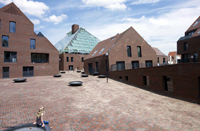 The Spijkenisse Book Mountain and the adjacent residential neighbourhood was opened by Prinses Laurentien of the Netherlands. Manifesting itself clearly as a mountain of books on the towns market square, it is both an advertisement and an invitation for reading. Clever stacking of the buildings commercial functions produces its pyramidal form, which in turn, is wrapped in the libraries 480 meters route along bookshelves. Underneath the libraries barn shaped glass envelope the book gains a strong educational presence in this formerly agricultural community located close the docks of the Port of Rotterdam. The adjacent Library Quarter consisting of 42 social housing units, parking and public space is also a project by MVRDV, together with the Book Mountain it forms an exemplary eco-neighbourhood. The Spijkenisse Book Mountain and the adjacent residential neighbourhood was opened by Prinses Laurentien of the Netherlands. Manifesting itself clearly as a mountain of books on the towns market square, it is both an advertisement and an invitation for reading. Clever stacking of the buildings commercial functions produces its pyramidal form, which in turn, is wrapped in the libraries 480 meters route along bookshelves. Underneath the libraries barn shaped glass envelope the book gains a strong educational presence in this formerly agricultural community located close the docks of the Port of Rotterdam. The adjacent Library Quarter consisting of 42 social housing units, parking and public space is also a project by MVRDV, together with the Book Mountain it forms an exemplary eco-neighbourhood.
The library is designed as an advert for reading, its visible presence and invitation holding great significance for a community with 10 percent illiteracy. From underneath the glass dome the library is visible from all sides, especially from the adjacent market square where the library appears as one big book mountain. Underneath its monumental glass envelope damage to the books by sunlight is off-set by their normal 4 year life-span due to wear and tear from borrowing.
Located in the centre of Spijkenisse, the library with a total surface area of 9.300m2 sits on the market square next to the historical village church. Besides the library the building houses the environmental education centre, a chess club, auditorium, meeting rooms, commercial offices and retail. The exterior of the library refers in shape and materiality to the traditional Dutch Farm, a reminder of the towns agricultural past, which has grown from farming village to Ville Nouvelle in the past 40 years. |
 |
 |
  |
 Foster + Partners wins competition for new tower at 425 Park Avenue, New York Foster + Partners wins competition for new tower at 425 Park Avenue, New York |
 |
October 7, 2012
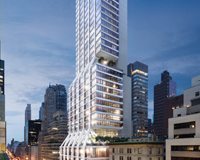 Foster + Partners have been selected by a partnership of L&L Holding Company and Lehman Brothers Holdings Inc. (LBHI) to design their new office tower at 425 Park Avenue. The new building will create an enduring landmark that befits its exclusive location, and is uniquely of its time and its place. The project presents an outstanding opportunity to contribute to the existing character of Park Avenue and responds to the scale and datum of the Avenue and neighbouring buildings. Clearly expressing the geometry of its structure, the tapered steel-frame tower rises to meet three shear walls that will be illuminated, adding to the vibrant New York City skyline. Foster + Partners have been selected by a partnership of L&L Holding Company and Lehman Brothers Holdings Inc. (LBHI) to design their new office tower at 425 Park Avenue. The new building will create an enduring landmark that befits its exclusive location, and is uniquely of its time and its place. The project presents an outstanding opportunity to contribute to the existing character of Park Avenue and responds to the scale and datum of the Avenue and neighbouring buildings. Clearly expressing the geometry of its structure, the tapered steel-frame tower rises to meet three shear walls that will be illuminated, adding to the vibrant New York City skyline.
Lord Foster said: “I have a personal connection with New York, which has been a source of inspiration since my time at Yale, when the new towers on Park Avenue and its neighbourhoods were a magnet for every young architect. Seeing first-hand the works of Mies van der Rohe, Gordon Bunshaft, Eero Saarinen and Philip Johnson was tremendously exciting then – I am delighted to have this very special opportunity to design a contemporary tower to stand alongside them. Our aim is to create an exceptional building, both of its time and timeless, as well as being respectful of this context – a tower that is for the City and for the people that will work in it, setting a new standard for office design and providing an enduring landmark that befits its world-famous location.” |
 |
 |
  |
 Peter Zumthor awarded 2013 Royal Gold Medal for architecture Peter Zumthor awarded 2013 Royal Gold Medal for architecture |
 |
October 1, 2012
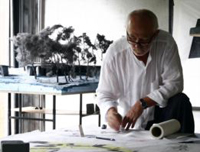 The world renowned Swiss architect Peter Zumthor has been named as the recipient of one of the world’s most prestigious architecture prizes, the Royal Gold Medal. The world renowned Swiss architect Peter Zumthor has been named as the recipient of one of the world’s most prestigious architecture prizes, the Royal Gold Medal.
Given in recognition of a lifetime’s work, the Royal Gold Medal is approved personally by Her Majesty the Queen and is given to a person or group of people who have had a significant influence “either directly or indirectly on the advancement of architecture”.
RIBA President Angela Brady, who chaired the Honours Committee which selected the Royal Gold Medal winner said,
“Peter Zumthor’s work renews the link with a tradition of modern architecture that emphasises place, community and material practice. His writings dwell upon the experience of designing, building and inhabitation while his buildings are engaged in a rich dialogue with architectural history. I will be delighted to present him with the Royal Gold Medal.”
Peter Zumthor will be presented with the Royal Gold Medal on Wednesday 6 February 2013 at a ceremony at the Royal Institute of British Architects in London, during which the 2013 RIBA International and Honorary Fellowships will also be presented.
This year’s RIBA Honours Committee was chaired by RIBA President Angela Brady with architects Peter Clegg, Yvonne Farrell, Professor Adrian Forty, Niall McLaughlin and Sarah Wigglesworth. |
 |
 |
  |
 University of Aberdeen New Library, Scotland, by schmidt hammer lassen University of Aberdeen New Library, Scotland, by schmidt hammer lassen |
 |
September 30, 2012
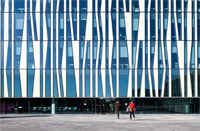 Her Majesty Queen Elizabeth II of Great Britain marks the official opening of the University of Aberdeen New Library in Scotland. The building, won in an architectural competition in 2005 by schmidt hammer lassen architects, is replacing the University’s former library from 1965 – the Queen Mother Library. The 15,500 m² new library, which provides a 21st century learning and research environment for students, university staff, visitors and the public, is a positive example of how architecture can make a difference. Since the building was put into service in September 2011, the statistics have shown a significant increase in the use of the library, and more than 700,000 visitors have entered the building this first year of operation. Her Majesty Queen Elizabeth II of Great Britain marks the official opening of the University of Aberdeen New Library in Scotland. The building, won in an architectural competition in 2005 by schmidt hammer lassen architects, is replacing the University’s former library from 1965 – the Queen Mother Library. The 15,500 m² new library, which provides a 21st century learning and research environment for students, university staff, visitors and the public, is a positive example of how architecture can make a difference. Since the building was put into service in September 2011, the statistics have shown a significant increase in the use of the library, and more than 700,000 visitors have entered the building this first year of operation.
“The University of Aberdeen New Library functions as a meeting place and a cultural centre for the students of the University as well as the Aberdeen community. The façade of the building shimmers during the day and glows softly at night, creating a luminous landmark – a beacon – for the city of Aberdeen,” said Morten Schmidt, Founding Partner of schmidt hammer lassen architects, and he continued: “The increase in visitors shows that the new library has affected the students’ everyday behaviour. The students come to study in the new library and to be a part of the social community of the University.”
At the opening ceremony, the University of Aberdeen New Library will be named the ‘Sir Duncan Rice Library’ in recognition of the vision, ambition and leadership of the University’s former Principal and Vice-Chancellor, Sir Duncan Rice. |
 |
 |
  |
 New home for students of Amsterdam University College by Mecanoo New home for students of Amsterdam University College by Mecanoo |
 |
September 22, 2012
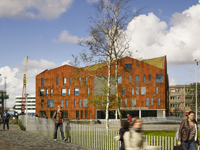 On Friday 21 September 2012 the Amsterdam councillor Lodewijk Asscher officially opened Amsterdam University College. The new and striking 6,000 m2 educational building was designed by Mecanoo architecten in Delft. The prestigious Amsterdam University College accommodates the joint liberal arts and sciences programme of the University of Amsterdam and the VU University Amsterdam. The educational institute forms the entrance to Science Park, the international knowledge centre in the Watergraafsmeer neighbourhood close to Amsterdam’s historic seventeenth-century city centre. On Friday 21 September 2012 the Amsterdam councillor Lodewijk Asscher officially opened Amsterdam University College. The new and striking 6,000 m2 educational building was designed by Mecanoo architecten in Delft. The prestigious Amsterdam University College accommodates the joint liberal arts and sciences programme of the University of Amsterdam and the VU University Amsterdam. The educational institute forms the entrance to Science Park, the international knowledge centre in the Watergraafsmeer neighbourhood close to Amsterdam’s historic seventeenth-century city centre.
Amsterdam University College combines an intensive programme of studies with the cultural and social life of a campus. Francine Houben explains: “Amsterdam University College was designed as an inspiring home for the community of international students and their professors. It’s a friendly but robust home with a spacious loft on top.”
By positioning the tilting roofs diagonally, in a north-south direction, the sense of being in a loft is strengthened. Large voids form the heart of the building and create a visual relationship between the different floors. A staircase winds through the voids, symbolising a sense of community for its users. Distinguished spaces such as the restaurant, the common room and the study hall have two-storey facades with a beautiful view to the Science Park. |
 |
 |
  |
 Best Collaboration Award for schmidt hammer lassen and the City of Aarhus Best Collaboration Award for schmidt hammer lassen and the City of Aarhus |
 |
September 20, 2012
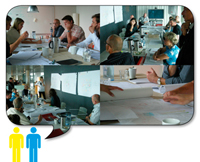 schmidt hammer lassen architects and the City of Aarhus have been selected to receive a Best Collaboration Award 2012 for their extensive cooperation in creating the largest public library in Scandinavia: Urban Mediaspace. The Best Collaboration Award, an EU-initiative, rewards the best examples of collaboration between partners from the creative industries sector and local governments in the North Sea Region of the European Union. schmidt hammer lassen architects and the City of Aarhus have been selected to receive a Best Collaboration Award 2012 for their extensive cooperation in creating the largest public library in Scandinavia: Urban Mediaspace. The Best Collaboration Award, an EU-initiative, rewards the best examples of collaboration between partners from the creative industries sector and local governments in the North Sea Region of the European Union.
The jury has selected the team behind the Urban Mediaspace project because of the broad and intensive collaboration process between the municipality, the architects, the citizens and future users. According to the jury report, “the intensive implication of citizens will be positive for the further development of the library as a public space for information and exchange of ideas.”
Five European teams have won a Best Collaboration Award 2012. The overall winner among the five will be announced at an Award Ceremony in Groeningen, the Netherlands on 20th of September 2012.
Urban Mediaspace is expected to be finished in 2014. Besides the Urban Mediaspace library in Denmark, schmidt hammer lassen architects is currently working on two other library projects: one in Halifax and one in Edmonton, both in Canada. Like Urban Mediaspace, the Halifax Library project has taken shape after extensive sessions of user-group involvement. |
 |
 |
  |
 Henning Larsen awarded the Praemium Imperiale Henning Larsen awarded the Praemium Imperiale |
 |
September 17, 2012
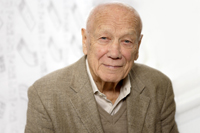 Architect Henning Larsen is awarded one of the world’s most prestigious global arts awards, the Praemium Imperiale 2012. The Praemium Imperiale has been awarded to a number of the most distinguished and influential artists of the late 20th and early 21st century. Architect Henning Larsen is awarded one of the world’s most prestigious global arts awards, the Praemium Imperiale 2012. The Praemium Imperiale has been awarded to a number of the most distinguished and influential artists of the late 20th and early 21st century.
The prize was founded by Japan’s oldest cultural organisation, the Japan Art Association, and is presented by the Japanese Imperial Family at a gala ceremony in late October.
Henning Larsen is the first Danish artist to receive the Praemium Imperiale, which was first awarded in 1989. The prize recognises outstanding achievements in five categories representing the major arts – Painting, Sculpture, Architecture, Music and Theatre/Film.
Extract from the Prize Committee’s citation in awarding the 2012 award in architecture to Henning Larsen: ”Light seems to fall from the ceiling and windows, reflecting off the floors and walls, filling the space sublimely; these minutely calculated lighting effects are one of the greatest characteristics of Henning Larsen’s architecture.“
Previous Laureates in architecture include Jean Nouvel, Renzo Piano, Rem Koolhaas, Norman Foster, Peter Zumthor, Jacques Herzog and Pierre de Meuron.
In the remaining categories, the 2012 Praemium Imperiale is presented to the Chinese artist Cai Guo-Qiang, the Italian sculptor Cecco Bonanotte, the American composer Philip Glass and the Japanese ballet dancer Yoko Morishita. |
 |
 |
  |
 Art Museum in Førde, Norway, by C.F. Møller Art Museum in Førde, Norway, by C.F. Møller |
 |
September 15, 2012
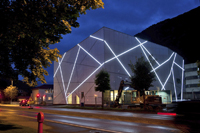 C.F. Møller Architects has designed a new art museum in Førde north of Bergen in Norway, the new Sogn & Fjordane Art Museum. The museum lies like a crystal-clear block of ice that has slid down from the surrounding mountains and the architecture is inspired by the landscape: In Førde the mountains are visible everywhere, and Jostedalsbreen, the largest glacier on the European mainland, lies in close proximity to the town. C.F. Møller Architects has designed a new art museum in Førde north of Bergen in Norway, the new Sogn & Fjordane Art Museum. The museum lies like a crystal-clear block of ice that has slid down from the surrounding mountains and the architecture is inspired by the landscape: In Førde the mountains are visible everywhere, and Jostedalsbreen, the largest glacier on the European mainland, lies in close proximity to the town.
The crystalline form provides an asymmetrical plan solution, with varying displacements in the facade. The facade is clad in white glass with a network of angled lines, reminiscent of the fracture lines in ice. This network also defines the irregular window apertures. In the evening these lines are illuminated, so that the museum lies like a sparkling block in the middle of the town’s darkness.
C.F. Møller Architects were also responsible for the design of the SEIF office building which is the museum’s closest neighbour, and for a residential complex on the same site which is presently under construction. |
 |
 |
  |
 The Banal The Banal |
 |
August 30, 2012
 Praise be to Nero’s Neptune. Praise be to Nero’s Neptune.
The Titanic sails at dawn.
And everybody’s shouting
“Which Side Are You on?”
(Bob Dylan: “Desolation Row”, 1966)
If one did not know that the media constantly exaggerates, one could almost conclude – as the Süddeutsche Zeitung has – that the Venice Biennale of Architecture really is the world’s most important architecture exhibition.
However, I believe that the word “exhibition” is not intended to describe an exhibition in this case, rather that the notion only designates the event per se. In other words an industry meeting, like a product fair. Other critics fail to even question the purpose of the exhibition, rather they immediately conclude that the coming together, the meeting, the networking is the key aspect. That’s that!
Wolf D. Prix / COOP HIMMELB(L)AU
» Read more |
 |
 |
  |
 Hamburg-Harburg Technical University extended by main building Hamburg-Harburg Technical University extended by main building |
 |
August 24, 2012
 Barely two years after the groundbreaking ceremony, Hamburg-Harburg Technical University will be inaugurating its new main building tomorrow, on time for the scheduled completion date. Designed by the architects von Gerkan, Marg and Partners (gmp), a new building comprising both historic and new parts has been created at the site of the former Schwarzenbergkaserne (Schwarzenberg Barracks). Barely two years after the groundbreaking ceremony, Hamburg-Harburg Technical University will be inaugurating its new main building tomorrow, on time for the scheduled completion date. Designed by the architects von Gerkan, Marg and Partners (gmp), a new building comprising both historic and new parts has been created at the site of the former Schwarzenbergkaserne (Schwarzenberg Barracks).
The new main building of TU Harburg forms a succinct entrance to the existing campus, which is made up of 14 buildings. It accommodates the executive commitee, auditoriums and seminar rooms, as well as the students’ learning and communication centre, which is open 24 hours a day.
The seemingly irregularly placed tubes and the steel cables in the intermediate spaces spell “Technische Universität Hamburg-Harburg” when read in Morse code. |
 |
 |
  |
 Alvaro Siza. Viagem sem Programa Alvaro Siza. Viagem sem Programa |
 |
August 13, 2012
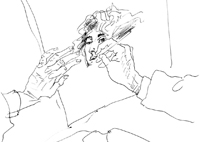 “Álvaro Siza. Viagem sem Programa” is the title of the collateral event that Fondazione Querini Stampalia will be hosting from August 29 to November 11, 2012 (admission is free of charge). The exhibition is exclusively dedicated to the most personal aspects of the Portuguese architect Álvaro Siza – one the leading players in the international design scene – who was recently awarded the Golden Lion for Lifetime Achievement at the13th International Architecture Exhibition – la Biennale di Venezia. “Álvaro Siza. Viagem sem Programa” is the title of the collateral event that Fondazione Querini Stampalia will be hosting from August 29 to November 11, 2012 (admission is free of charge). The exhibition is exclusively dedicated to the most personal aspects of the Portuguese architect Álvaro Siza – one the leading players in the international design scene – who was recently awarded the Golden Lion for Lifetime Achievement at the13th International Architecture Exhibition – la Biennale di Venezia.
In addition to shedding light on Siza’s extraordinary eidetic memory, the exhibition underscores the power of the drawings (chiefly portraits) created during his youth, his many trips abroad for work purposes, recent dinner parties with friends and moments “free from the burden of work” populated with memoirs, views and ironical stances accumulated with the passing of time. They all contribute to giving form to his way of living and conceiving life.
» Read more |
 |
 |
  |
 Sølvgades School in Copenhagen by C.F. Møller Sølvgades School in Copenhagen by C.F. Møller |
 |
August 6, 2012
 Denmark’s oldest school, the listed Sølvgades School built in 1847, close to King Christian IV’s famous historic naval barracks, Nyboder, in Copenhagen, has for many years been lacking space and modern facilities. C.F. Møller has carefully renovated the school and done an extension which in its form and colours is true to the surroundings, but also adds a modernistic twist to the school. Denmark’s oldest school, the listed Sølvgades School built in 1847, close to King Christian IV’s famous historic naval barracks, Nyboder, in Copenhagen, has for many years been lacking space and modern facilities. C.F. Møller has carefully renovated the school and done an extension which in its form and colours is true to the surroundings, but also adds a modernistic twist to the school.
The new six-storey building with its striking glass façade gives Sølvgade School a lively, modernistic twist, but with its slanted shapes and colour scheme relating to Nyboder's pastel shades, it also corresponds with the historic surroundings.
Inside, the floorplan layout twists and angles, walls are sloping, and the coloristic colour scheme continues, linking inside and outside and creating an inspiring and dynamic learning environment.
The unusual double layering of the façade creates a highly insulated building, minimizes traffic noise, and functions as vent stack for natural ventilation. The hybrid ventilation concept combines natural and mechanical ventilation to minimize the use of energy and create the optimal indoor climate crucial to a learning environment. All in all, the energy consumption does not exceed 68 kWh/m2/year. |
 |
 |
  |
 V on Shenton in Singapore by Ben van Berkel / UNStudio V on Shenton in Singapore by Ben van Berkel / UNStudio |
 |
August 3, 2012
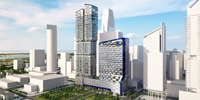 Ben van Berkel / UNStudio have designed the new UIC building, ‘V on Shenton’, in the heart of Singapore’s Central Business District. Ben van Berkel / UNStudio have designed the new UIC building, ‘V on Shenton’, in the heart of Singapore’s Central Business District.
The former UIC Building dominated the city skyline as Singapore’s tallest building for many years since its completion in 1973 and was part of an important collection of towers located along Shenton Way in the heart of Singapore's Central Business District. Today, the area is undergoing rejuvenation and transformation and ‘V on Shenton’, the new UIC building, forms part of this redevelopment. The dual programming of ‘V on Shenton’, comprising office and residential, presents a unique situation in this area of the city.
The twin tower of ‘V on Shenton’ is comprised of a 23-storey office building and a 53-storey residential tower, with the dual programming of the building highlighted through its massing. The office tower corresponds to the scale of the surrounding buildings and the street, while the residential tower rises up to distinguish itself from the neighbouring buildings. Above the third sky lobby the unit mix of the residential tower changes with a subtle display of its split core. |
 |
 |
  |
 eVolo 2013 Skyscraper Competition eVolo 2013 Skyscraper Competition |
 |
July 18, 2012
 Architectour.net is pleased to invite students, architects, engineers, designers, and artists from around the globe to take part in the eVolo 2013 Skyscraper Competition. Established in 2006, the annual Skyscraper Competition is one of the world's most prestigious awards for high-rise architecture. It recognizes outstanding ideas that redefine skyscraper design through the implementation of novel technologies, materials, programs, aesthetics, and spatial organizations along with studies on globalization, flexibility, adaptability, and the digital revolution. It is a forum that examines the relationship between the skyscraper and the natural world, the skyscraper and the community, and the skyscraper and the city. Architectour.net is pleased to invite students, architects, engineers, designers, and artists from around the globe to take part in the eVolo 2013 Skyscraper Competition. Established in 2006, the annual Skyscraper Competition is one of the world's most prestigious awards for high-rise architecture. It recognizes outstanding ideas that redefine skyscraper design through the implementation of novel technologies, materials, programs, aesthetics, and spatial organizations along with studies on globalization, flexibility, adaptability, and the digital revolution. It is a forum that examines the relationship between the skyscraper and the natural world, the skyscraper and the community, and the skyscraper and the city.
The participants should take into consideration the advances in technology, the exploration of sustainable systems, and the establishment of new urban and architectural methods to solve economic, social, and cultural problems of the contemporary city including the scarcity of natural resources and infrastructure and the exponential increase of inhabitants, pollution, economic division, and unplanned urban sprawl.
There are no restrictions in regards to site, program or size. The objective is to provide maximum freedom to the participants to engage the project without constraints in the most creative way.
» Read more |
 |
 |
  |
 Break Ground on New Governors Island Park by West 8 Break Ground on New Governors Island Park by West 8 |
 |
July 12, 2012
 Mayor Michael R. Bloomberg announced the groundbreaking of Phase 1 of the Governors Island Park and Public Spaces, designed by West 8. The Mayor’s press conference also coincided with the official opening of the Island’s 2012 summer season and the completed renovation of Castle Williams Fort. The plan for the first phase was delivered in February and is now officially under construction, set for completion in the fall of 2013. Mayor Michael R. Bloomberg announced the groundbreaking of Phase 1 of the Governors Island Park and Public Spaces, designed by West 8. The Mayor’s press conference also coincided with the official opening of the Island’s 2012 summer season and the completed renovation of Castle Williams Fort. The plan for the first phase was delivered in February and is now officially under construction, set for completion in the fall of 2013.
Areas currently under construction are Liggett Terrace, Hammock Grove, the Play Lawns, Soissons Landing and historic areas on the North Island such as the Parade Ground and South Battery. In its design, the park fully celebrates the ecology, history, culture, and the magnificent beauty of the New York harbor, connecting New York’s City to its waterfront. In addition to gardens, woodlands, and bikeways, West 8 has developed custom lighting, seating and signage. West 8 is also responsible for the Park and Public Space Master Plan, which lays out the plans for future phases such as Wetland Gardens, Hills, and a Great Promenade. |
 |
 |
  |
 Technology Center in Bologna, Italy, by gmp Technology Center in Bologna, Italy, by gmp |
 |
July 3, 2012
 The design by architects von Gerkan, Marg and Partners (gmp), which was honoured with first prize in an international competition, converts a former industrial heritage building to the north of Bologna into a modern technology park. The factory facilities of the former tobacco monopoly, designed by the famous Italian engineer and architect Pier Luigi Nervi are carefully modernised and converted to accommodate new functions. The additional new buildings carry the signature of the listed historic buildings dating from the 1940s, albeit in modern form. The design by architects von Gerkan, Marg and Partners (gmp), which was honoured with first prize in an international competition, converts a former industrial heritage building to the north of Bologna into a modern technology park. The factory facilities of the former tobacco monopoly, designed by the famous Italian engineer and architect Pier Luigi Nervi are carefully modernised and converted to accommodate new functions. The additional new buildings carry the signature of the listed historic buildings dating from the 1940s, albeit in modern form.
The technology center, with its area of about 110,000 square meters, will comprise an exhibition hall, laboratories, offices, a seedbed center for research affiliated with the university, and teaching facilities such as lecture halls and university institutes. In addition, there will be conference facilities, including hotel and service areas such as shops, a day nursery, restaurants and refectories to be established in the former power station. |
 |
 |
  |
 Álvaro Siza Vieira Awarded the Golden Lion 2012 Álvaro Siza Vieira Awarded the Golden Lion 2012 |
 |
July 1, 2012
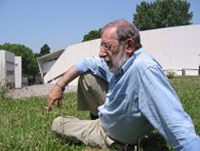 Álvaro Siza Vieira has been chosen to be the recipient of the Golden Lion for Lifetime Achievement of the 13th International Architecture Exhibition – Common Ground (Venice, Giardini and Arsenale, August 29th – November 25th, 2012). Álvaro Siza Vieira has been chosen to be the recipient of the Golden Lion for Lifetime Achievement of the 13th International Architecture Exhibition – Common Ground (Venice, Giardini and Arsenale, August 29th – November 25th, 2012).
The decision is made by the Board of la Biennale di Venezia, chaired by Paolo Baratta, under Director David Chipperfield who presented the following motivation:
“I am equal in size to whatever I see,
not hemmed in by the size I am”
(Fernando Pessoa, The Book of Disquiet)
“It is difficult to think of a contemporary architect who has maintained such a consistent presence within the profession as Álvaro Siza. That this presence is maintained by an architect that lives and works at the extreme Atlantic margin of Europe only serves to emphasise his authority and his status.”
» Read more |
 |
 |
  |
 Claus en Kaan Architecten create the winning design for the National Military Museum, Netherlands Claus en Kaan Architecten create the winning design for the National Military Museum, Netherlands |
 |
June 26, 2012
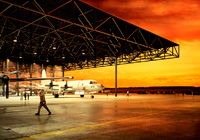 The plan submitted by the Heijmans consortium has been selected as the winning design for the construction of the new National Military Museum in Soesterberg. The consortium, a collaborative venture between Heijmans, Claus en Kaan Architecten, H+N+S Landschapsarchitecten and Kossmann.dejong Exhibition Architects, was given the unique assignment of not only designing a new building, but also the surrounding landscape and the entire museological design. The plan submitted by the Heijmans consortium has been selected as the winning design for the construction of the new National Military Museum in Soesterberg. The consortium, a collaborative venture between Heijmans, Claus en Kaan Architecten, H+N+S Landschapsarchitecten and Kossmann.dejong Exhibition Architects, was given the unique assignment of not only designing a new building, but also the surrounding landscape and the entire museological design.
The new museum was commissioned by the Ministry of Defence in order to tell the past, present and future stories of the armed forces to a wide audience.
The collections from the Military Aviation Museum in Soesterberg and the Army Museum in Delft will be combined and exhibited in this museum.
The new museum complex will be situated on the grounds of the former air base in Soesterberg. The museum is expected to be complete by the third quarter of 2014. |
 |
 |
  |
 Cultural Center in Bordeaux, France, by BIG Bjarke Ingels Cultural Center in Bordeaux, France, by BIG Bjarke Ingels |
 |
June 25, 2012
 Team BIG+FREAKS freearchitects, dUCKS scéno, Khephren Ingénierie, VPEAS, ALTO Ingénierie, Vincent Hedont, PBNL, Mryk & Moriceau, Ph.A wins the competition to design a new 12 000 m2 cultural center on the riverfront of Bordeaux, merging three cultural institutions into one single building. Team BIG+FREAKS freearchitects, dUCKS scéno, Khephren Ingénierie, VPEAS, ALTO Ingénierie, Vincent Hedont, PBNL, Mryk & Moriceau, Ph.A wins the competition to design a new 12 000 m2 cultural center on the riverfront of Bordeaux, merging three cultural institutions into one single building.
The new Maison de l’Économie Créative et de la Culture en Aquitaine, MÉCA, located on the historical riverfront of Bordeaux will house three regional visual and performing arts agencies FRAC, the ECLA and the OARA in one single institution. The Regional Council of Bordeaux selected the winning team among proposals from SANAA, the Toulouse- based firm W-Architectures and Bordeaux-based FLINT.
BIG’s proposal arranges the new center for contemporary art, the performing arts institution and the center for literature and movies around a public space open towards the city of Bordeaux and the Garonne River. The building is conceived as a single loop of public space and cultural institutions as the pavement of the promenade rises to form the roof of the main lobbies, ascends vertically along the stage tower of OARA, bridges across the promenade with the sky lit galleries of the FRAC and returns vertically to the ground at the archives of the ECLA in order to reunite with the waterfront promenade. |
 |
 |
  |
 Velo Towers in Yongsan District, South Korea, by Asymptote Velo Towers in Yongsan District, South Korea, by Asymptote |
 |
June 23, 2012
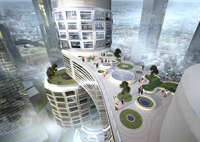 Asymptote Architecture principals Hani Rashid and Lise Anne Couture have presented the project of the Velo Towers, within the Dreamhub development in the Yongsan District of Seoul, Korea. Asymptote's project is designed as an integral part of the master plan accommodating several new projects that are situated along the newly planned Yongsan Park. Neighboring projects include MVRDV’s Cloud Towers, the Cross # Towers by BIG Architects and Project R6 by REX. Asymptote Architecture principals Hani Rashid and Lise Anne Couture have presented the project of the Velo Towers, within the Dreamhub development in the Yongsan District of Seoul, Korea. Asymptote's project is designed as an integral part of the master plan accommodating several new projects that are situated along the newly planned Yongsan Park. Neighboring projects include MVRDV’s Cloud Towers, the Cross # Towers by BIG Architects and Project R6 by REX.
The Velo Towers are composed as a dynamic arrangement of stacked and rotated volumes that are a formal and programmatic counterpoint to the conventional extrusion of massing that exemplifies the supertall as a building type. By breaking down the scale and massing of the two distinct towers into interconnected circular and oblong volumes, the Velo project proposes an alternative architectural and urbanistic response to the repetitive and monolithic austerity of conventional tower design. The recombination of the typical tower form into a new horizontal and vertical configuration enables the formation of a socially engaging and dynamic environmental response, as well as the creation of a discreet yet compelling architectural landmark for the Yongsan district. The Towers' eight distinct residential components are rotated and positioned within a carefully choreographed massing arrangement, calibrating the orientation and views of each residential volume and taking full advantage of the Towers' position adjacent to the Yongsan Park overlooking the Han River in the distance. |
 |
 |
  |
 Jubilee Gardens in London by West 8 Jubilee Gardens in London by West 8 |
 |
June 22, 2012
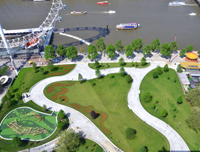 The renovation of Jubilee Gardens was completed in time for the Queen’s Diamond Jubilee celebration in 2012 and the London 2012 Olympics where it will serve as a key public space. The park is located under the iconic London Eye on South Bank promenade and neighbouring Festival Hall and County Hall. The renovation of Jubilee Gardens was completed in time for the Queen’s Diamond Jubilee celebration in 2012 and the London 2012 Olympics where it will serve as a key public space. The park is located under the iconic London Eye on South Bank promenade and neighbouring Festival Hall and County Hall.
Slightly elevated from street level, the gently sloping topography presents visitors with a truly spectacular view of London. The undulating hills allow for dramatic river views with a panoramic backdrop featuring the Houses of Parliament and Big Ben. The lush greens of the park reflect The All England Lawn Tennis Club; Wimbledon, while the stark white granite hard surface detailing is suggestive of the White Cliffs of Dover.
Multifunctional in purpose, the wide pathways create opportunity for informal gatherings as well as performance spaces and a new adventure playground for younger visitors.
The paved granite paths meander through quintessential English park trees, including English Oaks, Common Beech and Lime Trees. Striking flowerbeds evoke grand planting schemes reminiscent of traditional Royal Parks. |
 |
 |
  |
 Günther Domenig 1934-2012 Günther Domenig 1934-2012 |
 |
June 20, 2012
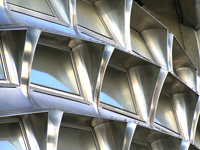 Domenig and the Austrian Architecture Domenig and the Austrian Architecture
Wolf D. Prix, Coop Himmelb(l)au
On YouTube the famous American Rapper Ice Cube can be viewed while he is explaining the Eames House in LA in a competent way.
I am questioning myself, whether a similar scene would be possible in Austria: DJ Ötzi or the Trackshittaz explain Günther Domenigs Steinhaus. Answer: no.
The word “important” as preliminary stage to being a star is used in an inflationary way today. Nevertheless I insist that Günther Domenig was one of the most important Austrian architects.
Important in terms of being weighty.
In my opinion the former Z-Bank branch in the Favoritenstraße in Vienna was one of his best buildings.
Long before the convoluted computer architects started using parametric tools to give their lame design a boost, Domenig had not only designed the first three- dimensional facade, but actually built it, too.
Himself, he has never differed from architecture and art, has been able to achieve a building that is uncompromising – located in the baroque thought - creating expressive space sequences and therefore connotes an important contribution to the Austrian Architecture. It’s amazing, that this building has only been possible in a peripheral district, and not in the city center of Vienna. |
 |
 |
  |
 Baltyk Tower in Poznan, Poland, by MVRDV Baltyk Tower in Poznan, Poland, by MVRDV |
 |
June 19, 2012
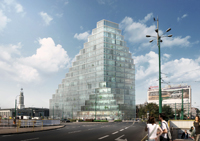 Investment corporation Sophia Sp. z.o.o and MVRDV present the Baltyk Tower, to be realised in the Polish city of Poznan. The office tower with a total surface of 25.000 m2 will be located at Rondo Kaponiera at the Eastern entrance to the historic city and will feature retail and a panorama restaurant with a proposed one room hotel. Completion is scheduled for 2014. Investment corporation Sophia Sp. z.o.o and MVRDV present the Baltyk Tower, to be realised in the Polish city of Poznan. The office tower with a total surface of 25.000 m2 will be located at Rondo Kaponiera at the Eastern entrance to the historic city and will feature retail and a panorama restaurant with a proposed one room hotel. Completion is scheduled for 2014.
The tower’s volume follows the maximal volume and height restriction of the site. This leads to a shape resulting in a totally different contour when approached from different sides. Towards the south a slope of cascading patios will offer outside spaces to the users of the building. The façade is envisioned floor-to-ceiling glass with vertical louvers of glass fibre concrete softening the impact of the sun without losing the vista over the city and zoo.
Baltyk Tower is the first building by MVRDV in Poland. Sophia Sp. z o.o is a joint venture of Garvest and Vox Group. Buro Happold is structural engineer, MEP and sustainability advisor for the envisioned BREEAM “Very Good” rating. Co-architect is Ultra Architects, a local office from Poznan. |
 |
 |
  |
 Haraldsplass Hospital in Bergen, Norway, by C.F. Møller Haraldsplass Hospital in Bergen, Norway, by C.F. Møller |
 |
June 15, 2012
 A whole new kind of hospital - that is how the jury described the winning proposal by C. F. Møller Architects for a new 10,000 m2 ward building for Haraldsplass Hospital in Bergen, Norway. Gone are the traditional hospital corridors, to be replaced by open common areas and efficient logistics. A whole new kind of hospital - that is how the jury described the winning proposal by C. F. Møller Architects for a new 10,000 m2 ward building for Haraldsplass Hospital in Bergen, Norway. Gone are the traditional hospital corridors, to be replaced by open common areas and efficient logistics.
Haraldsplass Hospital was built in 1986 and has approximately 184 beds. The new building will cover 10,000 m2 and give the hospital a further 108 beds on three storeys. There will also be new underground parking facilities for approximately 400 cars.
The new building will lie at the foot of the Ulriken mountain, with the river Møllendalselven in front.
The jury praised the proposal’s innovative approach to hospital design: "Here the patient is placed in the centre, and given a place in a varied and beautiful landscape. The drawings show attractive new experiences for staff and patients alike, while the needs of relatives are accommodated in a beautiful and well-nuanced arrivals area."
In stark contrast to traditional hospital buildings, there are no long corridors. The wards are located around two large covered atria, which provide the setting for two different kinds of common areas: a public arrivals area with a reception, café, shop and seating area, and a more private space for patients and their guests only. |
 |
 |
  |
 Euro2012: the new stadiums Euro2012: the new stadiums |
 |
|
 |
 |
  |
 Kaap Skil, by Mecanoo, wins Daylight Award 2012 Kaap Skil, by Mecanoo, wins Daylight Award 2012 |
 |
June 3, 2012
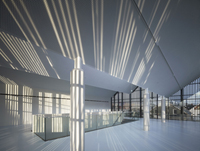 Mecanoo’s Kaap Skil, maritime and beachcombers’ museum, on the Dutch island of Texel has been awarded the Daylight Award 2012. The prestigious prize, awarded by the Living Daylights Foundation, honours projects that reach an optimum result in combining daylight, artificial light and design. One can almost feel the weather because of the transparency of the building, according to the jury. "Sun, clouds, thunder and rain: outdoors comes inside as perception and emotion and this is a core quality for a building with the Wadden Sea at your doorstep." Mecanoo’s Kaap Skil, maritime and beachcombers’ museum, on the Dutch island of Texel has been awarded the Daylight Award 2012. The prestigious prize, awarded by the Living Daylights Foundation, honours projects that reach an optimum result in combining daylight, artificial light and design. One can almost feel the weather because of the transparency of the building, according to the jury. "Sun, clouds, thunder and rain: outdoors comes inside as perception and emotion and this is a core quality for a building with the Wadden Sea at your doorstep."
Kaap Skil plays with daylight and the contrast between daylight and artificial light, lightness and darkness in various ways. The glass facade in front of the wooden boards affords an inviting view of the famous North Holland skies to visitors of the museum café. Inside the building, these boards cast a linear pattern of daylight and shadow creating an atmosphere infused with light and shelter. |
 |
 |
  |
 Now open the Serpentine Gallery Pavilion 2012 Now open the Serpentine Gallery Pavilion 2012 |
 |
June 1, 2012
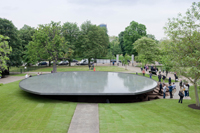 Now open in London, the 2012 Serpentine Gallery Pavilion designed by Herzog & de Meuron and Ai Weiwei. It is the twelfth commission in the Gallery’s annual series, the world’s first and most ambitious architectural programme of its kind. Now open in London, the 2012 Serpentine Gallery Pavilion designed by Herzog & de Meuron and Ai Weiwei. It is the twelfth commission in the Gallery’s annual series, the world’s first and most ambitious architectural programme of its kind.
The design team responsible for the celebrated Beijing National Stadium, which was built for the 2008 Olympic Games and won the prestigeous RIBA Lubetkin Prize, will come together again in London in 2012 in a special development of the Serpentine’s acclaimed annual commission which will be presented as part of the London 2012 Festival, the culmination of the Cultural Olympiad. The Pavilion will be Herzog & de Meuron and Ai Weiwei’s first collaborative built structure in the UK.
This year’s Pavilion take visitors beneath the Serpentine’s lawn to explore the hidden history of its previous Pavilions. Eleven columns characterising each past Pavilion and a twelfth column will support a floating platform roof 1.5 metres above ground. Taking an archaeological approach, the architects have created a design that inspire visitors to look beneath the surface of the park as well as back in time across the ghosts of the earlier structures.
You can follow on AR's dossier the updates with new photos and drawings. |
 |
 |
  |
 Foster + Partners to design Musée de la Romanitée Narbonne Foster + Partners to design Musée de la Romanitée Narbonne |
 |
May 21, 2012
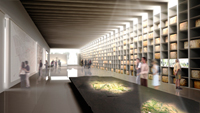 Following an international competition, Foster + Partners, working with museum designer Adrien Gardere, is designing a new museum for Roman artefacts in the city of Narbonne, southern France. Following an international competition, Foster + Partners, working with museum designer Adrien Gardere, is designing a new museum for Roman artefacts in the city of Narbonne, southern France.
The building incorporates galleries for permanent and temporary exhibitions, a multimedia education centre and library, as well as administration, restoration and storage facilities. These spaces are arranged over a single storey and are unified beneath a concrete roof canopy, which provides thermal mass and contributes to a comprehensive environmental strategy. The canopy is elevated above a clerestory, punctuated with light wells and extends to shade a wide public plaza around the museum.
The Musée de la Romanitée will be a new landmark at the entrance to the city, on a site adjacent to the Canal du Midi – the landscaping reinforces the connection with the water to create a tranquil natural setting and, inspired by formal French gardens and the Roman courtyard, features an amphitheatre for open-air displays and events. |
 |
 |
  |
 BIG designs Cross # Towers in Seoul, South Korea BIG designs Cross # Towers in Seoul, South Korea |
 |
May 20, 2012
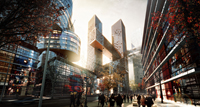 Situated at the south-east edge of the Yongsan master plan designed by Studio Libeskind for the Korean development group Dreamhub, BIG’s Cross # Towers will contribute to the developing skyline of Seoul and become a recognizable marker of the new cultural and commercial center of the city. BIG was selected to submit a design proposal for Yongsan International Business District among 19 international offices, including REX, Dominique Perrault, SOM and MVRDV. Situated at the south-east edge of the Yongsan master plan designed by Studio Libeskind for the Korean development group Dreamhub, BIG’s Cross # Towers will contribute to the developing skyline of Seoul and become a recognizable marker of the new cultural and commercial center of the city. BIG was selected to submit a design proposal for Yongsan International Business District among 19 international offices, including REX, Dominique Perrault, SOM and MVRDV.
The 21,000 m2 site is positioned next to the existing urban fabric in the future development zones of the Yongsan master plan. BIG’s design includes two elegant towers with a height of 214 and 204m. To meet the height requirements of the site, the exceeding building mass is transformed into an upper and lower horizontal bar, which bridge the two towers at 140m and 70 m height. The two towers are additionally connected through the arrival bar at the ground level - and a courtyard below ground. |
 |
 |
  |
 20 years of MVRDV 20 years of MVRDV |
 |
May 12, 2012
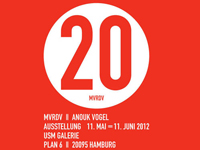 Today a small retrospective exhibition of MVRDV opened at byUSM in Hamburg. The exhibition is the price given for being elected “A&W-Architect of the Year” by the readers and online users of Germany’s reputed magazine Architektur&Wohnen. Winy Maas, Jacob van Rijs and Nathalie de Vries accepted yesterday the award and opened the exhibition. It is an overview of 20 years of the work of MVRDV in quotes, models, images, books and films. A small installation features a variety of models that have not been exhibited before. The show is open until June 11th and part of the Hamburger Architektur Sommer, it is planned to travel. Today a small retrospective exhibition of MVRDV opened at byUSM in Hamburg. The exhibition is the price given for being elected “A&W-Architect of the Year” by the readers and online users of Germany’s reputed magazine Architektur&Wohnen. Winy Maas, Jacob van Rijs and Nathalie de Vries accepted yesterday the award and opened the exhibition. It is an overview of 20 years of the work of MVRDV in quotes, models, images, books and films. A small installation features a variety of models that have not been exhibited before. The show is open until June 11th and part of the Hamburger Architektur Sommer, it is planned to travel.
The readers of German magazine Architektur & Wohnen have chosen MVRDV "A&W Architeckt des Jahres 2012" against David Chipperfield Architects and Snøhetta.
As all the collective thinking is forward oriented, the task of a retrospective of own work seemed paradox, even more to do it on a small scale without room for a deeper analysis of the past. |
 |
 |
  |
 The Trianel Corporate Centre in Aachen by gmp The Trianel Corporate Centre in Aachen by gmp |
 |
May 8, 2012
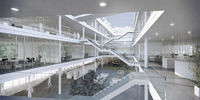 The jury of the competition for the Corporate Center of the Trianel municipal utilities network has selected the submission by architects von Gerkan, Marg and Partners (gmp) as the winning entry. The new building is located along a major road next to the Tivoli stadium. From 2013 on it is to be built in two phases, the first of which comprises 9,600 square metres of gross floor area and will accommodate 400 members of staff. In the second, optional phase the building can be extended by 4,800 square metres to accommodate a further 200 employees. The building’s sustainability concept merits a silver DGNB certificate. The gmp design team includes a DGNB-accredited auditor, who advises on the applicable criteria. The jury of the competition for the Corporate Center of the Trianel municipal utilities network has selected the submission by architects von Gerkan, Marg and Partners (gmp) as the winning entry. The new building is located along a major road next to the Tivoli stadium. From 2013 on it is to be built in two phases, the first of which comprises 9,600 square metres of gross floor area and will accommodate 400 members of staff. In the second, optional phase the building can be extended by 4,800 square metres to accommodate a further 200 employees. The building’s sustainability concept merits a silver DGNB certificate. The gmp design team includes a DGNB-accredited auditor, who advises on the applicable criteria.
From an urban design point of view, the four-storey building with its tranquil trapeze-shaped structure acts as a counterpoise to the dominating stadium and the varied architecural styles of the neighborhood. The generously glazed facades open up views into the park to the south of the building. The white horizontal solar screening slats made of aluminium profiles create a calm overall appearance, which has a harmonising effect on the surroundings. |
 |
 |
  |
 New multidisciplinary art institution in Richmond (VA) designed by Steven Holl Architects New multidisciplinary art institution in Richmond (VA) designed by Steven Holl Architects |
 |
April 29, 2012
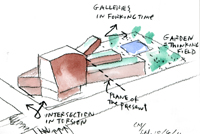 Virginia Commonwealth University (VCU) unveiled the design for a new Institute for Contemporary Art (ICA) designed by Steven Holl and Chris McVoy. Part exhibition and performance space, part lab and incubator, the 38,000-square-foot building will feature a series of flexible programming spaces for the presentation of visual art, theater, music, dance and film for both on-campus and public audiences. The facility also encompasses a 247-seat auditorium, outdoor plazas, a sculpture garden, classrooms, a café and administrative offices. Scheduled to open in 2015, the ICA will be located on a site defined by Belvidere and Broad Streets, one of Richmond’s busiest intersections, and will feature dual entrances—one facing Richmond and the other fronting VCU’s campus—to advance its mission as an educational and cultural resource for both the University and the City. Virginia Commonwealth University (VCU) unveiled the design for a new Institute for Contemporary Art (ICA) designed by Steven Holl and Chris McVoy. Part exhibition and performance space, part lab and incubator, the 38,000-square-foot building will feature a series of flexible programming spaces for the presentation of visual art, theater, music, dance and film for both on-campus and public audiences. The facility also encompasses a 247-seat auditorium, outdoor plazas, a sculpture garden, classrooms, a café and administrative offices. Scheduled to open in 2015, the ICA will be located on a site defined by Belvidere and Broad Streets, one of Richmond’s busiest intersections, and will feature dual entrances—one facing Richmond and the other fronting VCU’s campus—to advance its mission as an educational and cultural resource for both the University and the City.
The ICA will enhance and expand the role of the arts on campus, serving as both an academic and extracurricular resource for students and faculty from every department, including VCU’s acclaimed School of the Arts (VCUarts), which U.S. News & World Report ranked as the top public university graduate art program in the country. |
 |
 |
  |
 New museum under construction in Datong, China, by Foster + Partners New museum under construction in Datong, China, by Foster + Partners |
 |
April 28, 2012
 Construction is underway at Datong Art Museum – China’s ‘Museum of the 21st Century’. The museum will open in 2013 to represent China in the ‘Beyond the Building’ Basel Art international tour. Construction is underway at Datong Art Museum – China’s ‘Museum of the 21st Century’. The museum will open in 2013 to represent China in the ‘Beyond the Building’ Basel Art international tour.
The 32,000-square-metre venue is one of four major new buildings within Datong New City’s cultural plaza. Its centrepiece is the Grand Gallery, a heroically scaled, top-lit exhibition space measuring 37 metres high and spanning almost 80 metres, in which artists will be commissioned to create large-scale works of art.
Externally, the building’s form is conceived as an erupted landscape. The entire museum is sunk into the ground with only the peaks of the roof visible at ground level. The roof is clad in earth-toned Corten steel, which will weather naturally over time. The building relates in scale to the three other cultural buildings in the group, balancing the overall composition of the masterplan while maximising the internal volume of the Grand Gallery.
Luke Fox, a senior partner at Foster + Partners: “We are delighted to reveal designs for the new museum and look forward to working with the city to take the project to the next stage. When complete, Datong’s new quarter will be the centre of the city’s cultural life, with the new museum as its ‘urban room’ – a dynamic space, open to everyone to meet and enjoy its different displays and activities.” |
 |
 |
  |
 BIG contributes to Vancouver Skyline BIG contributes to Vancouver Skyline |
 |
April 23, 2012
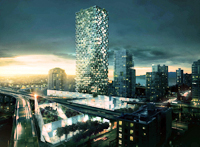 The 490-foot-tall Beach and Howe mixed-use tower by BIG + Westbank + Dialog + Cobalt + PFS + Buro Happold + Glotman Simpson and local architect James Cheng marks the entry point to downtown Vancouver, forming a welcoming gateway to the city, while adding another unique structure to the Vancouver skyline. The 490-foot-tall Beach and Howe mixed-use tower by BIG + Westbank + Dialog + Cobalt + PFS + Buro Happold + Glotman Simpson and local architect James Cheng marks the entry point to downtown Vancouver, forming a welcoming gateway to the city, while adding another unique structure to the Vancouver skyline.
BIG’s proposal, named after its location on the corner of Howe & Beach next to the Granville Street Bridge in downtown Vancouver, calls for 600 residential units occupying the 49-story tower, which would become one of the city’s fourth tallest buildings. The tower is situated on a nine-story podium base offering market- rental housing with a mix of commercial and retail space.
BIG was commissioned by Canada’s premier real estate developer Westbank, established in 1992, with over $10 billion of projects completed or under devel- opment, including the Shangri-La luxury hotels in Vancouver and Toronto. |
 |
 |
  |
 Two new public buildings in Georgia by J. Mayer H. Two new public buildings in Georgia by J. Mayer H. |
 |
April 21, 2012
 Two new public buildings are completed in the city of Mestia, Georgia, by J. Mayer H. Architects. Two new public buildings are completed in the city of Mestia, Georgia, by J. Mayer H. Architects.
The House of Justice serves as a two storey civic centre for the people of Mestia, a village with a strong cultural heritage. Its concrete structure frames the spectacular landscape of the Caucasian Mountains. The building is part of an ensemble of new public buildings around the main central public plaza.
The Police Station is situated in the heart of the old town of Mestia, next to the newly built city-hall. Its towerlike shape pays homage to the medieval stone towers which are traditional to Mestia’s mountainside region. The facade is comprised of prefabricated textured concrete and large openings which offer a maximum of transparency. |
 |
 |
  |
 gmp wins competition to design the new Karlsruhe Medical Centre gmp wins competition to design the new Karlsruhe Medical Centre |
 |
April 16, 2012
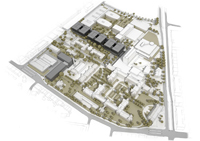 The architects von Gerkan, Marg and Partners have won first prize with their design for the new buildings of the Karlsruhe Medical Centre. The competition focused on the 2015 master plan and was open to 15 selected practices. The briefing called for the construction of a new central building in order to give more structure to the hospital precinct - which consists of older buildings from the nineteenth century as well as later additions - and to improve the logistics of the Centre by constructing a new central catering facility and new institute buildings. According to the jury, gmp’s design fits particularly well with the existing buildings of the hospital precinct, while at the same time meeting all functional requirements. The architects von Gerkan, Marg and Partners have won first prize with their design for the new buildings of the Karlsruhe Medical Centre. The competition focused on the 2015 master plan and was open to 15 selected practices. The briefing called for the construction of a new central building in order to give more structure to the hospital precinct - which consists of older buildings from the nineteenth century as well as later additions - and to improve the logistics of the Centre by constructing a new central catering facility and new institute buildings. According to the jury, gmp’s design fits particularly well with the existing buildings of the hospital precinct, while at the same time meeting all functional requirements.
The central building, called “Haus M”, creates a new focal point for the hospital precinct. It contains 24 operating theatres, intensive care units, rooms for medical and functional services, the new central sterilisation unit as well as wards, providing a total net floor space of 20,500 square metres. Together with the buildings for the new central catering facility and the institute building, the total project area measures 27,500 square metres. |
 |
 |
  |
 Wang Shu of China is the 2012 Pritzker Architecture Prize Laureate Wang Shu of China is the 2012 Pritzker Architecture Prize Laureate |
 |
February 28, 2012
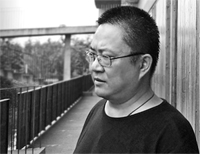 Wang Shu, a 48 year old architect whose architectural practice is based in Hangzhou, The People’s Republic of China, will be the recipient of the 2012 Pritzker Architecture Prize, it was announced today by Thomas J. Pritzker, chairman of The Hyatt Foundation which sponsors the prize. The formal ceremony for what has come to be known throughout the world as architecture’s highest honor will be in Beijing on May 25. Wang Shu, a 48 year old architect whose architectural practice is based in Hangzhou, The People’s Republic of China, will be the recipient of the 2012 Pritzker Architecture Prize, it was announced today by Thomas J. Pritzker, chairman of The Hyatt Foundation which sponsors the prize. The formal ceremony for what has come to be known throughout the world as architecture’s highest honor will be in Beijing on May 25.
In announcing the jury’s choice, Pritzker elaborated, “The fact that an architect from China has been selected by the jury, represents a significant step in acknowledging the role that China will play in the development of architectural ideals. In addition, over the coming decades China's success at urbanization will be important to China and to the world. This urbanization, like urbanization around the world, needs to be in harmony with local needs and culture. China's unprecedented opportunities for urban planning and design will want to be in harmony with both its long and unique traditions of the past and with its future needs for sustainable development.”
» Read more |
 |
 |
  |
 Serpentine Gallery Pavilion 2012 Serpentine Gallery Pavilion 2012 |
 |
February 20, 2012
 Herzog & de Meuron and Ai Weiwei will create the 2012 Serpentine Gallery Pavilion. It will be the twelfth commission in the Gallery’s annual series, the world’s first and most ambitious architectural programme of its kind. Herzog & de Meuron and Ai Weiwei will create the 2012 Serpentine Gallery Pavilion. It will be the twelfth commission in the Gallery’s annual series, the world’s first and most ambitious architectural programme of its kind.
The design team responsible for the celebrated Beijing National Stadium, which was built for the 2008 Olympic Games and won the prestigeous RIBA Lubetkin Prize, will come together again in London in 2012 in a special development of the Serpentine’s acclaimed annual commission which will be presented as part of the London 2012 Festival, the culmination of the Cultural Olympiad. The Pavilion will be Herzog & de Meuron and Ai Weiwei’s first collaborative built structure in the UK.
This year’s Pavilion will take visitors beneath the Serpentine’s lawn to explore the hidden history of its previous Pavilions. Eleven columns characterising each past Pavilion and a twelfth column will support a floating platform roof 1.5 metres above ground. Taking an archaeological approach, the architects have created a design that will inspire visitors to look beneath the surface of the park as well as back in time across the ghosts of the earlier structures.
You can follow on AR's dossier the updates about the development of the project and works. |
 |
 |
  |
 Jameson House in Vancouver by Foster + Partners Jameson House in Vancouver by Foster + Partners |
 |
February 7, 2012
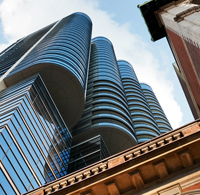 Jameson House is a new 35-storey mixed-use tower in the heart of Vancouver and includes the first residential development to be completed by the practice in North America – completed at the end of last year, already the building is now almost fully occupied. The project combines the restoration of heritage buildings with new construction: the lower level offices and shops knit with the existing streetscape to reinvigorate the downtown neighbourhood, while the apartments above face dramatic views of the bay and create a new landmark on the skyline. Jameson House is a new 35-storey mixed-use tower in the heart of Vancouver and includes the first residential development to be completed by the practice in North America – completed at the end of last year, already the building is now almost fully occupied. The project combines the restoration of heritage buildings with new construction: the lower level offices and shops knit with the existing streetscape to reinvigorate the downtown neighbourhood, while the apartments above face dramatic views of the bay and create a new landmark on the skyline.
Fusing old and new, the site connects the city’s financial centre with its emerging creative hub, and the scheme integrates two 1920s Beaux Arts structures: the entire internal double-height volume of the A-listed Ceperley Rounsfell Building has been returned to its original configuration and the facade of the B-listed Royal Financial Building has been retained.
The development comprises eleven storeys of offices and shops, topped by twenty-three storeys of apartments. The tower’s form articulates these different functions: the first two storeys continue the row of shop units at street level, while the uppermost office floor aligns with the cornice line of the adjacent building. Contrasting with the flush facade of the offices, the residential floors curve outwards in four wide bays, which are staggered to allow daylight to reach neighbouring buildings and oriented to provide uninterrupted views of the landscape. |
 |
 |
  |
 Sports Concert Complex, Baku, Azerbaijan by gmp Sports Concert Complex, Baku, Azerbaijan by gmp |
 |
February 5, 2012
 In May 2012, the Eurovision Song Contest will take place in Azerbaijan’s capital Baku at Crystal Hall. Alpine Bau Deutschland GmbH, the general contractor for the project, was contracted on August 2nd, 2011 to design and implement a multipurpose event-venue that is meant to accommodate 25,000 spectators. In May 2012, the Eurovision Song Contest will take place in Azerbaijan’s capital Baku at Crystal Hall. Alpine Bau Deutschland GmbH, the general contractor for the project, was contracted on August 2nd, 2011 to design and implement a multipurpose event-venue that is meant to accommodate 25,000 spectators.
This challenging task was undertaken by combining the efforts of gmp · Architekten von Gerkan, Marg und Partner, Alpine Bau Deutschland AG, and Nüssli International AG.
The Eurovision Song Contest takes place every year, which means that this striking crystal-shaped building on the peninsula near the city centre, right in the Caspian Sea and in the direct vicinity of one of the world’s highest flagpoles, had to be designed and constructed within a period of just eight months. The building is not a concert hall in the classical sense but a multi-functional indoor arena, which is intended to be a longer-term facility. Normally, event venues of comparable size, such as a football stadium, will require 4 to 5 years for design and construction. |
 |
 |
  |
 New Design Museum in London New Design Museum in London |
 |
February 4, 2012
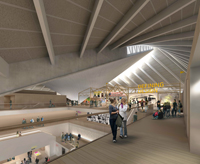 The Design Museum unveiled plans to create the world’s leading museum of design and architecture at the former Commonwealth Institute building in Kensington, London. Designs for the site have been produced by two of the world’s most innovative architectural practices: John Pawson has redesigned the interior of the Grade 2* listed building and OMA has planned the surrounding residential development. The Design Museum unveiled plans to create the world’s leading museum of design and architecture at the former Commonwealth Institute building in Kensington, London. Designs for the site have been produced by two of the world’s most innovative architectural practices: John Pawson has redesigned the interior of the Grade 2* listed building and OMA has planned the surrounding residential development.
The move will allow the new Design Museum to become a world class centre for design, nurturing British talent and its international influence on design of all kinds. It will bring the museum into Kensington’s cultural quarter, where it will join the V&A, Science Museum, Natural History Museum, Royal College of Art and Serpentine Gallery, creating a platform for the promotion and support of the next generation of creative talent.
The new building will open to the public in 2014, giving the Design Museum three times more space to showcase its unique collection. The museum aims to double its visitor numbers to 500,000 a year, and will greatly expand its education and public events programme with state of the art facilities. |
 |
 |
  |
 Give more. Schmidt Hammer Lassen architects exhibition opens in Berlin Give more. Schmidt Hammer Lassen architects exhibition opens in Berlin |
 |
February 2, 2012
 On the 3rd of February 2012, renowned Architecture Forum Aedes Gallery in Berlin opens an exhibition with the title Give more featuring projects by schmidt hammer lassen architects. Give more features nine selected architecture projects paraphrasing nine visions on how architecture can give more by adding value and positive change for people, places, and communities. On the 3rd of February 2012, renowned Architecture Forum Aedes Gallery in Berlin opens an exhibition with the title Give more featuring projects by schmidt hammer lassen architects. Give more features nine selected architecture projects paraphrasing nine visions on how architecture can give more by adding value and positive change for people, places, and communities.
The approach of schmidt hammer lassen architects is that architecture creates change – architecture is not a goal in itself. schmidt hammer lassen architects strives to design buildings that meet the challenges of modern society; that shape the life for people and organisations; that make people come together in new ways.
“With the exhibition, we would like to focus on the significance of architecture as a tool for designing the framework for life. The essence of architecture is not merely a question of aesthetics, but to a greater extent a question of the value and meaning which architecture offers its users and society,” said Founding Partner at schmidt hammer lassen architects Mr. Bjarne Hammer.
The exhibition will run from 3rd February to 15th March 2012.
» Read more |
 |
 |
  |
 Louvre Museum, Department of Islamic Arts Louvre Museum, Department of Islamic Arts |
 |
January 20, 2012
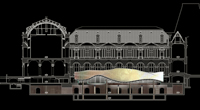 After the 80s enlargement planned by I.M. Pei, the Louvre Museum in Paris continues to expand and be renewed thanks to a new contemporary architectural work. After the 80s enlargement planned by I.M. Pei, the Louvre Museum in Paris continues to expand and be renewed thanks to a new contemporary architectural work.
As a matter of fact in the Summer of 2012, the Department of Islamic Arts opens in the Cour Visconti. Two new exhibition floors have been built to the plans of 2005 competition winners Rudy Ricciotti and Mario Bellini. The two-storey wing will be covered with a glass "veil", wrapped in a gold metal mesh. A perfect background for the exhibits: different from the Museum façades, yet elegantly integrated with them. |
 |
 |
  |
 Foster + Partners wins competition to design Ourense AVE Station Foster + Partners wins competition to design Ourense AVE Station |
 |
December 27, 2011
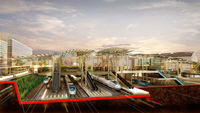 Foster + Partners, in a joint venture with engineers, G.O.C. and Cabanelas Castelo Architects, has won an international competition to design a new high-speed rail station in the city of Ourense in Galicia, north western Spain. The design combines transport infrastructure with a new park, which will create a major new public space in the city and open up pedestrian links between the districts on each side of the tracks. Foster + Partners, in a joint venture with engineers, G.O.C. and Cabanelas Castelo Architects, has won an international competition to design a new high-speed rail station in the city of Ourense in Galicia, north western Spain. The design combines transport infrastructure with a new park, which will create a major new public space in the city and open up pedestrian links between the districts on each side of the tracks.
The high-speed AVE train station is located over the existing track level and integrates a bus station and parking area below. Above ground, the station’s presence is discreet and transparent, with glazed facades that allow views through to the mountains beyond. The concourse is sheltered beneath a sequence of lightweight roof canopies, which rise in a sweeping arc over the station and extend to shade the plaza and entrance to the park. The underside of the roof is reflective to bounce daylight down to the platforms, and between each canopy is a glazed, linear opening.
The park extends from the station plaza and is intersected by pools of water and a formal network of pedestrian walkways, which echo the alignment of the tracks and connect the streets of Barrio del Puente to Barrio Veintiuno. |
 |
 |
  |
 Chinese/German Eco-Park in Qingdao by gmp Chinese/German Eco-Park in Qingdao by gmp |
 |
December 12, 2011
 An ecologically designed city quarter for living and working is currently being developed in China’s Qingdao, on the coast of the Yellow Sea, to plans by architects von Gerkan, Marg and Partners (gmp). The foundation stone was laid by Ernst Burgbacher, Parliamentary State Secretary of the Federal Ministry of Economics and Wang Chao, the Chinese Vice-Minister of Economics. The construction of the Chinese/German Eco-Park in Qingdao goes back to an agreement between the two countries, which was signed by the Federal Ministry for Economics and the Federal Ministry for the Environment during Angela Merkel’s state visit in July 2010; it is scheduled for completion in 2015. An ecologically designed city quarter for living and working is currently being developed in China’s Qingdao, on the coast of the Yellow Sea, to plans by architects von Gerkan, Marg and Partners (gmp). The foundation stone was laid by Ernst Burgbacher, Parliamentary State Secretary of the Federal Ministry of Economics and Wang Chao, the Chinese Vice-Minister of Economics. The construction of the Chinese/German Eco-Park in Qingdao goes back to an agreement between the two countries, which was signed by the Federal Ministry for Economics and the Federal Ministry for the Environment during Angela Merkel’s state visit in July 2010; it is scheduled for completion in 2015.
With support from the German Society for Sustainable Building (DGNB) and Transsolar Consultants, gmp developed a list of criteria and measures integrating the highest possible proportion of regenerative energy sources into the master plan: in addition to wind and water power, as well as geothermal energy, the Eco-Park focuses particularly on solar energy. The conditions for this are very good in Qingdao as it has an above-average number of days of sunshine. |
 |
 |
  |
 BIG + OFF win the competition to design the Research Centre of the University of Jussieu in Paris BIG + OFF win the competition to design the Research Centre of the University of Jussieu in Paris |
 |
December 8, 2011
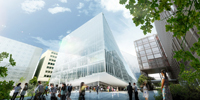 BIG + Paris-based architects OFF, engineers Buro Happold, consultants Michel Forgue and environmental engineer Franck Boutte is the winning team to design the new 15.000 m2 research centre for Sorbonne’s Scientific university Université Pierre et Marie Curie in Paris. BIG + Paris-based architects OFF, engineers Buro Happold, consultants Michel Forgue and environmental engineer Franck Boutte is the winning team to design the new 15.000 m2 research centre for Sorbonne’s Scientific university Université Pierre et Marie Curie in Paris.
The new multidisciplinary research centre, Paris PARC, located between Jean Nouvel’s Institut du Monde Arabe and the open green park of the Jussieu Campus will become a significant addition to the campus, strengthening the international appeal and openness of the leading French University for Science and Medicine. The facility will bring together academic scholars and the business community, while re-connecting the university physically and visually with the city of Paris. The winning team was honored as the best design among proposals from MVRDV, Lipsky Rollet, Mario Cucinella and Peripherique.
Paris PARC is located in the visual axis of the Notre Dame Cathedral in a dense context of university buildings from different historical periods. |
 |
 |
  |
 Schmidt Hammer Lassen. Office Tower in Warsaw Schmidt Hammer Lassen. Office Tower in Warsaw |
 |
November 23, 2011
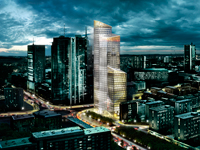 schmidt hammer lassen architects has won the international architectural competition to design a 188 meter office tower in the financial district of central Warsaw, Poland. The 60,000 m2 high-rise building is to replace the existing ‘Ilmet’ building and will stand out as a modern landmark clearly identifiable in the Warsaw skyline by its unique elegant shape and appearance. schmidt hammer lassen architects has won the international architectural competition to design a 188 meter office tower in the financial district of central Warsaw, Poland. The 60,000 m2 high-rise building is to replace the existing ‘Ilmet’ building and will stand out as a modern landmark clearly identifiable in the Warsaw skyline by its unique elegant shape and appearance.
“The object of the competition was to design an office tower that will be a new landmark in the Warsaw skyline while at the same time capturing the full potential of the outstanding historic location,” said Founding Partner of schmidt hammer lassen architects, Mr John Lassen.
The building consists of three individually stepped rectangular volumes with increasing heights towards the east. The façades create a subtle rhythm in the cityscape by slightly shifting inwards and outwards, and the inclined rooflines preserve optimal light conditions for the adjacent buildings. |
 |
 |
  |
 McLaren Production Centre by Foster + Partners McLaren Production Centre by Foster + Partners |
 |
November 21, 2011
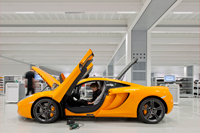 The McLaren Production Centre, the second building designed by Foster + Partners at McLaren’s Woking site, has been officially unveiled by Prime Minister David Cameron. The 34,500-square metre facility will house the assembly of all future McLaren Automotive road cars, including the recently- launched MP4-12C high-performance sports car; it has already led to the creation of a large number of skilled manufacturing jobs. The McLaren Production Centre, the second building designed by Foster + Partners at McLaren’s Woking site, has been officially unveiled by Prime Minister David Cameron. The 34,500-square metre facility will house the assembly of all future McLaren Automotive road cars, including the recently- launched MP4-12C high-performance sports car; it has already led to the creation of a large number of skilled manufacturing jobs.
The state-of-the-art McLaren Production Centre is located to the south-west of the existing McLaren Technology Centre. The two buildings are connected by a subterranean walkway and share a common language of details and materials. The entrance, echoing the existing building, is a circular glass drum beneath the overhang of the roof canopy.
As a manufacturing facility, the building is inherently flexible, with a wide span between columns and fully integrated services.
» Read more |
 |
 |
  |
 Sarpi Border Checkpoint in Georgia Sarpi Border Checkpoint in Georgia |
 |
November 17, 2011
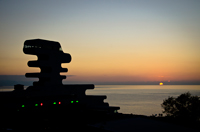 November 2011 marks the completion of Sarpi Border Checkpoint. Designed by J. MAYER H. architects the customs checkpoint is situated at the Georgian border to Turkey, at the shore of the Black Sea. November 2011 marks the completion of Sarpi Border Checkpoint. Designed by J. MAYER H. architects the customs checkpoint is situated at the Georgian border to Turkey, at the shore of the Black Sea.
With its cantilevering terraces, the tower is used as a viewing platform, with multiple levels overlooking the water and the steep part of the coastline.
In addition to the regular customs facilities, the structure also houses a cafeteria, staff rooms and a conference room.
The building welcomes visitors to Georgia, representing the progressive upsurge of the country. |
 |
 |
  |
 Virgin Galactic Gateway to Space Virgin Galactic Gateway to Space |
 |
November 5, 2011
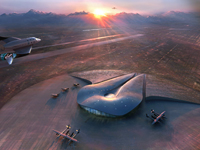 Spaceport America in New Mexico – the world’s first commercial space terminal - is now open. Spaceport America in New Mexico – the world’s first commercial space terminal - is now open.
The Virgin Galactic Gateway to Space, a combined terminal and hangar facility, will support up to two WhiteKnightTwo and five SpaceShipTwo vehicles. The 120,000 square-foot building has been designed by Foster + Partners, working with URS Corporation and New Mexico architects SMPC.
The Gateway will also house all astronaut preparation and celebration facilities, a mission control centre and a friends and family area. Entrance is via a deep channel cut into the landscape and its retaining walls form an exhibition space that documents a history of space exploration alongside the story of the region.
Sir Richard Branson said: "Today is another history-making day for Virgin Galactic. We are here with a group of incredible people who are helping us lead the way in creating one of the most important new industrial sectors of the 21st century. We’ve never wavered in our commitment to the monumental task of pioneering safe, affordable and clean access to space, or to demonstrate that we mean business at each step along the way.” |
 |
 |
  |
 The inauguration of the new Palacongressi di Rimini conference center by gmp The inauguration of the new Palacongressi di Rimini conference center by gmp |
 |
October 16, 2011
 The new Palacongressi di Rimini conference center has been officially inaugurated. The center, which was designed by von Gerkan, Marg and Partners Architects (gmp), who had already designed the Rimini exhibition center, was completed in 2010. The new Palacongressi di Rimini conference center has been officially inaugurated. The center, which was designed by von Gerkan, Marg and Partners Architects (gmp), who had already designed the Rimini exhibition center, was completed in 2010.
The overall complex is made up of four distinct areas which contain large and small halls on two levels. The Palacongressi di Rimini picks up on the local pattern language – the colors of the wet and dry Adriatic beaches, the turquoise blue and greenish water of the Adriatic. The shape of the amphitheater reflects that of a “conchiglia” a local name for the seashell with a pearl at its center.
The conference center, which is the largest in Italy, follows an innovative concept in that it combines conferences with exhibitions; at the same time it is also an urban design pilot project for a cultural center which has been planned on the other side of the road and which includes a concert hall by Mario Botta.
The site of the former exhibition venue has been turned into a green central area with a lake that extends beneath the new bridge, along the extended park and links up with the city center. |
 |
 |
  |
 Opening of Campus Aarhus N by Schmidt Hammer Lassen Opening of Campus Aarhus N by Schmidt Hammer Lassen |
 |
October 12, 2011
 Campus Aarhus N, the latest campus of VIA University College in Denmark, is officially opened by Her Royal Highness Crown Princess Mary on October 11th 2011. The approx 27,000 m2 building, designed by schmidt hammer lassen architects, unifies VIA’s healthcare educations previously located different places in Aarhus. The new campus building offers facilities for the six fields of study that support knowledge sharing and synergy between the educations. Campus Aarhus N, the latest campus of VIA University College in Denmark, is officially opened by Her Royal Highness Crown Princess Mary on October 11th 2011. The approx 27,000 m2 building, designed by schmidt hammer lassen architects, unifies VIA’s healthcare educations previously located different places in Aarhus. The new campus building offers facilities for the six fields of study that support knowledge sharing and synergy between the educations.
“In our architectural approach, we have taken the client’s vision of creating one unifying building very seriously,” explained Mr Bjarne Hammer, Founding Partner of schmidt hammer lassen architects, and he continued: “A modern learning facility should support knowledge sharing and interdisciplinary exchange, and the architecture should offer the opportunity for the students to meet across fields of study.” |
 |
 |
  |
 Opening of Coop Himmelb(l)au’s Cinema Center in Busan, South Korea Opening of Coop Himmelb(l)au’s Cinema Center in Busan, South Korea |
 |
October 8, 2011
 The Cinema Center in Busan, South Korea, designed by Wolf D. Prix/COOP HIMMELB(L)AU, the new home of the Busan Film Festival (BIFF), was inaugurated with a grand opening in the presence of the president of South Korea. The innovative building combines open space, cultural program, entertainment, technology and architecture in a novel way. Over 800 guests, among them the Mayor of Busan, the cultural minister, the sports minister as well as film celebrities attended the ceremony. The Cinema Center in Busan, South Korea, designed by Wolf D. Prix/COOP HIMMELB(L)AU, the new home of the Busan Film Festival (BIFF), was inaugurated with a grand opening in the presence of the president of South Korea. The innovative building combines open space, cultural program, entertainment, technology and architecture in a novel way. Over 800 guests, among them the Mayor of Busan, the cultural minister, the sports minister as well as film celebrities attended the ceremony.
The president of South Korea Lee Myung-bak emphasized in his opening speech the architectural achievement accomplished with the special feature of the Busan Cinema Center – the worldwide largest cantilivered roof. „Since the Busan Cinema Center is the greatest and the most beautiful one for exclusive cinema use, the Busan International Film festival will be top 3 film festival in the world“, he added.
» Read more |
 |
 |
  |
 Steve Jobs 1955-2011 Steve Jobs 1955-2011 |
 |
October 6, 2011
A tribute from Lord Foster to Steve Jobs, Chairman of Apple
With my colleagues I would like to pay tribute to Steve Jobs. Like so many millions our lives have been profoundly and positively influenced by the innovations pioneered by Steve and Apple, names which are inseparable.
We were greatly privileged to know Steve as a person, as a friend and in every way so much more than a client. Steve was an inspiration and a role model. He encouraged us to develop new ways of looking at design to reflect his unique ability to weave backwards and forwards between grand strategy and the minutiae of the tiniest of internal fittings. For him no detail was small in its significance and he would be simultaneously questioning the headlines of our project together whilst he delved into its fine print.
He was the ultimate perfectionist and demanded of himself as he demanded of others. We are better as individuals and certainly wiser as architects through the experience of the last two years and more of working for him. His participation was so intense and creative that our memory will be that of working with one of the truly great designers and mentors.
Norman Foster
Architect
Chairman + Founder of Foster + Partners |
 |
 |
  |
 OMA-designed Maggie’s is open in Glasgow OMA-designed Maggie’s is open in Glasgow |
 |
October 6, 2011
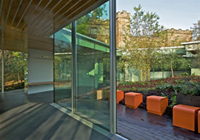 OMA and the Maggie’s charity open a new centre on the grounds of Gartnaval Royal Infirmary in Glasgow. Maggie’s is designed to provide emotional and psychological support to those affected by cancer in the greater Glasgow area. OMA and the Maggie’s charity open a new centre on the grounds of Gartnaval Royal Infirmary in Glasgow. Maggie’s is designed to provide emotional and psychological support to those affected by cancer in the greater Glasgow area.
A ring of loosely arranged interconnecting spaces contains counselling rooms, a large multipurpose space, a kitchen, dining room and offices. By avoiding a familiar configuration of insular rooms, the fluent spatial sequence at Maggie’s Gartnaval fosters the sense of empathetic community central to the Maggie’s philosophy. Lily Jencks, the daughter of Maggie’s founders Charles Jencks and Maggie Keswick Jencks, designed the landscaping for the internal courtyard and the surrounding wooded knoll. Construction of Maggie’s was completed in under a year, and was funded by the sponsorship of the thousands who participated in sponsored Walk the Walk events.
» Read more |
 |
 |
  |
 Martin Luther Church in Hainburg, Austria, by Coop Himmelb(l)au Martin Luther Church in Hainburg, Austria, by Coop Himmelb(l)au |
 |
August 24, 2011
 In less than a year a protestant church was built in the centre of the Lower Austrian town Hainburg. The shape of the building is derived from that of a huge "table", with its entire roof construction resting on the legs of the "table" - four steel columns. Another key element is the ceiling of the prayer room: its design language has been developed from the shape of the curved roof of a neighboring Romanesque ossuary - the geometry of this century-old building is translated into a form, in line with the times, via today's digital instruments. In less than a year a protestant church was built in the centre of the Lower Austrian town Hainburg. The shape of the building is derived from that of a huge "table", with its entire roof construction resting on the legs of the "table" - four steel columns. Another key element is the ceiling of the prayer room: its design language has been developed from the shape of the curved roof of a neighboring Romanesque ossuary - the geometry of this century-old building is translated into a form, in line with the times, via today's digital instruments.
Like other projects of COOP HIMMELB(L)AU the roof elements of the church building were assembled in a shipyard. The implementation of the intricate geometries required specific technologies of metal-processing and manufacturing only available in shipbuilding industry. The reference to shipbuilding is at the same time also reminiscent of Le Corbusier who served as an important role model, not least because of his La Tourette monastery.
» Read more |
 |
 |
  |
 2011 Universiade in Shenzhen, China. Sports Center by gmp 2011 Universiade in Shenzhen, China. Sports Center by gmp |
 |
August 21, 2011
 To mark the occasion of the Universiade, which take place from 12th to 23rd August 2011, the Universiade sports center and Bao’an stadium is now open in Shenzhen, southern China. The international competitions to come up with a design for the buildings were won in 2006 and 2007 by the designs of architects von Gerkan, Marg and Partners (gmp). The Universiade sports center consists of a stadium, a multifunctional hall and a swimming pool. The stadium in the Bao’an district is designed as an athletics stadium. However, during the 2011 Universiade, it is being used for football matches. To mark the occasion of the Universiade, which take place from 12th to 23rd August 2011, the Universiade sports center and Bao’an stadium is now open in Shenzhen, southern China. The international competitions to come up with a design for the buildings were won in 2006 and 2007 by the designs of architects von Gerkan, Marg and Partners (gmp). The Universiade sports center consists of a stadium, a multifunctional hall and a swimming pool. The stadium in the Bao’an district is designed as an athletics stadium. However, during the 2011 Universiade, it is being used for football matches.
Universiades are World Games for students and are held every other year in winter and summer, hosted by the International University Sports Federation, the Fédération Internationale du Sport Universitaire (FISU). Going by the number of athletes participating, the summer Universiade is the second largest multi-sport event in the world after the Summer Olympics. It was announced in January 2007 that the 26th summer Universiade 2011 was to take place in Shenzhen.
» Read more |
 |
 |
  |
 Noorderpoort college in Stadskanaal to be a villa on the water Noorderpoort college in Stadskanaal to be a villa on the water |
 |
July 21, 2011
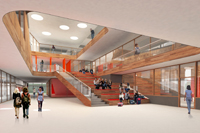 Mecanoo architecten has won the architectural selection for the new Noorderpoort regional community college in Stadskanaal, the Netherlands. The 8,500 m2 college is like a mansion with beautiful wetlands as a front lawn situated within the town's green heart. The community college provides education to 1300 students in the Engineering, Health care and Services sectors. Construction is to begin in 2012 with doors opening in 2014. Mecanoo architecten has won the architectural selection for the new Noorderpoort regional community college in Stadskanaal, the Netherlands. The 8,500 m2 college is like a mansion with beautiful wetlands as a front lawn situated within the town's green heart. The community college provides education to 1300 students in the Engineering, Health care and Services sectors. Construction is to begin in 2012 with doors opening in 2014.
The atrium is at the heart of the building and features a large grandstand. It is the most important meeting place and provides access to every floor. This is where the different departments present themselves with their showcase windows that provide a literal view of what the various disciplines have on offer. Noorderpoort is no traditional school but a modern educational environment where theory and practice are intertwined. The school is an exemplary model for the partnership between education and the business world. Several commercial businesses within the building contribute towards its multifunctionality.
» Read more |
 |
 |
  |
 Sports center for World Swimming Championships in Shanghai by gmp Sports center for World Swimming Championships in Shanghai by gmp |
 |
July 19, 2011
 The Shanghai Oriental Sports Center (SOSC) being open for the 14th FINA World Swimming Championships from 16th to 31st July 2011. The sports complex was designed and built by architects von Gerkan, Marg e Partner (gmp), who won the competitive bidding in 2008, and constructed it in under two and a half years. The Shanghai Oriental Sports Center (SOSC) being open for the 14th FINA World Swimming Championships from 16th to 31st July 2011. The sports complex was designed and built by architects von Gerkan, Marg e Partner (gmp), who won the competitive bidding in 2008, and constructed it in under two and a half years.
It consists of a hall stadium for several sports and cultural events, a natatorium (swimming hall), an outdoor swimming pool and a media centre. In keeping with a sustainable urban development policy, the SOSC was built on former industrial brownfield land along the Huangpu River.
The individual venues are designed so that after the Swimming Championships, they can be used for a variety of other purposes.
» Read more |
 |
 |
  |
 Parque lineal de La Sagrera in Barcelona Parque lineal de La Sagrera in Barcelona |
 |
July 14, 2011
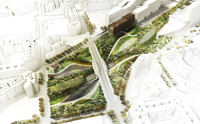 Team Camí Comtal - AldayJover, RCR e West 8 - has won La Sagrera Linear Park design competition in Barcelona. Team Camí Comtal - AldayJover, RCR e West 8 - has won La Sagrera Linear Park design competition in Barcelona.
The winning entry provides relief to the bustling city of Cerdá, introducing a new green slow route to counter today’s urban frenzy and activity.
The new green corridor, four kilometer long, extending from the city’s fringe deep into the heart of the centre is the successful result of the tunneling of the new Very fast Train route from France to Barcelona Sagrera/Sans. The urban precincts on either side of the route which used to be separated by railway yards are now linked by a series of parks.
This new public space is a means to connect the sequence of the sea, the city and its natural surroundings. It greatly adds biodiversity as it introduces a new slow and easy green cross, facing the famous Diagonal avenue, paradigm of the urban life.
» Read more |
 |
 |
  |
 Mecanoo to design Manchester arts and cultural centre Mecanoo to design Manchester arts and cultural centre |
 |
July 7, 2011
 Mecanoo has been awarded the commission to design a new, prestigious arts and cultural centre for Manchester. The project brings together two existing cultural establishments, the renowned Manchester Library Theatre Company, and the beloved Cornerhouse art house cinema. The centre will also accommodate large cultural festivals and international events including the Manchester International Festival. Along with two auditoria with 500 and 150 seats, five cinemas, a café and a foyer, the cultural centre includes an art gallery, studio and teaching spaces and a plaza for outdoor performances. The international competition was launched by Manchester City Council and Ask Developments. Mecanoo has been awarded the commission to design a new, prestigious arts and cultural centre for Manchester. The project brings together two existing cultural establishments, the renowned Manchester Library Theatre Company, and the beloved Cornerhouse art house cinema. The centre will also accommodate large cultural festivals and international events including the Manchester International Festival. Along with two auditoria with 500 and 150 seats, five cinemas, a café and a foyer, the cultural centre includes an art gallery, studio and teaching spaces and a plaza for outdoor performances. The international competition was launched by Manchester City Council and Ask Developments.
» Read more |
 |
 |
  |
 The Big Wave The Big Wave |
 |
June 24, 2011
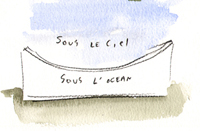 The opening of the Cité de l'Océan et du Surf, a museum dedicated to the knowledge of the oceans designed by Steven Holl in collaboration with Solange Fabião, will take place tomorrow in Biarritz. The opening of the Cité de l'Océan et du Surf, a museum dedicated to the knowledge of the oceans designed by Steven Holl in collaboration with Solange Fabião, will take place tomorrow in Biarritz.
It has been 50 years since surf boards rode the waves for the first time in Europe. Since then, Biarritz has become a major European centre for this sport, and now the most famous seaside resort on the French Atlantic coast has decided to celebrate the event with a series of initiatives. The most important of these is the realization and completion of this project. It is a fully interactive museum space, designed to create a greater respect for the oceans through a better understanding.
There will also be scientific ties with surfing such as the study of hydrodynamics. Visitors can also experience the thrill of entering into large tubes that simulate the water tunnel made legendary by the filming of John Milius in his film masterpiece, Big Wednesday.
» Read more |
 |
 |
  |
 (IM)PURE, (IN)FORMAL, (UN)BUILT - OMA exhibition opens today in Paris (IM)PURE, (IN)FORMAL, (UN)BUILT - OMA exhibition opens today in Paris |
 |
June 16, 2011
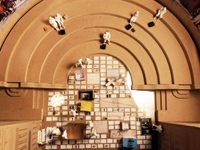 OMA's exhibition (IM)PURE, (IN)FORMAL, (UN)BUILT opens today at the École des Beaux-Arts in Paris. Made in collaboration with students at the Paris Malaquais School of Architecture, the exhibition focuses on three French libraries designed by OMA, two of them unrealized but crucially important in the development of the typology of libraries, and one about to go under construction… OMA's exhibition (IM)PURE, (IN)FORMAL, (UN)BUILT opens today at the École des Beaux-Arts in Paris. Made in collaboration with students at the Paris Malaquais School of Architecture, the exhibition focuses on three French libraries designed by OMA, two of them unrealized but crucially important in the development of the typology of libraries, and one about to go under construction…
The featured libraries, explored in a range of archival and new materials, are the Très Grande Bibliothèque in Paris (1989), with its "strategy of the void"; Jussieu (1992), with its continuous, ramped floors; and the Bibliothèque Multimédia à Vocation Régionale in Caen, scheduled for groundbreaking in 2012.
» Read more |
 |
 |
  |
 Serpentine Gallery Pavilion 2011 by Peter Zumthor Serpentine Gallery Pavilion 2011 by Peter Zumthor |
 |
April 25, 2011
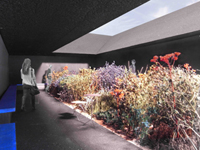 The Serpentine Gallery has reveal the plans for the Serpentine Gallery Pavilion 2011 by world-renowned Swiss architect Peter Zumthor. This year’s Pavilion is the 11th commission in the Gallery’s annual series, the world’s first and most ambitious architectural programme of its kind. It will be the architect’s first completed building in the UK and will include a specially created garden by the influential Dutch designer Piet Oudolf. The Serpentine Gallery has reveal the plans for the Serpentine Gallery Pavilion 2011 by world-renowned Swiss architect Peter Zumthor. This year’s Pavilion is the 11th commission in the Gallery’s annual series, the world’s first and most ambitious architectural programme of its kind. It will be the architect’s first completed building in the UK and will include a specially created garden by the influential Dutch designer Piet Oudolf.
At the heart of Peter Zumthor’s Pavilion is a garden that the architect hopes will inspire visitors to become observers. Zumthor’s says his design ‘aims to help its audience take the time to relax, to observe and then, perhaps, start to talk again - maybe not.’ The design emphasises the role the senses and emotions play in our experience of architecture. With a refined selection of materials Zumthor creates contemplative spaces that evoke the spiritual dimension of our physical environment. As always, Zumthor’s aesthetic goal is to customise the building precisely to its purpose as a physical body and an object of emotional experience.
» Read more |
 |
 |
  |
 National Museum of China by gmp National Museum of China by gmp |
 |
April 21, 2011
 The conversion and extension of the Chinese National Museum combines the former Chinese History Museum with the Chinese Revolutionary Museum. Completed in 1959 as one of ten important public buildings in Tian’anmen Square, in direct proximity to the Forbidden City, the museum still constitutes a milestone in history of modern Chinese architecture. The conversion and extension of the Chinese National Museum combines the former Chinese History Museum with the Chinese Revolutionary Museum. Completed in 1959 as one of ten important public buildings in Tian’anmen Square, in direct proximity to the Forbidden City, the museum still constitutes a milestone in history of modern Chinese architecture.
Outline schemes for the conversion and extension project were invited from ten international architectural firms, the proposal by architects von Gerkan, Marg and Partners (gmp) together with CABR of Beijing being adjudged preferred bidder, ahead of Foster and Partners, Kohn Pedersen Fox, OMA and Herzog & de Meuron etc.
The original submission by gmp envisaged gutting the existing museum. The central block would be removed, and the large space thereby created spanned by a bronze flying roof linking the old building and the extension. The flying roof was planned to house the main exhibition on Chinese history, with a direct view towards the sights of the city. Following a discussion with the client and Chinese architectural experts, this scheme was revised, with the aim of integrating more of the external impact of the old building in the new building, though without abolishing the immediately obvious distinction between old and new. This would allow the building itself to illustrate the continuity of history.
» Read more |
 |
 |
  |
 European Union Prize for Contemporary Architecture: Neues Museum, Berlin European Union Prize for Contemporary Architecture: Neues Museum, Berlin |
 |
April 17, 2011
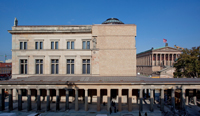 The Neues Museum in Berlin is the winner of the 2011 European Union Prize for Contemporary Architecture – Mies van der Rohe Award, the European Commission and the Mies van der Rohe Foundation announced. The building is a reconstruction, blending old and new, by UK architect Sir David Chipperfield. The 'Emerging Architect Special Mention' award goes to Ramon Bosch and Bet Capdeferro for the Collage House in Girona, Spain. The Neues Museum in Berlin is the winner of the 2011 European Union Prize for Contemporary Architecture – Mies van der Rohe Award, the European Commission and the Mies van der Rohe Foundation announced. The building is a reconstruction, blending old and new, by UK architect Sir David Chipperfield. The 'Emerging Architect Special Mention' award goes to Ramon Bosch and Bet Capdeferro for the Collage House in Girona, Spain.
The award ceremony will take place on 20 June at the Mies van der Rohe Pavilion in Barcelona.
The original Neues Museum, designed by Friedrich August Stüler, was built in the mid‐19th century. The building was severely damaged in the Second World War and reconstruction began in 2003, with the aim of restoring the site to its former glory. David Chipperfield, who worked on the project in collaboration with fellow British architect Julian Harrap, adopted a dynamic approach in his restoration. Rather than attempting to conceal the difference between the old and new elements, the past and present are beautifully combined to create an unforgettable building with multiple layers.
» Read more |
 |
 |
  |
 New Parliamentary Complex of Albania by Coop Himmelb(l)au New Parliamentary Complex of Albania by Coop Himmelb(l)au |
 |
April 11, 2011
Coop Himmelb(l)au’s winn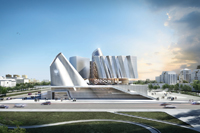 ing scheme for ‘The New Parliamentary Complex of the Republic of Albania’ officially confirmed. ing scheme for ‘The New Parliamentary Complex of the Republic of Albania’ officially confirmed.
Wolf D. Prix/Coop Himmelb(l)au presents the new ‘Open Parliament of Albania’ in Tirana which incorporates fundamental democratic values such as openness, transparency and public co-determination. The building, located on a site area with approximately 28,000 m2, is going to be the first project in Albania for the Viennese headquartered studio.
„Our design for the new Parliament in Tirana, Albania, stands for the transparency of democracy”, according to Wolf D. Prix, Design Principal and CEO of Coop Himmelb(l)au.
» Read more |
 |
 |
  |
 Study grants - Politecnico di Milano | Architectour.net Study grants - Politecnico di Milano | Architectour.net |
 |
April 8, 2011
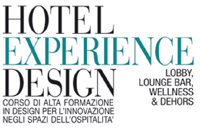 POLI.DESIGN - Consortium of Politecnico di Milano offers 6 study grants for the "Hotel Experience Design - Lobby, Lounge Bar, Wellness & Dehors - Designing Hotel Common Spaces" to all Architectour.net users. POLI.DESIGN - Consortium of Politecnico di Milano offers 6 study grants for the "Hotel Experience Design - Lobby, Lounge Bar, Wellness & Dehors - Designing Hotel Common Spaces" to all Architectour.net users.
Poli.Design, Consortium of Politecnico di Milano, has established the first course of high standard training in "Hotel Experience Design", the new specialisation for architects and designers interested in planning the new hotel common spaces, and spaces of Hotel Entertainment.
The 6th edition of the 216-hour course, with final project work and an educational tour of the most important hotels in Milan, takes place from 19 May to 1 July 2011 at POLI.design – Politecnico di Milano (Campus Bovisa).
The teaching staff includes academic specialists of the University Politecnico di Milano, who will be in charge of the planning, design and furniture section, and specialised professionals who will focus on entrepreneurial, technical and sociological topics, for a complete view over the New Entertainment.
Deadline for application for € 4,000 study grant: May 5, 2011.
The designers selected will pay only the registration fee of € 1,000 + VAT.
» Read more |
 |
 |
  |
 Museums such as supermarkets, department stores such as museums Museums such as supermarkets, department stores such as museums |
 |
April 3, 2011
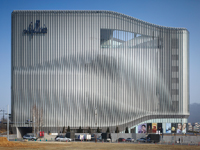 UNStudio's Galleria Centercity Department Store in the Korean city of Cheonan reclaims the social and cultural space within the private, commercial large scale department store.
Rather than being the outcome of a prescriptive, standard-critical approach, the design of the Galleria Centercity is based on observations of current behavioural tendencies in large commercial spaces. Particularly in South East Asia, department stores serve a highly social function; people meet, gather, eat, drink and both shop and window shop in these venues. UNStudio's Galleria Centercity Department Store in the Korean city of Cheonan reclaims the social and cultural space within the private, commercial large scale department store.
Rather than being the outcome of a prescriptive, standard-critical approach, the design of the Galleria Centercity is based on observations of current behavioural tendencies in large commercial spaces. Particularly in South East Asia, department stores serve a highly social function; people meet, gather, eat, drink and both shop and window shop in these venues.
The department store is no longer solely a commercial space, it now offers the architect the opportunity to build upon and expand the social and cultural experience of the visitor.
An expanded interpretation of utility beyond efficiency and profitability is at the heart of the design. In view of this, along with a more varied programme, UNStudio’s design seeks to provide a stimulating experience for the visitor.
» Read more |
 |
 |
  |
 2011 Pritzker Prize goes to Eduardo Souto de Moura 2011 Pritzker Prize goes to Eduardo Souto de Moura |
 |
March 31, 2011
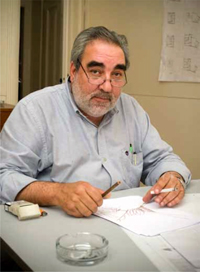 Eduardo Souto de Moura, a 58 year old architect from Portugal, is the jury’s choice for the 2011 Pritzker Architecture Prize, it was announced today by Thomas J. Pritzker, chairman of The Hyatt Foundation which sponsors the prize. The formal ceremony for what has come to be known throughout the world as architecture’s highest honor will be in one of Washington, D.C.’s finest classical buildings, the Andrew W. Mellon Auditorium. Eduardo Souto de Moura, a 58 year old architect from Portugal, is the jury’s choice for the 2011 Pritzker Architecture Prize, it was announced today by Thomas J. Pritzker, chairman of The Hyatt Foundation which sponsors the prize. The formal ceremony for what has come to be known throughout the world as architecture’s highest honor will be in one of Washington, D.C.’s finest classical buildings, the Andrew W. Mellon Auditorium.
In announcing the jury’s choice, Pritzker elaborated, “This marks the second time in the history of the prize that a Portuguese architect has been chosen. The first was in 1992 when Alvaro Siza was so honored.”
The purpose of the Pritzker Architecture Prize, which was founded in 1979 by the late Jay A. Pritzker and his wife, Cindy, is to honor annually a living architect whose built work demonstrates a combination of those qualities of talent, vision and commitment, which has produced consistent and significant contributions to humanity and the built environment through the art of architecture. The laureates receive a $100,000 grant and a bronze medallion.
» Read more |
 |
 |
  |
 The Cube, Dining with a View, opens on April 1st in Brussels The Cube, Dining with a View, opens on April 1st in Brussels |
 |
March 29, 2011
 The CUBE – dining with a view – is a pavilion designed by Park Associati to house an itinerant restaurant commissioned by Electrolux. Designed to be placed in unexpected and dramatic European locations, it will be launched in Brussels on April 1st, 2011 where it will sit atop of the Parc du Cinquantenaire, close to the headquarters of the European Community. The CUBE – dining with a view – is a pavilion designed by Park Associati to house an itinerant restaurant commissioned by Electrolux. Designed to be placed in unexpected and dramatic European locations, it will be launched in Brussels on April 1st, 2011 where it will sit atop of the Parc du Cinquantenaire, close to the headquarters of the European Community.
The restaurant will be active simultaneously in twin structures; the two Electrolux Cube’s will travel across Europe offering a memorable dining experience for 18 guests per setting in magnificent locations. The transparent and semi-transparent structures will be seen atop of buildings, monuments and even on water in Belgium, Italy, Russia, Switzerland and Sweden but only for three months at each location.
The interior of the The CUBE has been designed to suit different arrangements; the pavilion consists of a large open-planned space with a visible kitchen and a single large table that can be made to disappear by raising it up to the ceiling to form a lounge area for use after eating.
The total floor area of 140 sq.m. is divided between the open-planned space and a 50 sq.m. terrace.
» Read more |
 |
 |
  |
 PUU-BO System for E2 Ecology + Economy PUU-BO System for E2 Ecology + Economy |
 |
March 28, 2011
 BIG (DK) + Pirmin Jung Engineers for Wood Constructions (CH) + AOA Anttinen Oiva Architects Ltd (FI) + Vahanen Engineers (FI) + Stora Enso (FI) is the winning team to design a prototype wooden construction system for a pilot project in Kouvola, Finland, that will serve as a showcase for the sustainable use of timber construction worldwide. BIG (DK) + Pirmin Jung Engineers for Wood Constructions (CH) + AOA Anttinen Oiva Architects Ltd (FI) + Vahanen Engineers (FI) + Stora Enso (FI) is the winning team to design a prototype wooden construction system for a pilot project in Kouvola, Finland, that will serve as a showcase for the sustainable use of timber construction worldwide.
To meet the increasingly stringent environmental requirements of Finnish industrialized construction, the E2 Ecology & Economy timber development competition aims to find a conceptual design solution for large-scale production of wooden multi-story buildings. A 15.000 m2 prefabricated wooden development in Kouvola, Finland, will serve as a showcase for replicable and locally adaptable cost and energy efficient housing. BIG’s proposal PUU-BO is announced as one of two winning entries of the two-staged invited competition totaling 26 international proposals.
» Read more |
 |
 |
  |
 Opening Ceremony of Metropol Parasol in Seville, Spain Opening Ceremony of Metropol Parasol in Seville, Spain |
 |
March 25, 2011
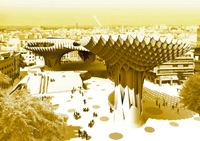 March 27th, 2011 marks the opening of Metropol Parasol, the Redevelopment of the Plaza de la Encarnacíon in Seville (Spain), while the final completion of the project is scheduled for April 2011. Designed by J. Mayer H. architects, this project becomes the new icon for Seville, a place of identification and to articulate Seville's role as one of the world´s most fascinating cultural destinations. March 27th, 2011 marks the opening of Metropol Parasol, the Redevelopment of the Plaza de la Encarnacíon in Seville (Spain), while the final completion of the project is scheduled for April 2011. Designed by J. Mayer H. architects, this project becomes the new icon for Seville, a place of identification and to articulate Seville's role as one of the world´s most fascinating cultural destinations.
Metropol Parasol explores the potential of the Plaza de la Encarnacion to become the new contemporary urban centre. Its role as a unique urban space within the dense fabric of the medieval inner city of Seville allows for a great variety of activities such as memory, leisure and commerce. A highly developed infrastructure helps to activate the square, making it an attractive destination for tourists and locals alike.
» Read more |
 |
 |
  |
 Study grants - Politecnico di Milano | Architectour.net Study grants - Politecnico di Milano | Architectour.net |
 |
March 24, 2010
 POLI.DESIGN - Consortium of Politecnico di Milano offers 6 study grants for the "New Entertainment Design - The first postgraduate course to become specialists in design and furniture for innovative night premises" to all Architectour.net users. POLI.DESIGN - Consortium of Politecnico di Milano offers 6 study grants for the "New Entertainment Design - The first postgraduate course to become specialists in design and furniture for innovative night premises" to all Architectour.net users.
Poli.Design, Consortium of Politecnico di Milano, has established the first and only course in Europe of high standard training in "New Entertainment Design", the new specialisation for architects and designers interested in planning new venues for the entertainment under the sign of design and the evolution of aesthetic languages.
The 12th edition of the 210-hour course, with final project work and an educational tour of the most important new entertainment, retail spaces and innovative hotels in Milan, takes place from 16 May to 1 July 2011 at POLI.design – Politecnico di Milano (Campus Bovisa).
The teaching staff includes academic specialists of the University Politecnico di Milano, who will be in charge of the planning, design and furniture section, and specialised professionals who will focus on entrepreneurial, technical and sociological topics, for a complete view over the New Entertainment.
Deadline for application for € 4,000 study grant: April 30, 2010.
The designers selected will pay only the registration fee of € 1,000 + VAT.
» Read more |
 |
 |
  |
 Earthquake and Tsunami in Japan Earthquake and Tsunami in Japan |
 |
|
 |
 |
  |
 The new City of Westminster College The new City of Westminster College |
 |
March 6, 2011
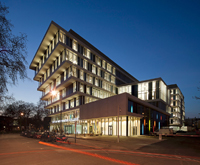 The new flagship Campus for City of Westminster College by schmidt hammer lassen architects is designed to support new ways of teaching and learning. The 24,000m2 College, won in a competition in 2006, provides much greater amounts of open learning spaces than typical colleges in the UK and holds state-of-the-art facilities for both students and staff. The building is designed to embrace interaction and diversity and allow students to learn from each other, both formally and informally. The new flagship Campus for City of Westminster College by schmidt hammer lassen architects is designed to support new ways of teaching and learning. The 24,000m2 College, won in a competition in 2006, provides much greater amounts of open learning spaces than typical colleges in the UK and holds state-of-the-art facilities for both students and staff. The building is designed to embrace interaction and diversity and allow students to learn from each other, both formally and informally.
The College is located in the heart of Central London at Paddington Green on the site of its previous building, an inefficient and failing 1960s block. The building has been designed from the inside-out, responding to the needs of the diverse groups who use the College, as well as taking into account the sensitive local context. It appears as a clean-cut, modern building with a distinct Scandinavian heritage. The building’s simple geometric forms rotate around a terraced atrium, creating a unifying yet flexible organisation.
» Read more |
 |
 |
  |
 BIG in Greenland BIG in Greenland |
 |
February 16, 2011
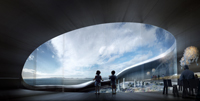 BIG + TNT Nuuk + Ramboll Nuuk + Arkitekti is the winning team to design the new National Gallery of Greenland in the country’s capital Nuuk, among invited proposals totaling 6 Nordic architects. BIG + TNT Nuuk + Ramboll Nuuk + Arkitekti is the winning team to design the new National Gallery of Greenland in the country’s capital Nuuk, among invited proposals totaling 6 Nordic architects.
Located on a steep slope overlooking the most beautiful of Greenland’s fjords, the 3000 m² National Gallery will serve as a cultural and architectural icon for the people of Greenland. The new museum will combine historical and contemporary art of the country in one dynamic institution. The winning proposal was selected by a unanimous museum board among 6 proposals, including Norwegian Snøhetta, Finnish Heikkinen‐Komonen, Islandic Studio Granda and Greenlandic Tegnestuen Nuuk.
As a projection of a geometrically perfect circle on to the steep slope, the new gallery is conceived as a courtyard building that combines a pure geometrical layout with a sensitive adaption to the landscape. The three‐dimensional imprint of the landscape creates a protective ring around the museum’s focal point, the sculpture garden where visitors, personnel, exhibition merge with culture and nature, inside and outside.
» Read more |
 |
 |
  |
 How much does your building weigh, Mr. Foster? How much does your building weigh, Mr. Foster? |
 |
February 15, 2010
 “How much does your building weigh, Mr. Foster?” premieres at the Institute of Contemporary Arts (ICA) Cinema in London. It is the first feature film about Norman Foster and the beginning of a series of Art Commissioners productions that focus on key figures in art and culture in the twenty-first century. “How much does your building weigh, Mr. Foster?” premieres at the Institute of Contemporary Arts (ICA) Cinema in London. It is the first feature film about Norman Foster and the beginning of a series of Art Commissioners productions that focus on key figures in art and culture in the twenty-first century.
Tracing Lord Foster’s career, from his childhood in Manchester to the global practice that he founded and chairs, the documentary looks at his architecture, why it matters and how difficult it is to do well. The film uses cinematography to capture the spectacular scale of projects such as the Millau Viaduct, Beijing Airport and Swiss Re, on the big screen for the first time.
The Art Commissioners production was directed by Norberto Lopez Amado and Carlos Carcas and written and narrated by Deyan Sudjic.
» Read more |
 |
 |
  |
 Study grants and new Competition Study grants and new Competition |
 |
February 11, 2011
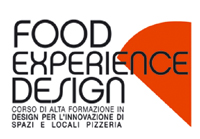 POLI.DESIGN - Consortium of Politecnico di Milano offers 6 study grants for the "Food Experience Design - Designing innovative pizzerias" to all Architectour.net users. POLI.DESIGN - Consortium of Politecnico di Milano offers 6 study grants for the "Food Experience Design - Designing innovative pizzerias" to all Architectour.net users.
For designers and architects a specialization that looks to the future.
The future of the restaurant industry has already started and pizzerias represent a highly potential changing marketplace for architects and designers mastering the creative, aesthetic and planning skills requested by the evolution in the retail, entertainment and hospitality industries.
The 3nd edition of the 120-hour course, with final project work and an educational tour of the most important spaces in Milan, takes place from 21 March to 8 April 2011 at POLI.design – Politecnico di Milano (Campus Bovisa).
The teaching staff includes personalities of Politecnico di Milano, who will be in charge of developing topics related to architectural planning, and a selection of experts who will focus on entrepreneurial, technological and sociological topics for a complete view over the sector.
Deadline for application for € 3,500 study grant: March 1, 2011.
The designers selected will pay only the registration fee of € 500 + VAT.
» Read more |
 |
 |
  |
 Study grants - Politecnico di Milano | Architectour.net Study grants - Politecnico di Milano | Architectour.net |
 |
January 9, 2011
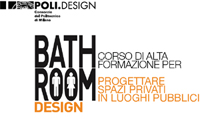 POLI.DESIGN - Consortium of Politecnico di Milano offers 6 study grants for the "Bathroom Design – Designing the bathroom environment for the new public venue" to all Architectour.net users. POLI.DESIGN - Consortium of Politecnico di Milano offers 6 study grants for the "Bathroom Design – Designing the bathroom environment for the new public venue" to all Architectour.net users.
The course, for engineers, architects and designers is aimed on the invention, design and furnishing of bathroom environment in public, hospitality and entertainment venues.
Poli.Design-Consortium of Politecnico di Milano has established the first and only course in Europe of high standard training in “Bathroom Design”, a postgraduate course for architects and designers interested in specialising in design for the bathroom environment in public, hospitality and entertainment venues, in touch with the evolution of the market and the aesthetic languages.
The teaching staff includes the most renowned Italian designers in the hospitality sector and high profile personalities of Politecnico di Milano who will be in charge of the planning, design, furniture and materials topics, and a selected number of experts who will focus on advanced entrepreneurial, technical and technological topics.
The 6th edition of the 120-hour course, with final project work and an educational tour of the most important spaces in Milan, takes place from 21 February to 11 March at POLI.design – Politecnico di Milano (Campus Bovisa).
Deadline for application for € 3,500 study grant: January 30, 2011.
The designers selected will pay only the registration fee of € 500 + VAT.
» Read more |
 |
 |
  |
 Science tower and urban park in the heart of Copenhagen Science tower and urban park in the heart of Copenhagen |
 |
December 19, 2010
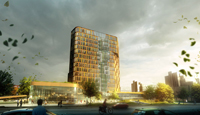 C. F. Møller Architects, together with SLA and Rambøll, have been selected by a unanimous jury as the winners of a large and prestigious competition to design an extension to the University of Copenhagen's Panum complex on Blegdamsvej in the heart of Copenhagen. C. F. Møller Architects, together with SLA and Rambøll, have been selected by a unanimous jury as the winners of a large and prestigious competition to design an extension to the University of Copenhagen's Panum complex on Blegdamsvej in the heart of Copenhagen.
The expansion will make a significant impact in the cityscape, with a science tower which will form an identity-creating, sculptural focal point for the entire Nørre Campus. The project also includes an urban park which will benefit both the Panum building and the surrounding city.
» Read more |
 |
 |
  |
 Official opening of the Masdar Institute campus, first solar powered building at Masdar City Official opening of the Masdar Institute campus, first solar powered building at Masdar City |
 |
December 4, 2010
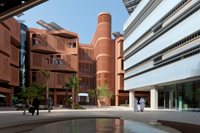 The Masdar Institute, devoted to researching sustainability, has been officially inaugurated. It is the first building to be fully operational within Masdar City. The masterplan, by Foster + Partners, incorporates lessons which have evolved over centuries of traditional Arabian architecture. The Masdar Institute is the first building of its kind to be powered entirely by renewable solar energy. It will be used as a pilot test bed for the sustainable technologies that will be explored for implementation in future Masdar City buildings. The post graduate students are Masdar City’s first resident community. The Masdar Institute, devoted to researching sustainability, has been officially inaugurated. It is the first building to be fully operational within Masdar City. The masterplan, by Foster + Partners, incorporates lessons which have evolved over centuries of traditional Arabian architecture. The Masdar Institute is the first building of its kind to be powered entirely by renewable solar energy. It will be used as a pilot test bed for the sustainable technologies that will be explored for implementation in future Masdar City buildings. The post graduate students are Masdar City’s first resident community.
A 10 megawatt solar field within the masterplan site provides 60% more energy than is consumed by the Masdar Institute, the remaining energy is fed back to the Abu Dhabi grid. The campus, which consists of a main building, a knowledge centre and students’ quarters, will use significantly less energy and water than average buildings in the UAE.
» Read more |
 |
 |
  |
 UNStudio design chosen for the Singapore University of Technology and Design UNStudio design chosen for the Singapore University of Technology and Design |
 |
December 3, 2010
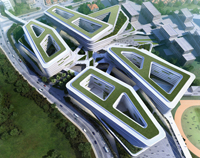 UNStudio, in collaboration with DP Architects, has been selected from a shortlist of five practices to design Plot A of the SUTD (Singapore University of Technology and Design) campus. UNStudio, in collaboration with DP Architects, has been selected from a shortlist of five practices to design Plot A of the SUTD (Singapore University of Technology and Design) campus.
Located on a site of 76,846 m2 and close to both Changi airport - Singapore’s principal airport - and the Changi Business Park, the SUTD will be Singapore’s fourth and most prestigious university.
UNStudio’s design for the new campus directly reflects SUTD’s curriculum, using the creative enterprise of the school to facilitate a cross-disciplinary interface; interaction is established between the professional world, the campus, and the community at large. The design for the campus offers an opportunity to embrace innovation and creativity through a non-linear connective relationship between students, faculty, professionals and the spaces they interact with.
» Read more |
 |
 |
  |
 Museum of Fine Arts, Boston, opens Art of the Americas Wing Museum of Fine Arts, Boston, opens Art of the Americas Wing |
 |
November 27, 2010
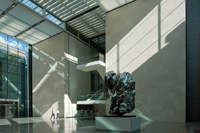 With at a dedication ceremony, the Museum of Fine Arts, Boston (MFA), unveiled a major redevelopment and new wing designed by Foster + Partners. The masterplan reinstates the original formal axis of the Museum and opens it up to the Back Bay Fens and the linear park designed by Frederick Law Olmsted in 1877. The MFA’s new wing creates 53 new galleries and houses the Art of the Americas collections, one of the premier assemblages of American art. With at a dedication ceremony, the Museum of Fine Arts, Boston (MFA), unveiled a major redevelopment and new wing designed by Foster + Partners. The masterplan reinstates the original formal axis of the Museum and opens it up to the Back Bay Fens and the linear park designed by Frederick Law Olmsted in 1877. The MFA’s new wing creates 53 new galleries and houses the Art of the Americas collections, one of the premier assemblages of American art.
Foster + Partners, working with CBT/Childs Bertman Tseckares of Boston, have carefully restored and augmented one of the world’s finest art museums to transform the experience for visitors, opening up the building to the community and consolidating the Museum’s five great collections into a more cohesive and understandable whole.
» Read more |
 |
 |
  |
 Study grants - Politecnico di Milano | Architectour.net Study grants - Politecnico di Milano | Architectour.net |
 |
November 19, 2010
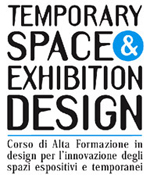 POLI.DESIGN - Consortium of Politecnico di Milano offers 6 study grants for the "Temporary Space & Exhibition Design - Designing temporary stores and innovative exhibition spaces" to all Architectour.net users. POLI.DESIGN - Consortium of Politecnico di Milano offers 6 study grants for the "Temporary Space & Exhibition Design - Designing temporary stores and innovative exhibition spaces" to all Architectour.net users.
The course, for engineers, architects and designers is aimed on the invention, design and furnishing of trade show booths and innovative temporary spaces, which are becoming increasingly relevant within retail and the trade show industry, where the designer plays a growing role.
The 3rd edition of the 160-hour course, with final project work and an educational tour of the most important spaces in Milan, takes place from 17 January to 11 February 2011 at POLI.design – Politecnico di Milano (Campus Bovisa).
Deadline for application for € 3,000 study grant: December 15, 2010.
The designers selected will pay only the registration fee of € 1,000 + VAT.
» Read more |
 |
 |
  |
 Yas Island | Abu Dhabi Grand Prix Yas Island | Abu Dhabi Grand Prix |
 |
|
 |
 |
  |
 Construction begins on Maggie’s Centre Gartnavel designed by OMA Construction begins on Maggie’s Centre Gartnavel designed by OMA |
 |
November 9, 2010
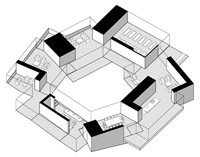 Ground will be broken today for Maggie’s Centre Gartnavel, a facility in Glasgow providing emotional and practical support for people living with cancer, their families and friends. Designed by OMA, the building, which is located on the grounds of Gartnavel Hospital and close to the Beatson West of Scotland Cancer Centre, is one of several Maggie’s Centres in the UK and part of a pioneering project using thoughtful architecture and innovative spaces as tools for solace and healing. Ground will be broken today for Maggie’s Centre Gartnavel, a facility in Glasgow providing emotional and practical support for people living with cancer, their families and friends. Designed by OMA, the building, which is located on the grounds of Gartnavel Hospital and close to the Beatson West of Scotland Cancer Centre, is one of several Maggie’s Centres in the UK and part of a pioneering project using thoughtful architecture and innovative spaces as tools for solace and healing.
OMA’s single-level, 534m2 building is a ring of interlocking, carefully composed spaces that provide moments of comfort and relief. With a flat roof and floor levels that respond to the natural topography, the rooms vary in height, with the more intimate areas programmed for personal uses such as counseling, and more open and spacious zones providing areas to gather and creating a sense of community.
» Read more |
 |
 |
  |
 Youturn Pavilion, 29th Art Biennale Sao Paulo Youturn Pavilion, 29th Art Biennale Sao Paulo |
 |
September 22, 2010
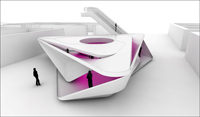 UNStudio’s Youturn Pavilion is one of six ‘terrieros’ created for the 29th Art Biennale in Sao Paulo, Brazil. Located at the heart of the biennale, the pavilion operates primarily as a venue; a nodal point within the biennale's context which provides a forum for communication by diverse means and on different scales. Programmatically the pavilion invites the public to meet, orientate and observe. It provokes interaction between both participants and visitors to the biennale, creating a place for display, discussion, and debate. The UNStudio Pavilion places itself between artwork, installation and architecture; operating as both a form and a functional structure performing as an activator of events. UNStudio’s Youturn Pavilion is one of six ‘terrieros’ created for the 29th Art Biennale in Sao Paulo, Brazil. Located at the heart of the biennale, the pavilion operates primarily as a venue; a nodal point within the biennale's context which provides a forum for communication by diverse means and on different scales. Programmatically the pavilion invites the public to meet, orientate and observe. It provokes interaction between both participants and visitors to the biennale, creating a place for display, discussion, and debate. The UNStudio Pavilion places itself between artwork, installation and architecture; operating as both a form and a functional structure performing as an activator of events.
Ben van Berkel: “It is a wonderful quality in architecture today; that it can perform on so many levels and that there is cultural acceptance again for this richness of meanings and readings. Architecture can have its cultural expression in a similar way to how art is perceived or interpreted. The metaphorical interpretation of spaces can be similar to the reading of piece of art, so the mechanics and the approach can be similar, but the outcomes are of course different.”
» Read more |
 |
 |
  |
 Museum of the Second World War in Gdansk, Poland Museum of the Second World War in Gdansk, Poland |
 |
September 2, 2010
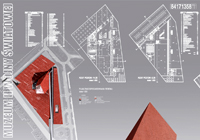 The winner of the architectural competition for the building of the Museum of the Second World War in Gdańsk, Poland, is the Studio "Kwadrat", Gdynia, Poland. The winner of the architectural competition for the building of the Museum of the Second World War in Gdańsk, Poland, is the Studio "Kwadrat", Gdynia, Poland.
The purpose of the competition is to select the architectural concept of the building to house the Museum of the Second World War, together with the concept of landscape development. 240 firms from 33 countries of the world participated in the contest.
The verdict of the Jury, in which Daniel Libeskind was one of the members, says: "In its Design, the innovative, huge-scale project makes use of the unique air of the city and transforms it in a modern manner. The colour and texture proposed in the design smoothly blend with the colours of Gdańsk giving the museum the power to pass the test of the 21st century."
The construction works on the Museum will commence in 2012. A ceremonious opening of the new building is planned for 1 September 2014 – on the 75th anniversary of the outbreak of World War II.
» Read more |
 |
 |
  |
 Banco Ciudad de Buenos Aires by Foster + Partners Banco Ciudad de Buenos Aires by Foster + Partners |
 |
September 1, 2010
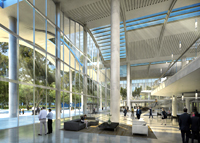 Foster + Partners, working with construction firm, CRIBA S.A. and local architect, BBRCH-Minond, has won the competition to design a new corporate headquarters for the Banco Ciudad de Buenos Aires, Argentina. Plans for the energy-efficient building, which will occupy an entire city block in the neighbourhood of Parque Patricios, echo its park-side setting with landscaped courtyards and shaded walkways and will provide a distinctive new presence for the bank in the city. Foster + Partners, working with construction firm, CRIBA S.A. and local architect, BBRCH-Minond, has won the competition to design a new corporate headquarters for the Banco Ciudad de Buenos Aires, Argentina. Plans for the energy-efficient building, which will occupy an entire city block in the neighbourhood of Parque Patricios, echo its park-side setting with landscaped courtyards and shaded walkways and will provide a distinctive new presence for the bank in the city.
The scheme occupies the whole site to create an internal campus of ‘villages’, which are connected by circulation routes and external landscaped patios and are unified by a flowing roof canopy. The entrance plaza is sheltered by the deep overhang of the roof, which is supported by slender pillars. A full-height atrium directs circulation into four tiers of terraced office spaces, all of which have direct views of the park. Based on an eight-metre-square planning grid, the generous light-filled floor plates allow the work spaces to be flexibly planned.
» Read more |
 |
 |
  |
 C.F. Møller: new Ferry Terminal in Stockholm C.F. Møller: new Ferry Terminal in Stockholm |
 |
August 31, 2010
 C.F. Møller Architects has just won the competition for a new Stockholms Hamnar ferry terminal. C.F. Møller Architects has just won the competition for a new Stockholms Hamnar ferry terminal.
The new terminal for Stockholm’s permanent ferry connections to Finland and the Baltics will be a landmark for the new urban development Norra Djursgårdsstaden - both architecturally and environmentally. The terminal, which will have a facade covered with expanded mesh, recalls the shape of a moving vessel and the architecture - with large cranes and warehouses - that previously characterized the ports. At the same time, the terminal has an ambitious sustainable profile, characteristic of the entire development.
» Read more |
 |
 |
  |
 BIG'S 8 House wins the 2010 Scandinavian Green Roof Award BIG'S 8 House wins the 2010 Scandinavian Green Roof Award |
 |
August 30, 2010
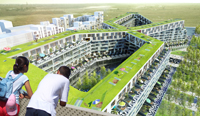 Completing its trilogy of housing projects in Oerestad with the same client, BIG + green roof contractor Veg Tech receives the award for 8 House’s 1.700 m2 sloping green roof. Completing its trilogy of housing projects in Oerestad with the same client, BIG + green roof contractor Veg Tech receives the award for 8 House’s 1.700 m2 sloping green roof.
The Scandinavian Green Roof Association based in Malmo, Sweden, today honored the Best Green Roof in the Scandinavia, at an award ceremony at the 8 House in Oerestad, Copenhagen. Since 2000, the association has promoted an increased use of green roofs in Scandinavia and created numerous working examples at its Malmo address. In addition the association and its members educate the positive impact of green roofs on urban ecology, and provide inspiration for legislation and building standards.
» Read more |
 |
 |
  |
 The Ship: a Floating Pavilion for Croatia at the Venice Biennale The Ship: a Floating Pavilion for Croatia at the Venice Biennale |
 |
August 26, 2010
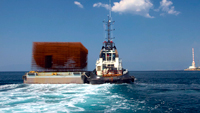 The Floating Pavilion to present arts and architecture of Croatia at the Venice Biennale is constructed on an existing barge with dimensions of 10m x 20m x 3m. It is designed by a group of 14 leading Croatian architects, who have made the recent Croatian architecture visible on the global scene. Instead of working in the usual formats of their practices and presenting speculative projects, they decided to work together on a single proposal and to have it constructed and towed toward its final destination in Venice right away. The Floating Pavilion to present arts and architecture of Croatia at the Venice Biennale is constructed on an existing barge with dimensions of 10m x 20m x 3m. It is designed by a group of 14 leading Croatian architects, who have made the recent Croatian architecture visible on the global scene. Instead of working in the usual formats of their practices and presenting speculative projects, they decided to work together on a single proposal and to have it constructed and towed toward its final destination in Venice right away.
The pavilion structure is the barge’s cargo, welded from 30 tons of Q385 wire mesh in more than 40 layers of varying contours. The cargo presented here maps the process of intense interaction between architects working on the common project, their collaboration with the Croatian maritime industry, and the extraordinary act of architecture it produced. Please follow the pavilion’s maiden voyage across the Adriatic on www.pavilion.hr.
» Read more |
 |
 |
  |
 OMA exhibits in Venice as Rem Koolhaas wins Golden Lion OMA exhibits in Venice as Rem Koolhaas wins Golden Lion |
 |
August 19, 2010
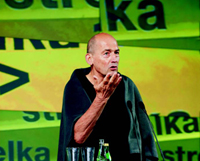 OMA’s major installation ‘Preservation’ opens next week in Venice at the 12th International Architecture Exhibition, alongside exhibits on current work around the world and a new, large-scale preservation project in Venice itself. OMA’s major installation ‘Preservation’ opens next week in Venice at the 12th International Architecture Exhibition, alongside exhibits on current work around the world and a new, large-scale preservation project in Venice itself.
OMA’s installation will assert the critical position of preservation in architecture and urbanism and occupies two large rooms in the Palazzo delle Esposizioni. The installation includes historic objects and photographs, analysis of the rapid growth of preserved urban and natural territory, and a take-away display of OMA’s own projects spanning 35 years. ‘Preservation’ will redefine this under-explored theme as one of urgency within and beyond architecture’s disciplinary boundaries.
A new OMA project in Venice, the Fondaco dei Tedeschi, embodying many of these ideas, will be announced during the Biennale. A former trading post and customs house owned by the Benetton family and dating from 1228, the Fondaco, centrally located and adjacent to the Rialto Bridge, will be converted into a culturally-programmed department store which preserves the building’s historic profile.
» Read more |
 |
 |
  |
 C.F. Moller win the competition for the new Kristiansund Opera C.F. Moller win the competition for the new Kristiansund Opera |
 |
July 13, 2010
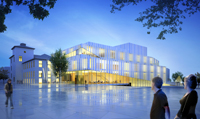 C.F. Møller Architects just won a shared first prize in the competition for the new Kristiansund Opera and Culture Centre. The other first prize in the competition goes to the Norwegian firm Space Group in collaboration with the London firm Brisac Gonzales for their project "Silencio". C.F. Møller Architects just won a shared first prize in the competition for the new Kristiansund Opera and Culture Centre. The other first prize in the competition goes to the Norwegian firm Space Group in collaboration with the London firm Brisac Gonzales for their project "Silencio".
Kristiansund Opera and Cultural Centre will house Norway's oldest opera, dating back to 1805, which every year arranges the Opera Festival Weeks - Norway's largest and most comprehensive presentation of opera and musical theatre and one of Scandinavia’s largest opera festivals.
The vision of the new Opera House is to create a cultural power centre in Kristiansund, the capital of the region of Nordmøre, west of Trondheim – a landmark to the entire region.
» Read more |
 |
 |
  |
 2010 FIFA World Cup South Africa Special Edition: The Stadiums 2010 FIFA World Cup South Africa Special Edition: The Stadiums |
 |
|
 |
 |
  |
 Khan Shatyr Entertainment Center, Kazakhstan. The tallest tensile structure of the world Khan Shatyr Entertainment Center, Kazakhstan. The tallest tensile structure of the world |
 |
July 9, 2010
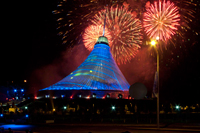 The Khan Shatyr Entertainment Center was officially opened last night in the presence of President Nazarbayev and heads of state in a grand ceremony, with a performance by the Italian tenor Andrea Bocelli, timed to coincide with the President’s birthday and Astana Day. The Center represents a major new civic, cultural and social venue for the people of Astana, bringing together a wide range of activities within a sheltered climatic envelope that provides a comfortable environment all year round. The Khan Shatyr Entertainment Center was officially opened last night in the presence of President Nazarbayev and heads of state in a grand ceremony, with a performance by the Italian tenor Andrea Bocelli, timed to coincide with the President’s birthday and Astana Day. The Center represents a major new civic, cultural and social venue for the people of Astana, bringing together a wide range of activities within a sheltered climatic envelope that provides a comfortable environment all year round.
The tent-like, cable-net structure is located at the northern end of the new city axis and soars 150 metres from an elliptical base to form the highest peak on the Astana skyline. The building encloses an area in excess of 100,000 square metres within an ETFE dome, with dramatic views over the city and the Steppes beyond. Contained within it is an urban-scaled park, along with a wide variety of entertainment and leisure facilities, including retail, cafes, restaurants, cinemas, and flexible spaces that can accommodate a varied programme of events and exhibitions. The different levels form undulating terraces, the uppermost terrace forming a water park.
» Read more |
 |
 |
  |
 2010 FIFA World Cup South Africa Special Edition: The Stadiums 2010 FIFA World Cup South Africa Special Edition: The Stadiums |
 |
|
 |
 |
  |
 2010 FIFA World Cup South Africa Special Edition: The Stadiums 2010 FIFA World Cup South Africa Special Edition: The Stadiums |
 |
|
 |
 |
  |
 Shenzhen Stock Exchange by OMA Tops Out Shenzhen Stock Exchange by OMA Tops Out |
 |
June 30, 2010
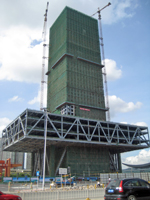 The Shenzhen Stock Exchange (SSE) – designed by OMA as the new home for China’s equivalent of the NASDAQ exchange for hi-tech industries – topped out at 246 metres. The building is remarkable not only for its height: with a raised podium suspended 36 metres over a public plaza and projecting 54 metres from the tower base, the Shenzhen Stock Exchange has one of the largest cantilevers in the world. The Shenzhen Stock Exchange (SSE) – designed by OMA as the new home for China’s equivalent of the NASDAQ exchange for hi-tech industries – topped out at 246 metres. The building is remarkable not only for its height: with a raised podium suspended 36 metres over a public plaza and projecting 54 metres from the tower base, the Shenzhen Stock Exchange has one of the largest cantilevers in the world.
SSE officials, Shenzhen Mayor Xu Qin and Shenzhen Vice-mayors Lu Ruifeng and Chen Yingchun, joined Pritzker Prize-winning architect Rem Koolhaas of OMA at a ceremony on 26th June at the construction site. Koolhaas commented: "We are extremely happy and honoured to have the opportunity to create here a building that can be both subtle and staggering at the same time."
Façade construction has already begun on the tower’s 46 floors, and the building is scheduled for completion in August 2011.
» Read more |
 |
 |
  |
 2010 FIFA World Cup South Africa Special Edition: The Stadiums 2010 FIFA World Cup South Africa Special Edition: The Stadiums |
 |
|
 |
 |
  |
 2010 FIFA World Cup South Africa Special Edition: The Stadiums 2010 FIFA World Cup South Africa Special Edition: The Stadiums |
 |
|
 |
 |
  |
 2010 FIFA World Cup South Africa Special Edition: The Stadiums 2010 FIFA World Cup South Africa Special Edition: The Stadiums |
 |
|
 |
 |
  |
 Foundation Gabarrón Cristobal Award to Álvaro Siza Foundation Gabarrón Cristobal Award to Álvaro Siza |
 |
June 17, 2010
 The Portuguese architect Álvaro Siza Vieira was awarded the International Prize for Plastic Arts Foundation Gabarrón Cristobal 2010, who wanted to distinguish "the teachings, the international relevance and poetic inspiration" of his work. The Portuguese architect Álvaro Siza Vieira was awarded the International Prize for Plastic Arts Foundation Gabarrón Cristobal 2010, who wanted to distinguish "the teachings, the international relevance and poetic inspiration" of his work.
The jury’s award highlights the fact that Siza makes architecture “transparent and respectful of the environment where it fits, "praising its ability to develop a “poetic feeling to every building, by working with space and light."
Proof of this highlights, is the building of the University of the Basque Country, which will be completed this year, the Meteorological Center of the Olympic Village in Barcelona (1992), the Galician Center for Contemporary Art in Santiago de Compostela (1993), the Rectorate of the University of Alicante (1997) and the Foundation Serralves (1999).
The award, which reaches it´s ninth edition this year, had 31 candidates competing in various countries.
» Read more |
 |
 |
  |
 Yes is More. An Archicomic on Architectural Evolution Yes is More. An Archicomic on Architectural Evolution |
 |
June 16, 2010
 As part of Arc en Rêve’s long-term ambition, this event aims to call attention to a young European agency that considers architectural projects in an incisive, innovative way that does not exclude a sense of humour. As part of Arc en Rêve’s long-term ambition, this event aims to call attention to a young European agency that considers architectural projects in an incisive, innovative way that does not exclude a sense of humour.
With projects such as the Copenhagen Harbour Baths (2003), the Ørestad residences (2008) built on a gigantic sloping slab resembling an urban mountain, and a bike track spiralling through the Danish pavilion at Expo Shanghai (2010), BIG’s completed projects offer profound architectural experiences at a far remove from minimalism, political correctness and digital formalism.
Set up in Arc en Rêve’s main gallery, the exhibition takes the form of a huge, 130-metre-long comic strip occupying the entire 450 square metres of the space and complete with 30 models – one of them an astonishing LEGO construction – and 19 animated films. As a manifesto project accompanied by a book, Yes is More is an invitation to update our vision of architecture and the city in a return to modernity and its utopias.
» Read more |
 |
 |
  |
 Study grants - Politecnico di Milano | Architectour.net Study grants - Politecnico di Milano | Architectour.net |
 |
June 15, 2010
 POLI.DESIGN - Consortium of Politecnico di Milano offers 6 study grants for the "New Entertainment Design - The first postgraduate course to become specialists in design and furniture for innovative night premises" to all Architectour.net users. POLI.DESIGN - Consortium of Politecnico di Milano offers 6 study grants for the "New Entertainment Design - The first postgraduate course to become specialists in design and furniture for innovative night premises" to all Architectour.net users.
Poli.Design, Consortium of Politecnico di Milano, has established the first and only course in Europe of high standard training in "New Entertainment Design", the new specialisation for architects and designers interested in planning new venues for the entertainment under the sign of design and the evolution of aesthetic languages.
The 12th edition of the 210-hour course, with final project work and an educational tour of the most important new entertainment, retail spaces and innovative hotels in Milan, takes place from 27 September to 12 November 2010 at POLI.design – Politecnico di Milano (Campus Bovisa).
The teaching staff includes academic specialists of the University Politecnico di Milano, who will be in charge of the planning, design and furniture section, and specialised professionals who will focus on entrepreneurial, technical and sociological topics, for a complete view over the New Entertainment.
Deadline for application for € 4,000 study grant: September 1, 2010.
The designers selected will pay only the registration fee of € 1,000 + VAT.
» Read more |
 |
 |
  |
 Study grants - Politecnico di Milano | Architectour.net Study grants - Politecnico di Milano | Architectour.net |
 |
June 15, 2010
 POLI.DESIGN - Consortium of Politecnico di Milano offers 5 study grants for the "Food Experience Design - The specialization to create and design innovative pizzerias" to all Architectour.net users. POLI.DESIGN - Consortium of Politecnico di Milano offers 5 study grants for the "Food Experience Design - The specialization to create and design innovative pizzerias" to all Architectour.net users.
For designers and architects a specialization that looks to the future.
The future of the restaurant industry has already started and pizzerias represent a highly potential changing marketplace for architects and designers mastering the creative, aesthetic and planning skills requested by the evolution in the retail, entertainment and hospitality industries.
The 5th edition of the 176-hour course, with final project work and an educational tour of the most important spaces in Milan, takes place from 29 September to 29 October 2010 at POLI.design – Politecnico di Milano (Campus Bovisa).
The teaching staff includes personalities of Politecnico di Milano, who will be in charge of developing topics related to architectural planning, and a selection of experts who will focus on entrepreneurial, technological and sociological topics for a complete view over the sector.
Deadline for application for € 4,000 study grant: September 1, 2010.
The designers selected will pay only the registration fee of € 500 + VAT.
» Read more |
 |
 |
  |
 2010 FIFA World Cup South Africa Special Edition: The Stadiums 2010 FIFA World Cup South Africa Special Edition: The Stadiums |
 |
|
 |
 |
  |
 South Africa, FIFA World Cup 2010 South Africa, FIFA World Cup 2010 |
 |
June 9, 2010
 This Friday, with the opening match in the futuristic-looking Soccer City, the 2010 FIFA World Cup South Africa will begin and for the first time in History it will take place in the African Continent. This Friday, with the opening match in the futuristic-looking Soccer City, the 2010 FIFA World Cup South Africa will begin and for the first time in History it will take place in the African Continent.
For this event, the South African Government has invested 43 billion Rand (about 4.6 billion euros), 23% of which has been devoted to the development of the stadiums and surrounding areas, 32% for transportation and traffic systems and 45% for the airports.
Architectour.net has created with particular interest a special edition on this important event, because in addition to the event itself, the magnificient sport facilities offer us just a glimpse of what has been done in an area of which we would like to have more news.
This is the perfect opportunity for you to enjoy sport events in architectural settings of great interest, which we will continue to document for our readers.
» Read more |
 |
 |
  |
 Groundbreaking of the new premises of the European Central Bank in Frankfurt, Germany Groundbreaking of the new premises of the European Central Bank in Frankfurt, Germany |
 |
May 20, 2010
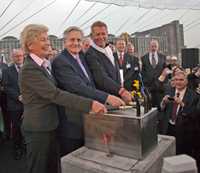 The groundbreaking of Coop Himmelb(l)au’s new premises of the European Central Bank has been celebrated yesterday in attendance of Jean-Claude Trichet, President of the European Central Bank, Petra Roth, Mayor of the City of Frankfurt, Wolf D. Prix, Design Principal and CEO of Coop Himmelb(l)au, the Governing Council as well as the Governors of the National Central Banks on the site of the future new premises of the European Central Bank. The groundbreaking of Coop Himmelb(l)au’s new premises of the European Central Bank has been celebrated yesterday in attendance of Jean-Claude Trichet, President of the European Central Bank, Petra Roth, Mayor of the City of Frankfurt, Wolf D. Prix, Design Principal and CEO of Coop Himmelb(l)au, the Governing Council as well as the Governors of the National Central Banks on the site of the future new premises of the European Central Bank.
During the ceremony Wolf D. Prix said in his speech for the groundbreaking: “The task of architecture is not only to provide a shell for functions, but through its architectural aesthetic it must also enable to establish three-dimensional cross-references in the culture of our globalized society without denying its location. The dialectic of old and new – the carefully renovated Großmarkthalle and the new ensemble of towers – will mirror this synchronicity.”
» Read more |
 |
 |
  |
 Strelka, a new school in Moscow, launches with AMO collaboration Strelka, a new school in Moscow, launches with AMO collaboration |
 |
May 18, 2010
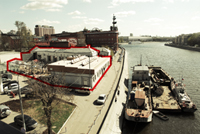 Strelka, a new postgraduate school for media, architecture and design, launches its ambitious educational program for 2010-11, developed in collaboration with AMO, in a special event at the Red October Chocolate Factory in Moscow on 25 May. Strelka, a new postgraduate school for media, architecture and design, launches its ambitious educational program for 2010-11, developed in collaboration with AMO, in a special event at the Red October Chocolate Factory in Moscow on 25 May.
The Strelka Institute for Media, Architecture and Design, a non-profit, independent school, intends to raise the ambition of the creative industries in Moscow. A select group of students will work intensely and innovatively on a series of themes currently shaping Russia and its role in the world. Their work – culminating in a variety of projects to be presented at the end of the first academic year – will be guided and interrogated by instructors who are leaders in their cultural fields both within Russia and internationally.
AMO, the think tank within OMA (Office for Metropolitan Architecture), will provide the framework for these investigations, drawing on its global network of collaborators and its serious interest in Russia – evidenced in nearly a decade of collaboration with the Hermitage in St. Petersburg. Partners in charge at AMO are Rem Koolhaas and Reinier de Graaf.
» Read more |
 |
 |
  |
 Unveiled Libeskind's design for the Jewish Museum Berlin Academy Unveiled Libeskind's design for the Jewish Museum Berlin Academy |
 |
May 13, 2010
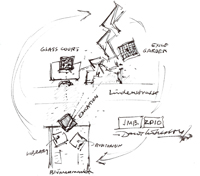 The Jewish Museum Berlin had reveal the design by Daniel Libeskind for the Jewish Museum Berlin Academy. Mr. Libeskind designed both the Jewish Museum Berlin (completed 2001) and the Glass Courtyard (completed 2007) which is an extension to the original building. The Jewish Museum Berlin had reveal the design by Daniel Libeskind for the Jewish Museum Berlin Academy. Mr. Libeskind designed both the Jewish Museum Berlin (completed 2001) and the Glass Courtyard (completed 2007) which is an extension to the original building.
"We are delighted that we could again win Daniel Libeskind as architect, whose signature is closely bound with the success of the Jewish Museum Berlin. Together with the existing two Libeskind buildings – the zinc-coated museum building and the glass courtyard on the old building – a fascinating new building ensemble will emerge" commented W. Michael Blumenthal, Director of the Jewish Museum Berlin.
The Jewish Museum Berlin plans to construct an academy on the site of the former Berlin Flower Market (Blumengrossmarkt) by using the existing hall. Located across from the Jewish Museum Berlin, the new JMB Academy will unite library, archives, educational and public programs under one roof and will offer additional office, storage and support spaces for the Museum. Mr. Libeskind has designed a new entrance while maintaining the hall structure thereby establishing a cultural use for the space with the option of future expansion.
» Read more |
 |
 |
  |
 Counterpoint becomes Malmö’s new cultural centre Counterpoint becomes Malmö’s new cultural centre |
 |
May 9, 2010
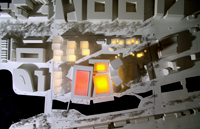 Schmidt Hammer Lassen architects has won the competition to design a 54,000 sq.m. concert, congress and hotel complex in Malmö, Sweden. The competition, where Snøhetta, Baumschlager Eberle and Daniel Libeskind participated, also included the development of additionally 35,000 sq.m. for housing and commercial use. This is the second competition won by Schmidt Hammer Lassen architects in the southern part of Sweden in 2010. Schmidt Hammer Lassen architects has won the competition to design a 54,000 sq.m. concert, congress and hotel complex in Malmö, Sweden. The competition, where Snøhetta, Baumschlager Eberle and Daniel Libeskind participated, also included the development of additionally 35,000 sq.m. for housing and commercial use. This is the second competition won by Schmidt Hammer Lassen architects in the southern part of Sweden in 2010.
The new building complex is situated on Universitetsholmen in Malmö. The building consists of a composition of cubic volumes that are mutually twisted and given different sizes to meet the directions and building heights of the surrounding city. The facades are designed with a homogeneous expression to make the composition appear as one architectonic sculpture.
"The idea is to create a 'house of the city' that incorporates the architectonic expressions of Malmö – a building that will contribute to the existing urban life," said partner at Schmidt Hammer Lassen architects Kim Holst Jensen, and he added, "The context has inspired our choice of materials, colours and the various sizes of the building volumes, yet the building design in itself points to the future."
» Read more |
 |
 |
  |
 Jean Nouvel commissioned to design 10th Serpentine Gallery Pavilion Jean Nouvel commissioned to design 10th Serpentine Gallery Pavilion |
 |
May 1, 2010
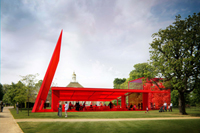 In its 40th anniversary year, the Serpentine Gallery is delighted to announce that the 10th Serpentine Gallery Pavilion is being designed by world-renowned French architect Jean Nouvel. This year’s Pavilion is the 10th commission in the Gallery’s annual series, the world’s first and most ambitious architectural programme of its kind. It will be the architect’s first completed building in the UK. In its 40th anniversary year, the Serpentine Gallery is delighted to announce that the 10th Serpentine Gallery Pavilion is being designed by world-renowned French architect Jean Nouvel. This year’s Pavilion is the 10th commission in the Gallery’s annual series, the world’s first and most ambitious architectural programme of its kind. It will be the architect’s first completed building in the UK.
The Pavilion commission has become an international site for architectural experimentation and follows a long tradition of Pavilions by some of the world’s greatest architects. The immediacy of the commission – a maximum of six months from invitation to completion – provides a unique model worldwide.
The design for the 2010 Pavilion is a contrast of lightweight materials and dramatic metal cantilevered structures. The entire design is rendered in a vivid red that, in a play of opposites, contrasts with the green of its park setting. In London the colour reflects the iconic British images of traditional telephone boxes, post boxes and London buses.
» Read more |
 |
 |
  |
 Daniel Libeskind in Singapore Daniel Libeskind in Singapore |
 |
April 6, 2010
 Reflections at Keppel Bay, which has topped-out its first tower, will redefine Singapore’s southern coast. Tower 1A is the first of six glass towers to be completed in the waterfront residential development. Reflections at Keppel Bay, which has topped-out its first tower, will redefine Singapore’s southern coast. Tower 1A is the first of six glass towers to be completed in the waterfront residential development.
Reflections at Keppel Bay is comprised of six glass towers and 11 villa apartment blocks featuring 1,129 luxury waterfront apartments along a 750 meter shoreline, all with views of the bay, golf course, lush parks and Mount Faber.
The waterfront development is also ecologically responsible, achieving the Green Mark Gold Award by the Building and Construction Authority in 2008. Crowning the towers are lush sky gardens on sloping rooflines, and are linked by sky bridges, providing pockets of open spaces and platforms with 360-degree views of the spectacular surrounds including Resorts World Sentosa and Universal Studios Singapore.
Reflections at Keppel Bay is architect Daniel Libeskind’s first residential showcase in Asia. His other works includes some of the world’s most celebrated architectural icons like the Jewish Museum Berlin, Denver Art Museum. His most recently completed projects include Crystals in Las Vegas - the luxury shopping center in MGM Mirage’s CityCenter which opened in December, 2009 and the 2100 seat Grand Canal Theatre in Dublin which opened on March 18th.
» Read more |
 |
 |
  |
 2010 Pritzker Prize goes to SANAA | Kazuyo Sejima, Ryue Nishizawa 2010 Pritzker Prize goes to SANAA | Kazuyo Sejima, Ryue Nishizawa |
 |
March 29, 2010
 Kazuyo Sejima and Ryue Nishizawa, partners in the architectural firm, SANAA, have been chosen as the 2010 Laureates of the Pritzker Architecture Prize. The formal ceremony for what has come to be known throughout the world as architecture’s highest honor will be held on May 17 on historic Ellis Island in New York. At that time, a $100,000 grant and bronze medallions will be bestowed on the two architects. Kazuyo Sejima and Ryue Nishizawa, partners in the architectural firm, SANAA, have been chosen as the 2010 Laureates of the Pritzker Architecture Prize. The formal ceremony for what has come to be known throughout the world as architecture’s highest honor will be held on May 17 on historic Ellis Island in New York. At that time, a $100,000 grant and bronze medallions will be bestowed on the two architects.
In announcing the jury’s choice, Thomas J. Pritzker, chairman of The Hyatt Foundation, elaborated, “This marks the third time in the history of the prize that two architects have been named in the same year. The first was in 1988 when Oscar Niemeyer of Brazil and the late Gordon Bunshaft were so honored, and the second was in 2001, when Jacques Herzog and Pierre de Meuron, partners in a Swiss firm, were selected.”
He continued, “Japanese architects have been chosen three times in the thirty year history of the Pritzker Architecture Prize — the first was the late Kenzo Tange in 1987, then in 1993, Fumihiko Maki was selected, and in 1995, Tadao Ando was the honoree.”
» Read more |
 |
 |
  |
 Study grants - Politecnico di Milano | Architectour.net Study grants - Politecnico di Milano | Architectour.net |
 |
March 27, 2010
 POLI.DESIGN - Consortium of Politecnico di Milano offers 5 study grants for the "New Entertainment Design - The first postgraduate course to become specialists in design and furniture for innovative night premises" to all Architectour.net users. POLI.DESIGN - Consortium of Politecnico di Milano offers 5 study grants for the "New Entertainment Design - The first postgraduate course to become specialists in design and furniture for innovative night premises" to all Architectour.net users.
Poli.Design, Consortium of Politecnico di Milano, has established the first and only course in Europe of high standard training in "New Entertainment Design", the new specialisation for architects and designers interested in planning new venues for the entertainment under the sign of design and the evolution of aesthetic languages.
The 11th edition of the 210-hour course, with final project work and an educational tour of the most important new entertainment, retail spaces and innovative hotels in Milan, takes place from 17 May to 1 July 2010 at POLI.design – Politecnico di Milano (Campus Bovisa).
The teaching staff includes academic specialists of the University Politecnico di Milano, who will be in charge of the planning, design and furniture section, and specialised professionals who will focus on entrepreneurial, technical and sociological topics, for a complete view over the New Entertainment.
Deadline for application for € 4,000 study grant: May 3, 2010.
The designers selected will pay only the registration fee of € 1,000 + VAT.
» Read more |
 |
 |
  |
 Study grants - Politecnico di Milano | Architectour.net Study grants - Politecnico di Milano | Architectour.net |
 |
March 27, 2010
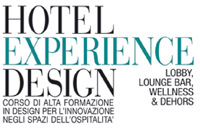 POLI.DESIGN - Consortium of Politecnico di Milano offers 5 study grants for the "Hotel Experience Design - Lobby, Lounge Bar, Wellness & Dehors - Designing Hotel Common Spaces" to all Architectour.net users. POLI.DESIGN - Consortium of Politecnico di Milano offers 5 study grants for the "Hotel Experience Design - Lobby, Lounge Bar, Wellness & Dehors - Designing Hotel Common Spaces" to all Architectour.net users.
Poli.Design, Consortium of Politecnico di Milano, has established the first course of high standard training in "Hotel Experience Design", the new specialisation for architects and designers interested in planning the new hotel common spaces, and spaces of Hotel Entertainment.
The 11th edition of the 216-hour course, with final project work and an educational tour of the most important hotels in Milan, takes place from 17 May to 1 July 2010 at POLI.design – Politecnico di Milano (Campus Bovisa).
The teaching staff includes academic specialists of the University Politecnico di Milano, who will be in charge of the planning, design and furniture section, and specialised professionals who will focus on entrepreneurial, technical and sociological topics, for a complete view over the New Entertainment.
Deadline for application for € 4,000 study grant: May 3, 2010.
The designers selected will pay only the registration fee of € 1,000 + VAT.
» Read more |
 |
 |
  |
 Schmidt Hammer Lassen wins prestigious hotel complex in Munich, Germany Schmidt Hammer Lassen wins prestigious hotel complex in Munich, Germany |
 |
March 19, 2010
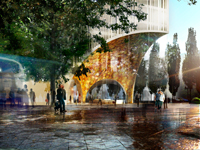 Just one week after winning the design of the new permanent premises for the International Criminal Court in The Hague, schmidt hammer lassen architects wins the architectural competition to design an approx. 40,000 m2 5-star hotel complex in Munich, in the southern part of Germany. This competition is the third large international competition won by schmidt hammer lassen architects in the first quarter of 2010. Just one week after winning the design of the new permanent premises for the International Criminal Court in The Hague, schmidt hammer lassen architects wins the architectural competition to design an approx. 40,000 m2 5-star hotel complex in Munich, in the southern part of Germany. This competition is the third large international competition won by schmidt hammer lassen architects in the first quarter of 2010.
The hotel complex is situated in the newly developed Schwabinger Tor area, along the northern part of the Leopoldstraβe. The challenge in the competition was to bring the architectural characteristics of Munich into this new and modern part of the city. schmidt hammer lassen architects’ design concept has its origin in three themes: the analysis of the historical city with its arches, vaults and arcades; a close relation to the masterplan with its boulevards, plazas and narrow streets; and a focus on human beings as well as the overall experience offered to the hotel guests.
» Read more |
 |
 |
  |
 Grand Canal Theatre by Libeskind to open in Dublin Grand Canal Theatre by Libeskind to open in Dublin |
 |
March 17, 2010
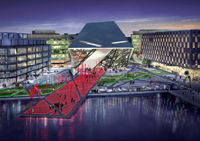 Architect Daniel Libeskind’s Grand Canal Theatre, part of the larger development by Chartered Land, is a dramatic addition to Dublin’s docklands created by a world-class team of designers. The 2100 seat venue, managed by Live Nation Ireland, will open its doors tomorrow for the first time to the public. Architect Daniel Libeskind’s Grand Canal Theatre, part of the larger development by Chartered Land, is a dramatic addition to Dublin’s docklands created by a world-class team of designers. The 2100 seat venue, managed by Live Nation Ireland, will open its doors tomorrow for the first time to the public.
Grand Canal Theatre is a landmark that creates a focus for its urban context, specifically Grand Canal Square, the new urban piazza at the waterfront of Grand Canal Harbour. The Theatre becomes the main façade of a large public piazza, designed by Martha Schwartz Partners, framed by a five star hotel and residences on one side and an office building on the other.
» Read more |
 |
 |
  |
 VitraHaus: Welcome Home VitraHaus: Welcome Home |
 |
March 5, 2010
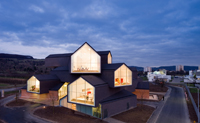 Until recently, the first thing visitors noticed upon arriving at the Vitra Campus in Weil am Rhein was the Vitra Design Museum, a building designed by Frank Gehry. Now a new building, which has been erected next to the museum, is destined to attract just as much attention: the VitraHaus by Herzog & de Meuron. In close proximity to the Swiss border and the furniture manufacture's Basel headquarters, Vitra has created a new domicile for its Home Collection in Weil am Rhein, Germany. Until recently, the first thing visitors noticed upon arriving at the Vitra Campus in Weil am Rhein was the Vitra Design Museum, a building designed by Frank Gehry. Now a new building, which has been erected next to the museum, is destined to attract just as much attention: the VitraHaus by Herzog & de Meuron. In close proximity to the Swiss border and the furniture manufacture's Basel headquarters, Vitra has created a new domicile for its Home Collection in Weil am Rhein, Germany.
In 1981, a major fire destroyed most of the production facilities on the Vitra premises in Weil am Rhein, which dated back to the 1950s. Since that event, a heterogeneous ensemble of contemporary architecture has been constructed on the site. Zaha Hadid realised her very first built structure here. The Vitra Design Museum is the first architectural work by Frank Gehry outside of North America. Tadao Ando constructed his first building outside of Japan. Nicholas Grimshaw, Alvaro Siza and SANAA have each designed a manufacturing facility, and buildings by Richard Buckminster Fuller, Jean Prouvé and Jasper Morrison are also found on the Vitra Campus.
» Read more |
 |
 |
  |
 Study grants - Politecnico di Milano | Architectour.net Study grants - Politecnico di Milano | Architectour.net |
 |
February 14, 2010
 POLI.DESIGN - Consortium of Politecnico di Milano offers 5 study grants for the "Food Experience Design - Designing innovative pizzerias" to all Architectour.net users. POLI.DESIGN - Consortium of Politecnico di Milano offers 5 study grants for the "Food Experience Design - Designing innovative pizzerias" to all Architectour.net users.
For designers and architects a specialization that looks to the future.
The future of the restaurant industry has already started and pizzerias represent a highly potential changing marketplace for architects and designers mastering the creative, aesthetic and planning skills requested by the evolution in the retail, entertainment and hospitality industries.
The 3nd edition of the 120-hour course, with final project work and an educational tour of the most important spaces in Milan, takes place from 10 to 31 March 2010 at POLI.design – Politecnico di Milano (Campus Bovisa).
The teaching staff includes personalities of Politecnico di Milano, who will be in charge of developing topics related to architectural planning, and a selection of experts who will focus on entrepreneurial, technological and sociological topics for a complete view over the sector.
Deadline for application for € 3,500 study grant: March 1, 2010.
The designers selected will pay only the registration fee of € 1,000 + VAT.
» Read more |
 |
 |
  |
 Auditorium Oscar Niemeyer in Ravello, Italy Auditorium Oscar Niemeyer in Ravello, Italy |
 |
January 29, 2010
 Today the inauguration of Ravello's Auditorium Oscar Niemeyer will take place. The setting is the charming Costiera Amalfitana (Amalfi Coast) where you will find this work by one of the biggest names of architecture in the last century: Oscar Niemeyer. The brazilian architect, best known for his buildings in Brasilia, is still in great shape at the age of 103. Today the inauguration of Ravello's Auditorium Oscar Niemeyer will take place. The setting is the charming Costiera Amalfitana (Amalfi Coast) where you will find this work by one of the biggest names of architecture in the last century: Oscar Niemeyer. The brazilian architect, best known for his buildings in Brasilia, is still in great shape at the age of 103.
The project began in 2000 and despite all the hardships and oppositions that in Italy where created, it has finally been brought to completion.
The event will start with three inaugural days containing classical and pop music, dance and cinema, and ample space dedicated to cultural exchanges, reflections as well as an expected homage to Oscar Niemeyer, all without forgetting the refined pleasures of gastronomy. Everything that a modern and elegant auditorium as the Ravello's Auditorium Niemeyer has to offer will be exhibited to the public during these three days.
» Read more |
 |
 |
  |
 Coop Himmelb(l)au: EnergyRoof in Perugia Coop Himmelb(l)au: EnergyRoof in Perugia |
 |
January 18, 2010
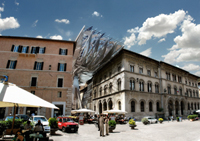 Wolf D. Prix, Design Principal and CEO of Coop Himmelb(l)au presented the design for the Energy Roof in Perugia, Italy. Energy Roof is part of the research project "Walking through the History" of the University of Perugia. Beside the archaeological study this research comprised also the creation of an architectural icon. Wolf D. Prix, Design Principal and CEO of Coop Himmelb(l)au presented the design for the Energy Roof in Perugia, Italy. Energy Roof is part of the research project "Walking through the History" of the University of Perugia. Beside the archaeological study this research comprised also the creation of an architectural icon.
Energy Roof serves as canopy along Via Mazzini in the center of Perugia and at the same time creates the entry point to the archaeological underground passage leading through the history of Perugia. The passage connects the city center with the mini metro station Pincetto. Historical documents show the existence of the old Etruscan city wall in the area below Piazza Giacomo Matteotti which Coop Himmelb(l)au proposes to excavate as part of an underground public gallery space exhibiting the history of Perugia. Openings in the ground of the Piazza Giacomo Matteotti visually connect the underground passage with the Energy Roof.
» Read more |
 |
 |
  |
 Circle Bath, opening of the first hospital designed by Foster + Partners Circle Bath, opening of the first hospital designed by Foster + Partners |
 |
January 17, 2010
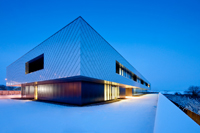 CircleBath is Foster + Partners’ first hospital and the first in a programme of new independent hospitals which offer a radical departure from orthodox approaches to hospital planning. After a period of commissioning, CircleBath is expected to open to patients in February. CircleBath is Foster + Partners’ first hospital and the first in a programme of new independent hospitals which offer a radical departure from orthodox approaches to hospital planning. After a period of commissioning, CircleBath is expected to open to patients in February.
The compact design encourages a sense of community and well-being with facilities more comparable to a luxury hotel rather than a traditional hospital. The three-storey hospital is set into the hills on the edge of protected green belt nine kilometres south east of Bath. It is planned around a central light filled atrium, promoting a sense of orientation and intimacy that is commonly lacking in larger hospitals.
Spencer de Grey, Head of Design at Foster + Partners, commented: “There is a wealth of evidence to suggest that a well-designed hospital environment can reduce recovery times and contribute to better outcomes for patients, while providing a more attractive workplace for medical staff. This is Foster + Partners’ first hospital building and its design is democratic, putting the patient at the heart of the system in a space that does not feel institutionalised and instead takes advantage of the rural setting, the light and the views.”
» Read more |
 |
 |
  |
 Earthquake in Haiti Earthquake in Haiti |
 |
January 15, 2010
SOLIDARITY FUND DONATION
Those who wish to make a contribution through donation may do so also across this channels:
» Save the Children
» Medecins sans Frontieres
» World Food Programme
» Clinton Foundation
» Architecture for Humanity
» Architectes de l'urgence |
 |
 |
  |
 Study grants - Politecnico di Milano | Architectour.net Study grants - Politecnico di Milano | Architectour.net |
 |
January 8, 2010
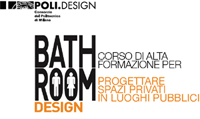 POLI.DESIGN - Consortium of Politecnico di Milano offers 5 study grants for the "Bathroom Design – Designing the bathroom environment for the new public venue" to all Architectour.net users. POLI.DESIGN - Consortium of Politecnico di Milano offers 5 study grants for the "Bathroom Design – Designing the bathroom environment for the new public venue" to all Architectour.net users.
The course, for engineers, architects and designers is aimed on the invention, design and furnishing of bathroom environment in public, hospitality and entertainment venues.
Poli.Design-Consortium of Politecnico di Milano has established the first and only course in Europe of high standard training in “Bathroom Design”, a postgraduate course for architects and designers interested in specialising in design for the bathroom environment in public, hospitality and entertainment venues, in touch with the evolution of the market and the aesthetic languages.
The teaching staff includes the most renowned Italian designers in the hospitality sector and high profile personalities of Politecnico di Milano who will be in charge of the planning, design, furniture and materials topics, and a selected number of experts who will focus on advanced entrepreneurial, technical and technological topics.
The 5nd edition of the 120-hour course, with final project work and an educational tour of the most important spaces in Milan, takes place from 15 February to 5 March at POLI.design – Politecnico di Milano (Campus Bovisa).
Deadline for application for € 3,500 study grant: January 8, 2010.
The designers selected will pay only the registration fee of € 500 + VAT.
» Read more |
 |
 |
  |
 Construction of the new European Central Bank in Frankfurt, to start in spring 2010 Construction of the new European Central Bank in Frankfurt, to start in spring 2010 |
 |
January 15, 2010
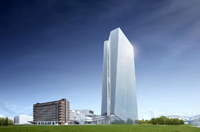 The Governing Council of the European Central Bank (ECB) informed during a press conference about the positive outcome of the Europe-wide public tendering procedure and announced that therefore construction of the main construction works for its new premises will start in spring 2010. The Governing Council of the European Central Bank (ECB) informed during a press conference about the positive outcome of the Europe-wide public tendering procedure and announced that therefore construction of the main construction works for its new premises will start in spring 2010.
Following the announcement, Wolf D. Prix, Design Principal and CEO of Coop Himmelb(l)au, said:
“It is always an exciting moment when an idea becomes reality. We are very pleased about the decision of the Governing Council of the ECB that the new bank headquarters will now be built. I believe that it is not only an important building for us, but also for the European Union, because the building will be one of the important three- dimensional signs of the European Community. I am also proud that we will realize the project without any curtailments or compromises within the given budget.”
» Read more |
 |
 |
  |
 BIG and Fuglark to design Faroe Islands Education Centre BIG and Fuglark to design Faroe Islands Education Centre |
 |
January 4, 2010
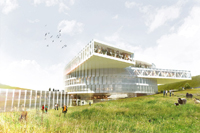 BIG [Bjarke Ingels Group] in collaboration with Fuglark and a team of consultants win the largest ever commission of the Faroe Islands for a 19,200 m2 Education Centre in Marknagil situated on a hillside on the outskirts of Torshavn, to serve as a base for coordination and future development of all educational programmes in the region. As the largest educational building project in the country’s history, the institution combines Faroe Islands Gymnasium, Torshavns Technical College and Business College of Faroe Islands in one building, housing 1.200 students and 300 teachers. The winning design was chosen among five submissions by an unanimous jury, comprised of an architect, representatives from the Ministry of Culture and Landsverk together with principals from each of the three schools and COWI. BIG [Bjarke Ingels Group] in collaboration with Fuglark and a team of consultants win the largest ever commission of the Faroe Islands for a 19,200 m2 Education Centre in Marknagil situated on a hillside on the outskirts of Torshavn, to serve as a base for coordination and future development of all educational programmes in the region. As the largest educational building project in the country’s history, the institution combines Faroe Islands Gymnasium, Torshavns Technical College and Business College of Faroe Islands in one building, housing 1.200 students and 300 teachers. The winning design was chosen among five submissions by an unanimous jury, comprised of an architect, representatives from the Ministry of Culture and Landsverk together with principals from each of the three schools and COWI.
» Read more |
 |
 |
  |
 Balance Balance |
 |
December 28, 2009
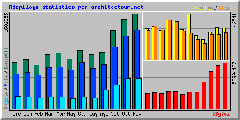 As we come to the end of the year it is time to reflect on the balance and the progress of Architectour.net is increasingly positive. As we come to the end of the year it is time to reflect on the balance and the progress of Architectour.net is increasingly positive.
As you can see from the bar graph above, the continued rise of our site has had a recent further surge. The traffic volume (red graph) has tripled in the last 4 months and the same increase applying to the number of page views (light blue graph).
To an average of more than 1,000 unique visitors per day corresponds an average of about 18,000 page views per day. This means each user views around 18 pages, stays on the site for an average time of almost an hour with a Bounce Rate of 15%: a high assessment.
This data is visible to anyone who wishes to visit Alexa.com and compare our percentages to those of other websites.
Your attention is our motivating force.
Thanks |
 |
 |
  |
 Horizon lines Horizon lines |
 |
December 23, 2009
From the "window" of Contemporary Architecture, that AR offers constantly to its users, to the window of the new office overlooking the sea, AR editorial staff whishes to all its users to never lose sight of the horizon: always look further and keep alive the sense of navigation whether it is real or virtual.
Merry Christmas and Happy New Year
AR editorial staff |
 |
 |
  |
 Study grants - Politecnico di Milano | Architectour.net Study grants - Politecnico di Milano | Architectour.net |
 |
December 19, 2009
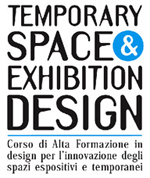 POLI.DESIGN - Consortium of Politecnico di Milano offers 5 study grants for the "Temporary Space & Exhibition Design - Designing temporary stores and innovative exhibition spaces" to all Architectour.net users. POLI.DESIGN - Consortium of Politecnico di Milano offers 5 study grants for the "Temporary Space & Exhibition Design - Designing temporary stores and innovative exhibition spaces" to all Architectour.net users.
The course, for engineers, architects and designers is aimed on the invention, design and furnishing of trade show booths and innovative temporary spaces, which are becoming increasingly relevant within retail and the trade show industry, where the designer plays a growing role.
The 2nd edition of the 160-hour course, with final project work and an educational tour of the most important spaces in Milan, takes place from 18 January to 12 February 2010 at POLI.design – Politecnico di Milano (Campus Bovisa).
Deadline for application for € 3,000 study grant: January 8, 2010.
The designers selected will pay only the registration fee of € 1,000 + VAT.
» Read more |
 |
 |
  |
 Wilkinson Eyre Architects, Bath Bus Station Wilkinson Eyre Architects, Bath Bus Station |
 |
November 23, 2009
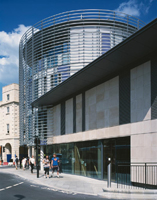 Wilkinson Eyre Architects has completed its bus station project in the UNESCO World Heritage City of Bath Spa, UK. Wilkinson Eyre Architects has completed its bus station project in the UNESCO World Heritage City of Bath Spa, UK.
The scheme, a complex transport interchange on an incredibly sensitive and tight site, is an exciting new contemporary structure, built in the centre of one of an World Heritage Cities in the World. Instead of trying to emulate the traditional architecture of Bath, Wilkinson Eyre Architects has combined a mix of glass, steel, aluminium and stone to create a contrast to the surrounding buildings and make a composition of the new and the old.
The basic diagram of the scheme relocates the bus station to the same side of the street as the original Grade II* listed Bath Spa railway station by Brunel, improving the visual connection and safe interchange between the two vital transport nodes. This connection will be completed through the introduction of a new civic plaza in the second phase of the redevelopment.
» Read more |
 |
 |
  |
 Study grants - Politecnico di Milano | Architectour.net Study grants - Politecnico di Milano | Architectour.net |
 |
November 13, 2009
 POLI.DESIGN - Consortium of Politecnico di Milano offers 5 study grants for the "Temporary Space & Exhibition Design - Designing temporary stores and innovative exhibition spaces" to all Architectour.net users. POLI.DESIGN - Consortium of Politecnico di Milano offers 5 study grants for the "Temporary Space & Exhibition Design - Designing temporary stores and innovative exhibition spaces" to all Architectour.net users.
The course, for engineers, architects and designers is aimed on the invention, design and furnishing of trade show booths and innovative temporary spaces, which are becoming increasingly relevant within retail and the trade show industry, where the designer plays a growing role.
The 2nd edition of the 160-hour course, with final project work and an educational tour of the most important spaces in Milan, takes place from 18 January to 12 February 2010 at POLI.design – Politecnico di Milano (Campus Bovisa). Deadline for application for € 3,000 study grant: 30 November.
The designers selected will pay only the registration fee of € 1,000 + VAT.
» Read more |
 |
 |
  |
 Foster + Partners' Opera House opens in Dallas Foster + Partners' Opera House opens in Dallas |
 |
November 3, 2009
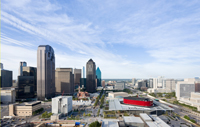 The new Margot and Bill Winspear Opera House in Dallas redefines the opera house for the 21st century, breaking down barriers to make opera more accessible for a wider audience. Responding to the Dallas climate, a solar canopy extends from the building, shading a fully glazed, sixty-foot-tall lobby which enhances the transparency of the building. This establishes a direct relationship between inside and outside, creating greater accessibility and thus a more democratic building. Beneath the canopy, which forms an integral part of the environmental strategy, a shaded pedestrian plaza creates a major new public space for Dallas, as defined by the masterplan designed by Foster + Partners and OMA for the AT&T Performing Arts Center. The new Margot and Bill Winspear Opera House in Dallas redefines the opera house for the 21st century, breaking down barriers to make opera more accessible for a wider audience. Responding to the Dallas climate, a solar canopy extends from the building, shading a fully glazed, sixty-foot-tall lobby which enhances the transparency of the building. This establishes a direct relationship between inside and outside, creating greater accessibility and thus a more democratic building. Beneath the canopy, which forms an integral part of the environmental strategy, a shaded pedestrian plaza creates a major new public space for Dallas, as defined by the masterplan designed by Foster + Partners and OMA for the AT&T Performing Arts Center.
Norman Foster said:
“This project is about the creation of a building that offers a truly democratic experience of opera for the 21st century. We wanted to create a sense of immediacy – from the moment you step into the external plaza to the opening of the curtain – and we wanted the auditorium to be expressed on the outside, the red glass drum is a symbol of performance, the glowing heart of the entire AT&T Performing Arts Center.”
» Read more |
 |
 |
  |
 Asymptote in Abu-Dhabi: a Formula 1 Hotel Asymptote in Abu-Dhabi: a Formula 1 Hotel |
 |
October 30, 2009
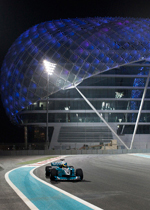 The opening of the iconic Yas Hotel, designed by New York City based Asymptote Architecture’s Hani Rashid and Lise Anne Couture, coinciding with the inaugural Formula 1 Etihad Airways Abu Dhabi Grand Prix on November 1 marks Abu Dhabi as a cultural destination for the 21st Century. The opening of the iconic Yas Hotel, designed by New York City based Asymptote Architecture’s Hani Rashid and Lise Anne Couture, coinciding with the inaugural Formula 1 Etihad Airways Abu Dhabi Grand Prix on November 1 marks Abu Dhabi as a cultural destination for the 21st Century.
The Yas Hotel as envisioned by Asymptote, is the world's first building designed to span a Grand Prix race circuit and will open it's doors to coincide with the inaugural 2009 Formula 1 Ethiad Airways Abu Dhabi Grand Prix on November 1st. The Formula 1 event will be the largest sporting event ever held in the UAE and the Yas Hotel is designed to be it's centerpiece and icon, helping transform Abu Dhabi into the new important and exciting cultural destination in the region.
Aldar Properties PJSC awarded Asymptote the commission to design the 85,000-square-meter complex from a closed competition two years ago. Asymptote founders and principals Hani Rashid and Lise Anne Couture have created an architectural landmark embodying inspirations ranging from the aesthetics and forms associated with speed, movement and spectacle to the artistry and geometries forming the basis of ancient Islamic art and craft traditions.
» Read more |
 |
 |
  |
 UNStudio: Dalian Football Stadium UNStudio: Dalian Football Stadium |
 |
October 21, 2009
 UNStudio has won the limited competition for a 40,000 spectator football stadium for the most successful club in the Chinese Super League: Dalian Shide FC. The stadium will be built in the club’s hometown of the city of Dalian, on the southern tip of Liaodong peninsula in Northeast China. UNStudio has won the limited competition for a 40,000 spectator football stadium for the most successful club in the Chinese Super League: Dalian Shide FC. The stadium will be built in the club’s hometown of the city of Dalian, on the southern tip of Liaodong peninsula in Northeast China.
The design for the 38,500 m2 stadium has been inspired by the colourful layering and overlapping of the ancient Chinese cuju football. The design weaves together the collective spirit of the spectators with the public realm and the urban context of the building. The main stadium houses spectator seating, TV broadcasting centre, administration areas, VIP lounge, players facilities and public concourse in a layered envelope which extends on ground level to provide outdoor public areas above decked parking facilities. In addition, the design incorporates two training fields on the 144,000 m2 site.
» Read more |
 |
 |
  |
 Santiago Calatrava: Liege-Guillemins TGV Railway Station Santiago Calatrava: Liege-Guillemins TGV Railway Station |
 |
September 24, 2009
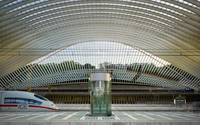 Last Friday, Santiago Calatrava has unveiled one of his most ambitious architectural projects to date; the Liège-Guillemins TGV Railway Station in Belgium. Designed by Calatrava to meet the demands of high-speed travel, the station will bring new life into the industrial city of Liège, while positioning it as the epicenter of the North European High-Speed Network Last Friday, Santiago Calatrava has unveiled one of his most ambitious architectural projects to date; the Liège-Guillemins TGV Railway Station in Belgium. Designed by Calatrava to meet the demands of high-speed travel, the station will bring new life into the industrial city of Liège, while positioning it as the epicenter of the North European High-Speed Network
The grand opening was presided over by: Prime Minister Herman Van Rompuy, international dignitaries and members of the royal family, including Prince Philippe of Belgium. Also participating in the celebration were members of the press and representatives from Euro Liège TGV and SNCB Holding including Jean-Claude Fontinoy (president), Jannie Haek (CEO) and Vincent Bourlard (general manager).
Calatrava was first commissioned to design the new Liège-Guillemins Station in 1996, after Euro Liège TGV determined that the existing station was unsuitable for the demands of high-speed rail travel. Immediately, the starchitect was faced with a seemingly impossible task; replacing the existing station without interrupting train service or disturbing the 36,000 people who frequent the facility on a daily basis. Using a technique normally employed in bridge construction, Calatrava was able to accommodate this request, while preserving the integrity of his design.
» Read more |
 |
 |
  |
 Study grants - Politecnico di Milano Study grants - Politecnico di Milano |
 |
September 16, 2009
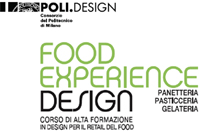 POLI.DESIGN, Consortium of Politecnico di Milano offers 6 study grants, € 4.000 each, for the Food Experience Design Course to all registered users of Architectour.net. POLI.DESIGN, Consortium of Politecnico di Milano offers 6 study grants, € 4.000 each, for the Food Experience Design Course to all registered users of Architectour.net.
Food Experience Design is the only course for the creation, design and furnishing of new food retailers, outlets that are now becoming innovative multifunctional spaces with a high level of design content often with on-site consumption and bar area.
The 4th edition of the course is addressed to graduates of first and second degree, preferably in architecture, design or engineering, and professionals interested in specialising in the design and layout planning of innovative retail outlets for the food retail sector. The course develops for a total of 224 hours of frontal lessons, with a final project and an educational tour to the most innovative realizations in Milan. The course is held from 28th September to 11th November 2009, it will take place at POLI.design - Politecnico di Milano (Campus Bovisa).
For programme and schedule: www.foodexperiencedesign.it
» Read more |
 |
 |
  |
 Under construction: Coop Himmelb(l)au in Dalian, China Under construction: Coop Himmelb(l)au in Dalian, China |
 |
August 24, 2009
 Construction is speeding up on the seafront site for the Dalian International Conference Center, as the ambitious target is to host the annual "Summer Davos" Summit in September 2010. The 120,000 square meter project comprises a state of the art conference center for up to 7,000 visitors as well as an opera house for 1,600 guests. Coop Himmelb(l)au had been selected as winner of the invited competition in August 2008 out of entries by Zaha Hadid Architects or GMP von Gerkan, Marg und Partner amongst others. The groundbreaking ceremony took place in November, in attendance of Mayor Xia Deren, followed by the structural works for the basement as well as the 30,000 ton steel construction by just April 2009. Steel construction is scheduled to be finished by the end of September this year. Construction is speeding up on the seafront site for the Dalian International Conference Center, as the ambitious target is to host the annual "Summer Davos" Summit in September 2010. The 120,000 square meter project comprises a state of the art conference center for up to 7,000 visitors as well as an opera house for 1,600 guests. Coop Himmelb(l)au had been selected as winner of the invited competition in August 2008 out of entries by Zaha Hadid Architects or GMP von Gerkan, Marg und Partner amongst others. The groundbreaking ceremony took place in November, in attendance of Mayor Xia Deren, followed by the structural works for the basement as well as the 30,000 ton steel construction by just April 2009. Steel construction is scheduled to be finished by the end of September this year.
The International Conference Center is located in Dalian, an important seaport, industrial, trade and tourism center, located in the southernmost part of the Liaodong Peninsula in the Chinese Liaoning Province.
» Read more |
 |
 |
  |
 UNStudio in China: Raffles City UNStudio in China: Raffles City |
 |
August 14, 2009
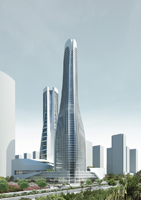 UNStudio’s mixed-use Raffles City development is located near the Qiangtan River in Hangzhou, the capital of Zhejiang province, located 180 kilometres southwest of Shanghai. With a city population of 1.69 million, Hangzhou is one of the most renowned and prosperous cities in China and is well known for its beautiful natural scenery, particularly in the West Lake area. UNStudio’s mixed-use Raffles City development is located near the Qiangtan River in Hangzhou, the capital of Zhejiang province, located 180 kilometres southwest of Shanghai. With a city population of 1.69 million, Hangzhou is one of the most renowned and prosperous cities in China and is well known for its beautiful natural scenery, particularly in the West Lake area.
UNStudio’s Raffles City in Hangzhou will be CapitaLand’s sixth Raffles City, following those in Singapore, Shanghai, Beijing, Chengdu and Bahrain. UNStudio’s Raffles City Hangzhou incorporates retail, offices, housing and hotel facilities and marks the site of a cultural landscape within the Quianjiang New Town Area.
According to Ben van Berkel, “The philosophy behind the Raffles City concept is to integrate mixed use in an urban context, but in such a way as to give this concept a twist; by focussing on where the urban context meets the landscape of the city. In the design of the towers the urban element of the project twists towards the landscape, whilst the landscape aspect, in turn, twists towards the urban context, thereby effecting the incorporation and consolidation of these separate elements in one formal gesture.”
» Read more |
 |
 |
  |
 Rebuildings: Graft in New Orleans Rebuildings: Graft in New Orleans |
 |
July 22, 2009
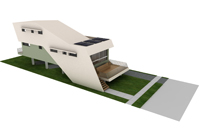 By April 2009 a total of 6 houses have been finished as part of the Make It Right Program, the initiative promoted by Brad Pitt for the ricostruction of Lower 9th Ward on New Orleans, devastated by hurricane Katrina on 2005. The owners were able to move back and enjoy the benefits of their new homes. Two of these houses were designed by Graft and chosen by the homeowners, as the process at Make It Right is individual choice of the design. 9 more houses are currently under construction, one of them also designed by Graft, 10 houses are in the permit process. By April 2009 a total of 6 houses have been finished as part of the Make It Right Program, the initiative promoted by Brad Pitt for the ricostruction of Lower 9th Ward on New Orleans, devastated by hurricane Katrina on 2005. The owners were able to move back and enjoy the benefits of their new homes. Two of these houses were designed by Graft and chosen by the homeowners, as the process at Make It Right is individual choice of the design. 9 more houses are currently under construction, one of them also designed by Graft, 10 houses are in the permit process.
The houses designed by Graft are inspired by the Cradle to Cradle Philosophy and received LEED Platinum certification. They are prefabricated modular units, constructed off-site.
After the success of the first round of designs for the Lower Ninth Ward a new group of architects was invited to design dwellings. Graft donated another design, this time with a larger building for up to two families. The Round 2 house deploys a similar formal strategy of blending as does Graft’s Round 1 shotgun house. A strong visual connection to the Round 1 house was maintained in order to bring consistency of character to the New Orleans’ Lower Ninth Ward, which will continue to be populated by these types of dwellings. Here, it was taken additionally drawn inspiration from the camelback shotgun typology. Historically, camelbacks emerged as a way for residents to add a partial second story to a residence, whether simply to gain more space for a single-family home or to add a rental unit at the rear of a structure. In these project, it's been utilized the camelback strategy to stack a second efficiency unit above a first floor shotgun house.
» Read more |
 |
 |
  |
 C.F. Moller and Kristin Jarmund designed a new landmark for Oslo C.F. Moller and Kristin Jarmund designed a new landmark for Oslo |
 |
July 17, 2009
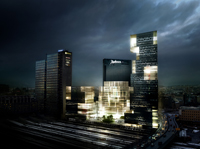 C.F. Møller Architects, in collaboration with Kristin Jarmund Arkitekter, has won a major competition to design a spectacular new landmark project in the city of Oslo, for the client KLP Eiendom AS, one of Norway's largest property investors. The project, which has been dubbed "Crystal Clear", consists of three towers, which grow organically from the ground to form a sculptural cluster, and are composed of stacked, prismatic volumes. C.F. Møller Architects, in collaboration with Kristin Jarmund Arkitekter, has won a major competition to design a spectacular new landmark project in the city of Oslo, for the client KLP Eiendom AS, one of Norway's largest property investors. The project, which has been dubbed "Crystal Clear", consists of three towers, which grow organically from the ground to form a sculptural cluster, and are composed of stacked, prismatic volumes.
The development totals approx. 90,000 m² of offices, commercial space and possibly housing, located at one of Oslo's most valuable sites, the former postal sorting office adjacent to the central station. "Crystal Clear" ties in with the city's skyline, and the string of developing landmark projects that will help turn Oslo into one of Europe's most modern capitals.
Partner and architect Mads Mandrup Hansen states:
""Crystal Clear" is a unique proposal for a modern, Nordic cluster of towers - a Norwegian urban rock, that in an exiting way adds to the city's strategic endeavour to interlace town and port into a contemporary and lively waterfront, and at the same time fulfils the client KLP Eiendom AS' vision to build the most groundbreaking high-rise offices in Scandinavia."
» Read more |
 |
 |
  |
 Serpentine Gallery Pavilion 2009 designed by SANAA Serpentine Gallery Pavilion 2009 designed by SANAA |
 |
July 8, 2009
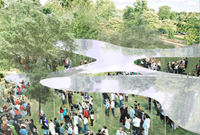 The Serpentine Gallery Pavilion 2009 is designed by Kazuyo Sejima and Ryue Nishizawa of leading Japanese architecture practice SANAA. The Pavilion, which is sponsored by NetJets Europe, opens on 12 July on the Serpentine Gallery’s lawn where it will remain until 18 October. The Serpentine Gallery Pavilion 2009 is designed by Kazuyo Sejima and Ryue Nishizawa of leading Japanese architecture practice SANAA. The Pavilion, which is sponsored by NetJets Europe, opens on 12 July on the Serpentine Gallery’s lawn where it will remain until 18 October.
Describing their structure the architects said: ‘The Pavilion is floating aluminium, drifting freely between the trees like smoke. The reflective canopy undulates across the site, expanding the park and sky. Its appearance changes according to the weather, allowing it to melt into the surroundings. It works as a field of activity with no walls, allowing uninterrupted view across the park and encouraging access from all sides. It is a sheltered extension of the park where people can read, relax and enjoy lovely summer days.’
Sejima and Nishizawa have created a stunning Pavilion that resembles a reflective cloud or a floating pool of water, sitting atop a series of delicate columns. The metal roof structure varies in height, wrapping itself around the trees in the park, reaching up towards the sky and sweeping down almost to the ground in various places. Open and ephemeral in structure, its reflective materials make it sit seamlessly within the natural environment, reflecting both the park and sky around it.
The Pavilion will be the architects’ first built structure in the UK and the ninth commission in the Gallery’s annual series of Pavilions, the world’s first and most ambitious architectural programme of its kind that annually gives preeminent architects their debut in this country and brings the best of contemporary architecture to London for everyone to enjoy.
» Read more |
 |
 |
  |
 BIG wins a Competition to design Tallinn’s new City Hall BIG wins a Competition to design Tallinn’s new City Hall |
 |
June 24, 2009
 An international idea contest was held for Tallinn’s new City Hall in Estonia and the best concept was presented by the Bjarke Ingels Group from Denmark, authored by Bjarke Ingels and Jakob Lange and Adams Kara Taylor. An international idea contest was held for Tallinn’s new City Hall in Estonia and the best concept was presented by the Bjarke Ingels Group from Denmark, authored by Bjarke Ingels and Jakob Lange and Adams Kara Taylor.
The purpose of the international idea contest was to find the best architectural solution for the new administrative building of the city government that will be situated on a 35,000 m2 plot near the Linnahall building. The contest for the new City Hall was met with a great interest, 81 architects and their teams were willing to present an entry. Of those, the international jury chose the best 9 to shortlist as finalists into the second phase of the competition. By May 15 the finalists handed in their final solutions. The international jury’s decision to award BIG’s entry first place in the competition was unanimous and was presided by the vice mayor Taavi Aas.
Bjarke Ingels, BIG Partner-in-Charge, said: "There is a saying that success has many fathers. That is especially true when designing such a crucial public building and public space as a town hall. The design needs to be shaped by input from neighbors’ and users, citizens and politicians. Paradoxically we architects often find ourselves isolated from this crucial dialogue at the moment of conception, due to the anonymity of the architectural competition. Since this was a 2 stage competition, we already had our first feedback from the jury – causing us to dramatically rearrange our design to fit the citizens’ needs. As a result we have envisioned a very elastic structure – capable of adapting to unexpected demands. We see it as the first conversation in a design dialogue we look forward to continue."
» Read more |
 |
 |
  |
 The new Acropolis Museum in Athens The new Acropolis Museum in Athens |
 |
June 19, 2009
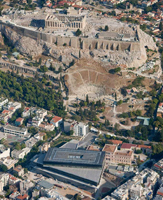 The historic masterpieces of the New Acropolis Museum - including the archaeological remains of ancient Athens left visible beneath the building and portions of the glorious Parthenon Frieze installed at the top - will be displayed in total for the first time when the Museum celebrates its much-anticipated official opening on Saturday, June 20, 2009. The historic masterpieces of the New Acropolis Museum - including the archaeological remains of ancient Athens left visible beneath the building and portions of the glorious Parthenon Frieze installed at the top - will be displayed in total for the first time when the Museum celebrates its much-anticipated official opening on Saturday, June 20, 2009.
Designed by Bernard Tschumi Architects of New York/Paris with Michael Photiadis of Athens as local associate architect, the Museum has presented a number of temporary exhibitions in a lower-floor gallery over the pastyear. With the official opening, visitors will at last view the full suite of galleries, presented in a dramatic architectural experience designed explicitly for this collection. With more than 150,000 square feet (14,000 sq.m.) of exhibition space - ten times more than the previous Acropolis museum - the New Acropolis Museum will display surviving antiquities from the Acropolis and serve as a catalyst for strengthening international interest in the classical world. The 226,000 square feet (21,000 sq.m.) Museum is both a defining cultural project for Greece and a key reference point for the art community around the globe. To present the unparalleled collection, architect and lead designer Bernard Tschumi created a deliberately non-monumental structure whose simple and precise design invokes the mathematical and conceptual clarity of ancient Greek architecture. “The form of the building arose as a response to the challenges of creating a structure that was worthy of housing the most dramatic sculptures of Greek antiquity, and doing so in an over whelmingly historic and monumental setting,” explains Tschumi. “The site at the foot of the Acropolis confronted us with the Parthenon itself, one of the most influential buildings in Western civilization. At the same time, we had to consider the sensitive archaeological excavations, the presence of the contemporary city and its street grid, and the special challenges of the hot climate in Athens and an earthquake region.”
» Read more |
 |
 |
  |
 Marcello D'Olivo: Baghdad and Ecotown Marcello D'Olivo: Baghdad and Ecotown |
 |
June 10, 2009
 The inaugural opening of the exhibition of Marcello D’Olivo (Udine, 1921-1991) will be held on Friday 12 June 2009 at 18:00 at the Galleries Project of Palazzo Morpurgo in Udine (a collaborative project of the Udine Gallery of Modern Art and the Festival of Architecture of Parma and Reggio Emilia). The show focuses on two moments in particular that are among the most significant in the artist’s architectonic poetry: the Monument to the Unknown Soldier in Baghdad and the designs for Ecotown, the “ecological city” that was never brought to fruition. The exhibition, along with the museum’s previous shows dedicated to the work of Gino Valle and Raimondo D’Aronco, is part of an effort to promote the international work of Friulian architects, and is sponsored by the Ministry of Foreign Affairs, the Embassy of Republic of Iraq in Italy and the Superintendence of Archives of Friuli Venezia Giulia. The inaugural opening of the exhibition of Marcello D’Olivo (Udine, 1921-1991) will be held on Friday 12 June 2009 at 18:00 at the Galleries Project of Palazzo Morpurgo in Udine (a collaborative project of the Udine Gallery of Modern Art and the Festival of Architecture of Parma and Reggio Emilia). The show focuses on two moments in particular that are among the most significant in the artist’s architectonic poetry: the Monument to the Unknown Soldier in Baghdad and the designs for Ecotown, the “ecological city” that was never brought to fruition. The exhibition, along with the museum’s previous shows dedicated to the work of Gino Valle and Raimondo D’Aronco, is part of an effort to promote the international work of Friulian architects, and is sponsored by the Ministry of Foreign Affairs, the Embassy of Republic of Iraq in Italy and the Superintendence of Archives of Friuli Venezia Giulia.
The exhibition is divided into two sections and displays the results of a systematic cataloguing of D’Olivo’s designs for the capital of Iraq and for Ecotown from the architecture archives of Palazzo Morpurgo in Udine, along with a vast array of documentation and photographs and a section dedicated to D’Olivo’s paintings.
In 1979 D’Olivo began his Commemorative Monument to the Unknown Soldier in the heart of Baghdad, commissioned by Saddam Hussein: a project of great sculptural value and a bold structural concept elegantly executed. Period photographs, recent images, original documents and drawings reconstruct one of D’Olivo’s most extraordinary works, which has survived Iraq’s tragic episodes of war.
The second section is dedicated to Ecotown, the urban design initially conceived for the area between Padua, Mestre and Treviso. On exhibit are not only the sketches and drawings that have already been published in contexts of architectural design, but also materials which for the most part have never been exhibited and allow for an in-depth look at lesser-known aspects of the architect’s designs.
» Read more |
 |
 |
  |
 Foster + Partners appointed to design Slussen masterplan in central Stockholm Foster + Partners appointed to design Slussen masterplan in central Stockholm |
 |
June 9, 2009
 Foster + Partners and Berg Arkitektkontor, part of C.F. Møller Architects, have been appointed to design a masterplan for the heart of Stockholm, transforming the waterfront area of Slussen from an urban aberration to a popular destination. The proposal will bring new life to the area, linking the islands of Södermalm and Gamla Stan and stripping away the layers of history to reclaim a valuable city quarter. Foster + Partners and Berg Arkitektkontor, part of C.F. Møller Architects, have been appointed to design a masterplan for the heart of Stockholm, transforming the waterfront area of Slussen from an urban aberration to a popular destination. The proposal will bring new life to the area, linking the islands of Södermalm and Gamla Stan and stripping away the layers of history to reclaim a valuable city quarter.
For so long separated by a maze of roads and acres of concrete, the two waterfronts will be linked by a new footbridge and the historic lock will be revealed once more to provide a symbol for the area’s regeneration. The masterplan re-establishes the waterfront to give Södermalm a new face. While contemporary in concept, the buildings that form the new city blocks continue the grain and scale of the adjacent urban quarter, retaining the long street views to the water and defining new public squares and extensive waterfront promenades. Their flexible nature allows for a rich mixture of uses, from culture and entertainment to shops and hotels, while the uninterrupted pedestrian quayside incorporates terraces, and promenades served directly by new cafés and restaurants.
At the heart of the new Slussen is an elegant footbridge, which fuses straight and S-shaped decks to complete the missing link in the north-south pedestrian route across central Stockholm. The historic Katarinahissen will also be renovated and extended to serve the quayside level, with a new observation deck built at its top to offer spectacular views over the city’s archipelago.
» read more |
 |
 |
  |
 UNStudio/Ben van Berkel’s design selected for new hotel tower in Frankfurt UNStudio/Ben van Berkel’s design selected for new hotel tower in Frankfurt |
 |
June 8, 2009
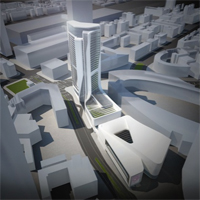 UNStudio was selected in the competition for a 110 meter tall hotel tower. UNStudio was selected in the competition for a 110 meter tall hotel tower.
From the six projects presented, the jury, chaired by Prof. Johann Eisele, chose the designs by UNStudio - Ben van Berkel (Amsterdam), and Kohn, Pedersen, Fox (New York) and recommended proceeding with the UNStudio design for further development.
According to Ben van Berkel the design for the Grand Hyatt tower celebrates and highlights the cosmopolitan character and diversity of Frankfurt. "It has three different elevations that are linked to the different aspects of the city. The tower takes up the variation and diversity offered by the city of Frankfurt and reflects that multiplicity of experiences back to the city itself. The tower can be perceived differently from each perspective; it appears needle-thin from one spot, strong and straight from another, and complex with a slight twist from yet another."
The new tower will house a 5-star-plus hotel with 405 rooms and suites, a ballroom, spa, various restaurants, a lobby bar and a public Sky Lounge on the top floor, and the possibility of an adjacent congress center. The hotel tower consists of 22 floors at a height of approximately 110 metres and an area of 54,562.70 m2 for hotel tower + plinth.
» Read more |
 |
 |
  |
 Rotterdam, the Fire Limits Rotterdam, the Fire Limits |
 |
May 19, 2009
 The first section of the permanent marking of the Rotterdam Brandgrens (fire limits), designed by West 8 for the City of Rotterdam, was officially unveiled by Mayor Ahmed Aboutaleb on May 14th. Together with survivors of the Rotterdam bombing and collaborators on the project, Aboutaleb lit the first eighteen light objects of the four hundred in total designed by West 8 to permanently mark the areas destroyed by German bombs. The first section of the permanent marking of the Rotterdam Brandgrens (fire limits), designed by West 8 for the City of Rotterdam, was officially unveiled by Mayor Ahmed Aboutaleb on May 14th. Together with survivors of the Rotterdam bombing and collaborators on the project, Aboutaleb lit the first eighteen light objects of the four hundred in total designed by West 8 to permanently mark the areas destroyed by German bombs.
The Brandgrens marks the areas of the city that were destroyed by the aerial bombardment of 14 May 1940 and the ensuing fires that broke out. In 2006 the city of Rotterdam decided to permanently mark the Brandgrens in the streetscape. West 8 (together with Opera Graphic Design) designed a 11,5 kilometer long track of circular light objects set in the ground. An iconic image is incorporated in these light objects, lit by red and green LED-light. The image combines the burning city, the silhouette of a Heinkel bomber, and the contours of the desperate arms and head of Zadkine’s statue commemorating the bombing of Rotterdam. The icon literally shows the terror, the suffering, and the burning city with the German bomber overhead. This physical marking of the Brandgrens includes several information stations also designed by West 8 and is linked to a website that contains information about the bombing of Rotterdam, including photo’s and eye-witness reports.
» Read more |
 |
 |
  |
 Jewish Museum Berlin's expansion Jewish Museum Berlin's expansion |
 |
May 15, 2009
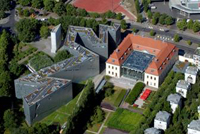 The Jewish Museum Berlin’s long desire to expand will now become a reality. The Museum has been granted its much-needed expansion into the area on the opposite side of the road which currently houses Berlin’s Central Flower Market and the project was entrusted to Studio Daniel Libeskind. The space provided by the expansion into the market hall will satisfy the Museum’s urgent need for additional room for educational programs, the archives, the library, and research facilities. The Jewish Museum Berlin’s long desire to expand will now become a reality. The Museum has been granted its much-needed expansion into the area on the opposite side of the road which currently houses Berlin’s Central Flower Market and the project was entrusted to Studio Daniel Libeskind. The space provided by the expansion into the market hall will satisfy the Museum’s urgent need for additional room for educational programs, the archives, the library, and research facilities.
André Schmitz, State Secretary for Cultural Affairs in Berlin, has approved the project, ensuring that the state of Berlin will hand over the use and management of the entire hall to the Jewish Museum Berlin. The expansion has become necessary due to the growth of the education and research areas at the Jewish Museum Berlin. The purpose of the new building is to bring the education department, the archive, and the library under one roof, thus creating a synergy between scientific research and educational work. Direct access to information, more room for an ideas exchange, transfer of knowledge, and encounters – the new location will ensure all these and more. The objective is to establish, in Berlin, one of the most important research and education centers on the history and culture of German-speaking Jewry.
The existing building designed by architect Bruno Grimmek between 1962 and 1965 will not be demolished, but merely modified to suit the requirements of the Jewish Museum Berlin. Construction work can begin in 2010 when the approximately 6,000 m² hall will be vacated by the Berlin Central Market, which will move to the Beusselstrasse.
» Read more |
 |
 |
  |
 The tallest building in Milan The tallest building in Milan |
 |
May 8, 2009
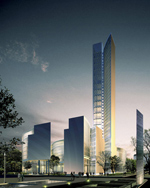 Today the construction of the "Altra Sede" (Other Office) of the Lombardy Region rises to 127,40 metres, officially substituting the Pirelli skyscraper in the primacy of the highest building in Milan. Gio Ponti and Pier Luigi Nervi's buiding in 1960 had been the first skyscraper to pass the height of the "Madunina" (the statue of the Virgin Mary on the top of the Cathedral of Milan), since even the BBPR's Velasca Tower, built two years before the Pirelli Building, was two metres shorter than the hieght of the statue. Today the construction of the "Altra Sede" (Other Office) of the Lombardy Region rises to 127,40 metres, officially substituting the Pirelli skyscraper in the primacy of the highest building in Milan. Gio Ponti and Pier Luigi Nervi's buiding in 1960 had been the first skyscraper to pass the height of the "Madunina" (the statue of the Virgin Mary on the top of the Cathedral of Milan), since even the BBPR's Velasca Tower, built two years before the Pirelli Building, was two metres shorter than the hieght of the statue.
By the end of the year, the tower designed by Pei Cobb Freed & Partners will be 166 metres tall, but this new primacy will not last long as it will be passed by the CityLife towers, designed by Zaha Hadid, Daniel Libeskind and Arata Isozaki for the ex-Fair area.
Roberto Formigoni, Governor of the Lombardy Region, says "The construction of the "Altra Sede" is part of the revival programme for the city of Milan which was decided a few years ago by the Region and the municipality. This is the first work that will be completed, which proves that great deeds can be done. We are not condemned to decline or to remaining still in passed grandeurs.
» Read more |
 |
 |
  |
 The Mies van der Rohe Award to Snøhetta The Mies van der Rohe Award to Snøhetta |
 |
April 29, 2009
 The European Commission and the Fundació Mies van der Rohe announced today that the Norwegian National Opera & Ballet, Oslo, Norway by Snøhetta is the winner of the European Union Prize for The European Commission and the Fundació Mies van der Rohe announced today that the Norwegian National Opera & Ballet, Oslo, Norway by Snøhetta is the winner of the European Union Prize for
Contemporary Architecture – Mies van der Rohe Award 2009.
The Jury also awarded the Emerging Architect Special Mention to STUDIO UP/Lea Pelivan and Toma Plejić for Gymnasium 46°09'N/16°50'E, Koprivnica, Croatia.
The 60,000 € Prize funded with support by the European Union, one of the most important and prestigious prizes for international architecture, is awarded biennially to built works completed within the previous two years.
By supporting the prize, the European Commission underlines the role of architecture as a driver for creativity and innovation, opens up culture to audiences beyond national borders and draws attention to the European professionals' contribution in the development of new ideas and technologies that impact Europeans' everyday life.
The winner of the Prize was selected from a shortlist of five finalists:
- Zenith Music Hall, Strasbourg (France) by Studio Fuksas/Massimiliano & Doriana Fuksas;
- Luigi Bocconi University, Milan (Italy) by Grafton Architects/Shelley McNamara, Yvonne Farrell;
- Norwegian National Opera & Ballet, Oslo (Norway) by Snøhetta/Kjetil Trædal Thorsen, Tarald Lundevall, Craig Dykers;
- Multimodal Centre – Nice Tramway, Nice (France) by Atelier Marc Barani;
- Library, Senior Citizens' Centre and Interior Courtyard, Barcelona (Spain) by RCR Arquitectes.
The finalists were selected from 340 projects proposed by the Architects' Council of Europe (ACE) member associations, other national architectural associations, the group of Experts and the Advisory Committee.
» Read more |
 |
 |
  |
 Ca' Foscari Tour: the University of Venice opens its doors Ca' Foscari Tour: the University of Venice opens its doors |
 |
April 16, 2009
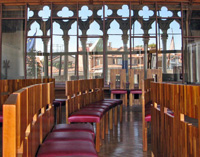 Starting in 2009 a new service of guided tours of Ca' Foscari, the historical headquarters of the University of Venice that bears its name will be offered. The palace has enchanted for centuries famous people, renowned artists and visitors worldwide. Its scenographic setting "at the turn of the canal" was one of the reasons for which the doge Francesco Foscari bought this building in 1492 and then had it reconstructed following the architectural canons that made the palace a remarkable example of of venetian gothic. Starting in 2009 a new service of guided tours of Ca' Foscari, the historical headquarters of the University of Venice that bears its name will be offered. The palace has enchanted for centuries famous people, renowned artists and visitors worldwide. Its scenographic setting "at the turn of the canal" was one of the reasons for which the doge Francesco Foscari bought this building in 1492 and then had it reconstructed following the architectural canons that made the palace a remarkable example of of venetian gothic.
Visitors can admire the external courtyards, the Gothic windows, the Aula Magna Mario Baratto designed by Carlo Scarpa, Sironi and De Luigi's frescos and the most recent findings of the last restoration, which used highly technological solutions to save the palace from the tidal ongoings of the water: it will be possible to discover the "treasures" of the palace, in an itinerary of art and history, with a guided tour given by properly trained staff.
» For details and information |
 |
 |
  |
 Peter Zumthor of Switzerland becomes the 2009 Pritzker Architecture Prize Laureate Peter Zumthor of Switzerland becomes the 2009 Pritzker Architecture Prize Laureate |
 |
April 13, 2009
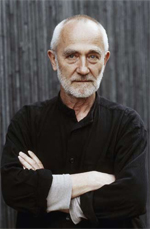 Peter Zumthor of Switzerland has been chosen as the 2009 Laureate of the Pritzker Architecture Prize. The formal ceremony for what has come to be known throughout the world as architecture’s highest honor will be held on May 29 in Buenos Aires, Argentina. At that time, a $100,000 grant and a bronze medallion will be bestowed on the 65-year old architect. Peter Zumthor of Switzerland has been chosen as the 2009 Laureate of the Pritzker Architecture Prize. The formal ceremony for what has come to be known throughout the world as architecture’s highest honor will be held on May 29 in Buenos Aires, Argentina. At that time, a $100,000 grant and a bronze medallion will be bestowed on the 65-year old architect.
Although most of his work is in Switzerland, he has designed projects in Germany, Austria, The Netherlands, England, Spain, Norway, Finland and the United States. His most famous work is in Vals, Switzerland — the Thermal Baths, which has been referred to by the press as “his masterpiece.” Most recently critics have praised his Field Chapel to Saint Nikolaus von der Flüe near Cologne, Germany. The jury singled out not only those buildings, but also the Kolumba Museum in Cologne, calling the latter “a startling contemporary work, but also one that is completely at ease with its many layers of history.”
In announcing the jury’s choice, Thomas J. Pritzker, chairman of The Hyatt Foundation, quoted from the jury citation, “Peter Zumthor is a master architect admired by his colleagues around the world for work that is focused, uncompromising and exceptionally determined.” And he added, “All of Peter Zumthor’s buildings have a strong, timeless presence. He has a rare talent of combining clear and rigorous thought with a truly poetic dimension, resulting in works that never cease to inspire.”
» Read more |
 |
 |
  |
 On the growth of Architectour.net On the growth of Architectour.net |
 |
April 10, 2009
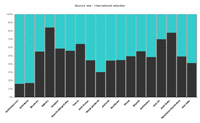 A couple of days ago, Alexa [1] published the information regarding 6 of the evaluation criteria that form their statistics on websites, against the two that were available until now. A couple of days ago, Alexa [1] published the information regarding 6 of the evaluation criteria that form their statistics on websites, against the two that were available until now.
If we were to take into exam and confront the information regarding Architectour.net with that of the other most known and distinguished architectural websites in the world, one could notice that Architectour.net has the highest assessment in three (out of six) of these bench marks (Pageviews/user, Bounce rate and Time on site), and is in second place in another indicator (Pageviews).
We are particularly pleased to have the best "bounce rate" [2] (16,1%), since this statement, supported by an average time on site of almost an hour and an average of 45 pageviews per user, rappresents an aknowledgement of the quality and quantity of the contents available to our Users and of how easy it is to navigate on Architectour.net, thanks to a graphic presence accurately designed to support our Users.
This data is visible to anyone who wishes to visit Alexa.com and confront our percentages to those of other websites.
1. Alexa is an association of the Amazon group that monitors all exisitng web sites and supplies statistics and information, equally formulated for all web sites, on the quantity of traffic of each web site and their visibility on the web.
2. The bounce rate is an indicator of users who "bounce" on the site, that is those who exit within 30 second from access or after having visited one page.
Google.com analytics specialist Avinash Kaushik has stated: "It is really hard to get a bounce rate under 20%, anything over 35% is cause for concern, 50% (above) is worrying." |
 |
 |
  |
 Earthquake in the Abruzzo Region Earthquake in the Abruzzo Region |
 |
April 6, 2009
Last night a major earthquake (5,8 on the Richter scale) with epicentre in L'Aquila shook a wide area of the Abruzzo region (Italy) bringing death and distruction.
It is not our competence to provide information on what ocurred. However, we do feel it is our duty to give a small contribution to increase awareness and offer support to the population stricken by the disaster.
The dismay for the damage that one of Italy's most precious historical and architectural heritage has suffered is trivial compared with the pain for the victims and their families.
We will therefore be announcing the initiatives taken to bring help and assistance to those who have been stricken by this catastrophe.
» Civil protection
» Abruzzo Region
SOLIDARITY FUND DONATION
Those who wish to make a contribution through donation may do so also across this channel, indicating as reason for payment "TERREMOTO ABRUZZO"
CARITAS ITALIANA
conto corrente postale n. 347013
Unicredit Banca di Roma, IBAN IT38 K03002 05206 000401120727 (BIC: BROMITR1707)
www.caritasitaliana.it
ABRUZZO REGION
conto corrente postale n. 10400000
Unicredit Banca di Roma, IBAN IT69 L03002 15300 000410000000
ABRUZZO IN THE HEART
www.abruzzonelcuore.org |
 |
 |
  |
 Wolf D. Prix in Perugia: Camminare Nella Storia - Beyond The Blue Wolf D. Prix in Perugia: Camminare Nella Storia - Beyond The Blue |
 |
March 19, 2009
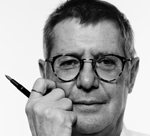 The eastern slope of Perugia's acropolis has always rappresented a nevralgic and unsolved urban junction, even though it has endured profound morfological alterations throughout the centuries. The construction of the minimetrò station so closeby, together with the Mercato Coperto's (Covered Market's) restored functionality, open new prospectives that foreshow the possibility of increasing the network of pedestrian pathways that connect the city's arcopolis by emptying the thirteenth-century terracing. And, therfore, by rediscovering, physically and culturally, the ancient etruscan urban wall. The eastern slope of Perugia's acropolis has always rappresented a nevralgic and unsolved urban junction, even though it has endured profound morfological alterations throughout the centuries. The construction of the minimetrò station so closeby, together with the Mercato Coperto's (Covered Market's) restored functionality, open new prospectives that foreshow the possibility of increasing the network of pedestrian pathways that connect the city's arcopolis by emptying the thirteenth-century terracing. And, therfore, by rediscovering, physically and culturally, the ancient etruscan urban wall.
The research project "Walking in time. The valorisation of Perugia's acropolis through a system of innovative spaces and pedestrian connections", whose intention is to enrich Perugia with new public spaces of extraordinary historical and artistical qualities, is articulated into two different parts, a cognitive study and a concept study: the first study adresses the archeological secrets of a misterious and unexplored underworld; the point of the second study is to foresee the values of the pedestrian connection among the Piazza della Rupe area (elected panoramic hinge between the minimetrò station and the Mercato Coperto), the hypogean spaces of the Sopramuro, Via Mazzini (protected from the inclemencies of the weather by a glass gallery) and Corso Vannucci.
The cognitive study and the design for the arrangement of the hypogean spaces of the Sopramuro were led by the Department of Civil and Environmental Engineering of the University of Perugia; whereas the design of the glass gallery on the old Via Nuova (currently Via Mazzini) was commissioned to the archistar of international fame Wolf D. Prix of Coop Himmelb(l)au, that will be delivering a Distinguished Lecture for the occasion titled Beyond the Blue.
Lecture of Wolf D. Prix on the theme "Camminare Nella Storia - Beyond The Blue"
Main Hall of the University, Perugia, Italy
March 20, 2009, time 4:15 p.m. |
 |
 |
  |
 Foster + Partners in La Défense Foster + Partners in La Défense |
 |
March 12, 2009
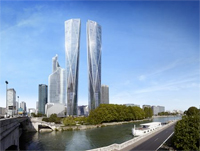 Hermitage Plaza will create a new community to the east of La Défense, in Courbevoie, that extends down to the river Seine with cafés, shops and a sunny public plaza at its heart. Revealed by Foster + Partners at MIPIM in Cannes, the project incorporates two 323-metre-high buildings which will establish a distinctive symbol for this new urban destination on the Paris skyline. Hermitage Plaza will create a new community to the east of La Défense, in Courbevoie, that extends down to the river Seine with cafés, shops and a sunny public plaza at its heart. Revealed by Foster + Partners at MIPIM in Cannes, the project incorporates two 323-metre-high buildings which will establish a distinctive symbol for this new urban destination on the Paris skyline.
The result of a close collaboration with EPAD, the City of Courbevoie, Atelier de Paysage Urbain and Département de Hauts-de-Seine, the project is intended to inject life into the area east of La Défense by creating a sustainable, high-density community. Due to start on site in 2010 and complete by the end of 2014, the two towers accommodate a hotel, spa, panoramic apartments, offices and serviced apartments, as well as shops at the base.
Forming two interlocking triangles on plan, the buildings face one another at ground level. Open and permeable to encourage people to walk through the site, the towers enclose a public piazza which establishes the social focus.
Norman Foster said: “Hermitage Plaza will create a 24-hour community that will regenerate the riverfront and inject new life into a predominantly commercial part of the city. A light catching addition to the Paris skyline, the development will also provide a public piazza that leads down to the river’s edge to create a new destination for the city.” |
 |
 |
  |
 Moscow Needs Help. A Global Heritage at Risk Moscow Needs Help. A Global Heritage at Risk |
 |
March 4, 2009
 The IBPP Russia Moskonstruct Project has been developed with the objective of promoting Moscow’s heritage of Constructivist Architecture. Through awareness raising, the heightening of international awareness, the involvement of local citizens and governing bodies, the project aims to highlight the critical conditions faced by this world heritage. Moskonstruct aims to promote actions of conservation, protection and safeguarding of these works of global interest, whose existence is placed at risk by building speculation and the rapid development of the free market. The IBPP Russia Moskonstruct Project has been developed with the objective of promoting Moscow’s heritage of Constructivist Architecture. Through awareness raising, the heightening of international awareness, the involvement of local citizens and governing bodies, the project aims to highlight the critical conditions faced by this world heritage. Moskonstruct aims to promote actions of conservation, protection and safeguarding of these works of global interest, whose existence is placed at risk by building speculation and the rapid development of the free market.
We are asking for your support in implementing a process of awareness raising regarding the risks of losing a cultural inheritance of such significance, above all in light of the importance of Russian Constructivism in the development of Modern Architecture.
It is our firm conviction that this heritage must be preserved for future generations and that only with the support of the international community can we focus the necessary attention on this issue. We are asking that the Moscow City Government begin to consider the idea of developing a Plan for the conservation and protection of the work of the Constructivist architects and the 20th century Russian avant-garde.
We are asking you to visit our website www.moskonstruct.org and assist us by signing the petition to be forwarded to the Mayor of Moscow, asking the city to recognise these works of architecture as monuments to be preserved for future generations.
Thank you for your support
Days of study in depth about Russian Constructivism
Conference presentation of Moskonstruct Project and of the exhibition "Roma-Mosca 1920-1939"
Monday, March 9, 2009 h. 10:00 AM, Rome, Aula Magna Fontanella Borghese
» For details and information |
 |
 |
  |
 Ben van Berkel/UNStudio: MUMUTH, Graz Ben van Berkel/UNStudio: MUMUTH, Graz |
 |
February 27, 2009
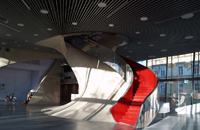 The MUMUTH - Haus für Musik und Musiktheater, a faculty building for the University of Music and Performing Arts Graz (KUG), has been ten years in the making, including two years of construction and will be officially opened on March 1st 2009. To celebrate this special event the Institute for Music Drama will present a performance of W.A. Mozart’s opera “The Magic Flute”, just before a “Celebration for Otto Kolleritsch”, Rector emeritus of KUG and a longstanding supporter of MUMUTH, will take place. The MUMUTH - Haus für Musik und Musiktheater, a faculty building for the University of Music and Performing Arts Graz (KUG), has been ten years in the making, including two years of construction and will be officially opened on March 1st 2009. To celebrate this special event the Institute for Music Drama will present a performance of W.A. Mozart’s opera “The Magic Flute”, just before a “Celebration for Otto Kolleritsch”, Rector emeritus of KUG and a longstanding supporter of MUMUTH, will take place.
The new Music Theatre, designed by Ben van Berkel of the renowned Dutch architecture firm UNStudio following an international competition with 212 entries, has already formed the Austrian contribution to the Venice Biennale of Architecture.
Of the design of MUMUTH Architect Ben van Berkel says: “The desire to make a building that is as much about music as a building can be, has been a constant throughout the nearly ten years that it took to build the theatre and the themes that are at the basis of the building and its overall organization have also endured throughout this time.”
Construction of the 19 million euro new Music Theatre began in March 2006 and in August 2008 the Federal Real Estate Society (BIG) entrusted the main part of the building to the KUG. In February 2009 the MUMUTH also hosted part of the 7th International Competition “Franz Schubert and Modern Music”. |
 |
 |
  |
 Coop Himmelb(l)au High School #9, Los Angeles Coop Himmelb(l)au High School #9, Los Angeles |
 |
February 12, 2009
 The Central Los Angeles Area High School #9 for the visual and performing arts by Coop Himmelb(l)au has just been completed. The school will open for the new school year in September 2009. The Central Los Angeles Area High School #9 for the visual and performing arts by Coop Himmelb(l)au has just been completed. The school will open for the new school year in September 2009.
After Richard Neutra and Rudolf Schindler, Wolf D. Prix/Coop Himmelb(l)au is the first Austrian architect to build in Los Angeles.
The Central Los Angeles Area High School #9 for the Visual and Performing Arts of the Los Angeles Unified School District (LAUSD) is part of phase II of LAUSD’s rigorous state bond funded plan to have 155 new schools built in its district by 2012. Located on a 9.8 acre site on Grand Avenue in Downtown Los Angeles, the school will be a comprehensive High School and in addition will offer courses in the Visual Arts, Performing Arts, Music and Dance.
Due to its central location the High School #9 will be a part of the cultural facilities along the Grand Avenue cultural corridor, joining the Walt Disney Concert Hall by Frank O. Gehry, Music Center by Welton Becket, Colburn School of Music by Hardy Holzman Pfeiffer, Museum of Contemporary Art/MOCA by Arata Isozaki and the Cathedral of our Lady of the Angels by Rafael Moneo. |
 |
 |
  |
 Ben van Berkel, New Amsterdam Plein & Pavilion in New York City Ben van Berkel, New Amsterdam Plein & Pavilion in New York City |
 |
January 30, 2009
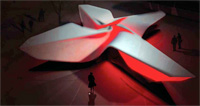 At a press conference with Dutch officials held to announce plans for the joint Dutch- American 2009 celebration of the 400th anniversary of Henry Hudson’s arrival in New York Harbor, New York City Mayor Michael R. Bloomberg confirmed that Peter Minuit Plaza at The Battery will become the site of a major new public destination: New Amsterdam Plein & Pavilion will be a dramatic space where more than 5 million people a year, including 70,000 daily commuters and 2 million annual tourists, can find an extraordinary “outdoor living room” for spontaneous and scheduled activities, public markets, seating and shade, and an iconic state-of-the-art pavilion for food and information, all designed by internationally celebrated Dutch architect Ben van Berkel of UNStudio, Amsterdam. At a press conference with Dutch officials held to announce plans for the joint Dutch- American 2009 celebration of the 400th anniversary of Henry Hudson’s arrival in New York Harbor, New York City Mayor Michael R. Bloomberg confirmed that Peter Minuit Plaza at The Battery will become the site of a major new public destination: New Amsterdam Plein & Pavilion will be a dramatic space where more than 5 million people a year, including 70,000 daily commuters and 2 million annual tourists, can find an extraordinary “outdoor living room” for spontaneous and scheduled activities, public markets, seating and shade, and an iconic state-of-the-art pavilion for food and information, all designed by internationally celebrated Dutch architect Ben van Berkel of UNStudio, Amsterdam.
The Plein & Pavilion will be unique among the city’s many public spaces – a landscaped intermodal transportation hub of the 21st century, where bicycles, buses, the subway and water transportation intersect with cultural offerings in a singular expression of daring but lyrical design. |
 |
 |
  |
 Two awards for Coop Himmelb(l)au's BMW Welt Two awards for Coop Himmelb(l)au's BMW Welt |
 |
January 29, 2009
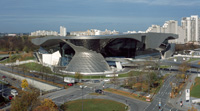 BMW Welt receives the Wallpaper Design Award as "Best new public building" and Detail prize 2009 "Innovation Steel". Out of five nominees the judges of the Wallpaper Design Award selected the BMW Welt in Munich, Germany as "Best new public building". BMW Welt receives the Wallpaper Design Award as "Best new public building" and Detail prize 2009 "Innovation Steel". Out of five nominees the judges of the Wallpaper Design Award selected the BMW Welt in Munich, Germany as "Best new public building".
Wallpaper states: "The new and dynamic Coop Himmelb(l)au creation for BMW in Munich is not only a cutting-edge car delivery centre, but a place for display, communication and, also, the public. The dynamic, semi-transparent glass and steel structure has a wavy roof, ending in a twisting twin-cone form, and an open interior with monumental stairways, bridges and balconies."
Out of 318 entries from 28 nations the judges of Detail Prize selected the BMW Welt in Munich, Germany as winner of the category "Innovation Steel".
The jury of Detail Prize states: "BMW Welt is an impressively complex steel building whose expressive shape enables innovative spatial sequences and scenarios. Planning and construction of the building required massive computer support. The multilayered three-dimensional framework with very few support points could undoubtedly only have been constructed using steel. The off-centre rotation of the cylinder similarly required the use of steel. The facade, which has both a supporting and reinforcing function, is surprisingly filigree in its design. The symbolic building is a significant addition to its environment and acts as a landmark between the BMW Museum and the Olympic Park."
Wolf D. Prix, Design Principal of Coop Himmelb(l)au said: "I am delighted to receive these awards for our project.
The BMW Welt is a major statement about architecture. It is an identifiable building in the city, which is an important issue in architecture nowadays. So therefore I think the BMW Welt is an answer to the question how public space could be today." |
 |
 |
  |
 A new Architectural Magazine: eVolo A new Architectural Magazine: eVolo |
 |
January 28, 2009
 The launch of eVolo Magazine, a bi-annual architecture and design journal focused on technology advances, sustainability, and innovative design for the 21st century, has been announced in New York. The launch of eVolo Magazine, a bi-annual architecture and design journal focused on technology advances, sustainability, and innovative design for the 21st century, has been announced in New York.
The Magazine's objective is to promote and discuss the most innovative ideas generated in Schools and professional studios around the world. It is a medium to explore the reality and future of architectural design with up-to-date news, events, and projects.
The first item (may/june 2009) will title "Housing for the 21st century".
» For details and information |
 |
 |
  |
 West 8 and BAS-Dirk Jaspaert: pedestrian bicycle bridge Aarschot West 8 and BAS-Dirk Jaspaert: pedestrian bicycle bridge Aarschot |
 |
January 26, 2009
 The winning design of West 8 and BAS-Dirk Jaspaert for the new pedestrian bicycle bridge, that will span the rail tracks in Aarschot (Belgium), focuses on the functional character of the bridge as well as on its potential to tempt and surprise its users. The winning design of West 8 and BAS-Dirk Jaspaert for the new pedestrian bicycle bridge, that will span the rail tracks in Aarschot (Belgium), focuses on the functional character of the bridge as well as on its potential to tempt and surprise its users.
The bridge will connect the different old and new parts of the city, the landscape and the centre with each other and becomes a crucial link within the regional bicycle path network. It also creates new access points to the platforms.
By virtue of its location, form, structure and the use of material, the bridge captures the qualities of the surrounding landscape. It offers cyclists and pedestrians a new rest and meeting place above the busy rail tracks, but at the same time it gives them a sense of security.
The steel space grid is supported by sculptural pillars and its curved shape offers a variety of constantly changing perspectives and experiences.
» For details and information |
 |
 |
  |
 Foster and Aston Martin, together for the new Routemaster Foster and Aston Martin, together for the new Routemaster |
 |
December 23, 2008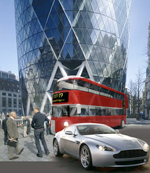 One of the best-known symbols of modern London, the famous double-decker red bus Routemaster evolves and projects itself into the future. The competition for the design of the new bus, announced by the Greater London Authority, has been won by a team made up of two other icons of the British world: Foster + Partners architecture and design firm and Aston Martin automobile manufacturer, the mythical auto of Agent 007. The collaboration between Foster and Aston Martin has produced a vehicle which, though conceived for the streets of London, is proposed as a new standard for urban public service, and intends to offer the comfort of an auto and the liveability of a building, with wooden floors and leather seats. It indeed devotes utmost attention to safety, in particular to driver total visibility, and the complete control of the vehicle via monitor and radio connection with headquarters. The bus will be particularly environmentally sensitive: zero emissions ready, equipped with solar cell panels on the glass roof to produce energy and, naturally, completely accessible by the mobility impaired. The bus design also re-introduces the rear open access platform whose suppression in the latest models had aroused much disapproval among people. We’ll see it in service as of 2011. Lord Foster said: “This project has really captured my imagination. London’s buses are so much a part of the essence of this city – functionally, symbolically and geographically. They help us draw a mental map – their destinations are London’s historic places, often green: Shepherds Bush, Islington Green, Hampstead Heath, Green Park. Our design seeks to combine contemporary innovation with timelessness. Like the original Routemaster – which was ahead of its time and consequently endured – a new bus for London should establish a whole new travel experience that espouses 21st century aspirations, while celebrating the memory and the experience of the original.” |
 |
 |
  |
 Holland: 5 euros of Contemporary Architecture Holland: 5 euros of Contemporary Architecture |
 |
December 18, 2008 The commemorative 5 euro coin that Holland has minted as a tribute to its own architecture, is already in circulation. The “Holland and Architecture” competition, announced by the Ministry of Finance was won by Belgian architect and artist Stani Michiels. Michiels has conceived a coin which on the front portrays the face of Queen Beatrix. Her royal countenance is drawn with the names of the principal Dutch architects written concentrically, playing with the depth of the fonts. The order of appearance was determined by the number of citations of the illustrious architects on Internet sites. Starting from the outermost circle, we can therefore read the names of Rem Koolhaas, Pierre Cuypers, Aldo van Eyck, Gerrit Rietveld, Ben van Berkel, Hendrik Petrus Berlage, Winy Maas, Erik van Egeraat, Wiel Arets.... The back of the coin depicts the ribs of the books that many of the architects on the front have written in the course of their activity. The volumes are depicted as buildings projected towards the sky and, at the centre of the coin, the resulting skyline draws the profile of the state of Holland. The birds in flight in this suggestive sky correspond to the major cities of the Dutch provinces. Also a programmer in Python language, Stani Michiels did all of the graphics which led to the coin’s realisation, utilising free software. A splendid specimen of graphics and an exemplary sign of the attention shown by a government for contemporary architecture where, and it is no coincidence, Holland has won a place of pre-eminence. |
 |
 |
  |
 Italian High-Speed enters operation Italian High-Speed enters operation |
 |
December 12, 2008 The Milan- Bologna tract of the Italian High-Speed Railway Network will be inaugurated tomorrow, thus enabling a great leap forward towards the completion of this powerful infrastructure. Once up and running full blast, it will become a sort of “high-speed underground” that, in very short time, will connect the major Italian cities ( Milan- Bologna in just over an hour, Milan- Naples in 4 hours and 10 minutes) and the major European capitals. The interest of the world of architect lies principally in the consequent realisation of the new train stations, including the reconstruction of already existing stations. The design of these new poles of urban requalification – this is what the New Stations for High-Speed will become – have indeed been entrusted to some of the great names of world architecture: AREP in Turin, Santiago Calatrava in Reggio Emilia, Arata Isozaki in Bologna, Norman Foster in Florence, ABDR in Rome, and Zaha Hadid in Naples. Bon voyage! |
 |
 |
  |
 AIA Gold Medal for Glenn Murcutt AIA Gold Medal for Glenn Murcutt |
 |
December 10, 2008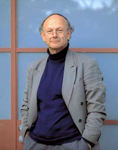 The 2009 AIA (American Institute of Architects) Gold Medal has been awarded to Australian architect Glenn Murcutt for the depth of his work and the great influence his works have had worldwide. Born in London in 1926 (but 100% Australian), he has conducted his activity exclusively in Australia, and against the trend of gigantism of a lot of contemporary architecture. His principal works are indeed one-family houses, often built in isolated areas, characterised by a rigorous respect for the environment, and wonderfully integrated with the morphology and climate of the areas where they are sited. He draws inspiration from the vernacular forms of his country, from the rigorous geometries of Mies van der Rohe, and from Alvar Aalto’s naturalistic Modernist revisions. Already the recipient of the Pritzker Prize in 2002, Glen Murcutt will receive this award in the course of a ceremony which will be held in Washington D.C. in February. |
 |
 |
  |
 Farewell to Jorn Utzon, creator of the Sydney Opera House Farewell to Jorn Utzon, creator of the Sydney Opera House |
 |
November 30, 2008
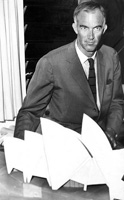 One of the greatest contemporary architects, Jørn Utzon died yesterday morning, at the age of 90, due to a heart attack in his sleep, at his home in Copenhagen. One of the greatest contemporary architects, Jørn Utzon died yesterday morning, at the age of 90, due to a heart attack in his sleep, at his home in Copenhagen.
Son of a naval engineer, the Danish architect received his degree from the Royal Academy of Fine Arts in Copenhagen. He began his career doing pupillage in the firms of Gunnar Asplund and Alvar Aalto; he also earned experience at Taliesin West with Frank Lloyd Wright. Once he had opened his own firm, he made world news at the age of 38 for his surprise win of the competition for the realisation of the Sydney Opera House, the building that would become one of the icons of twentieth-century architecture and the symbol of Australia. Utzon had read the announcement of the competition in a Swedish architecture magazine, and the jury headed by Eero Saarinen defined his project as “ingenious”, selecting it from among the 232 participating projects.
Utzon moved to Sydney to follow the realisation of the work, but profound disagreements arose with the client during construction, and led him to abandon the construction site in 1966. He did not return to Australia and never saw the Sydney Opera House completed.
In 2003, he was awarded the Pritzker Prize, the world’s highest honour in the field of architecture. |
 |
 |
  |
 Daniel Libeskind: Westside in Berne Daniel Libeskind: Westside in Berne |
 |
October 7, 2008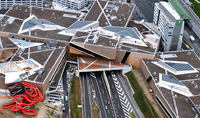 The new Westside complex designed by Daniel Libeskind will be inaugurated tomorrow in Berne. This is the largest private investment ever made in Switzerland, and is expected to welcome 3,500,000 visitors a year, and to become a point of reference and attraction for the entire region. Built covering part of the A1/E25 motorway, the building complex is proposed as a new gate of entry for those approaching the city from the west; its construction required two and a half years to complete and, in peak periods, employed up to 2,000 people a day. The project is conceived as an integration between architecture and landscape, which reflects the soul of the Berne districts; the facades that look onto the countryside, on its western side, are faced with wood to create a point of encounter between the city and nature. The complex’s backbone is a shopping centre, characterised by a “medieval-like” spatial complexity which fully adapts, however, to the demands of contemporary living. It includes 55 shops and 10 restaurant-bars. It is completed by a 114-room hotel, a residential complex for the elderly, composed of 95 apartments, a cineplex with 11 movie theatres, and a swimming-pool with wellness centre. |
 |
 |
  |
 Sonning Prize for Renzo Piano Sonning Prize for Renzo Piano |
 |
October 2, 2008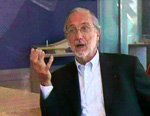 Renzo Piano Renzo Piano has been awarded the Sonning Prize, one of the most prestigious cultural acknowledgements of Denmark. Instituted by author and publisher C.J. Sonning, the prize is awarded by the University of Copenhagen to a person who has contributed, with his work, to promoting European culture. The prize was awarded for the first time in 1950 to Sir Winston Churchill, and since then has been assigned 30 times more to various personalities in different areas of the world of culture. Awardees include philosophers Bertrand Russell and Karl Popper, actors Sir Laurence Olivier and Dario Fo, directors Ingmar Bergman and Krzysztof Kieslowski, writer Simone de Beauvoir. To date, only two other architects have been awarded this prestigious acknowledgement: Alvar Aalto in 1962 and Jørn Utzon in 1998. The Sonning Prize, which amounts to 1,000,000 Danish crowns (approximately 134,000 euros), was presented to Renzo Piano in the Ceremony Hall of the University of Copenhagen. |
 |
 |
  |
 A “Football City” for Florence A “Football City” for Florence |
 |
Septmber 23, 2008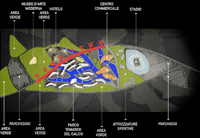 Diego Diego and Andrea Della Valle have presented the project for the construction of a multipurpose area that will become a veritable “ football city”. The project’s catalysing element is the new stadium for the Fiorentina Football Club, designed by Massimiliano Fuksas and destined to replace the glorious “ Artemio Franchi” stadium, designed by Pier Luigi Nervi and restored by Italo Gamberini and Loris G. Macci for the 1990 World Cup. The stadium will be characterised by transparent roofing, which will envelop it like a cloud. There are other novelties, too, though. The new installation will indeed host a theme park on football where, thanks to the latest-generation technologies, football lovers will find themselves in a sort of “wonderland”. There will also be a “ downtown”, where the city’s tradesmen will be able to “replicate” their activities, a museum of modern art, hotels, shopping centre, and sports facilities. And all this immersed in greenery and traversed by waterways, in the wake of what has always been the goal of the Della Valle family: to bring families back to stadiums, eliminating the fringe of violent supporters. The entirely private project is promoted by the “ Fondazione Viola”, which from the management of the complex will draw the profits to take the Fiorentina to the top level, thus inaugurating a new management model for sports clubs. The site of the installation will be at Castello, to the north of Florence: the entire park will have an extension of some 80 hectares, and the stadium will have a capacity of some 40-50,000 spectators. A great opportunity for Florence of the future, promoted by a company that as already displayed a marked sensitivity towards quality architecture, entrusting the design of the Tod’s headquarters of Tokyo to Toyo Ito.
» For details and information |
 |
 |
  |
 Speak your mind on architectural quality Speak your mind on architectural quality |
 |
September 22, 2008 The Minister for Cultural Properties and Activities, Sandro Bondi, is drafting a bill on the quality of architecture and town-planning of urban areas and the territory. Its main objectives are to stimulate the use of architecture competitions for designing new public works, not limiting participation to architect-stars, and instead opening up to young professionals by means of greater transparency in assigning projects and, especially, privileging the evaluation of project merit. The final goal is to bring the Italian quality standards in line with those of Europe. The good news doesn’t stop here, though: at its web site, the MiBAC ( Ministry for Cultural Properties and Activities) solicits observations and suggestions to improve the bill from those parties that deal with these issues every day. » For details and information |
 |
 |
  |
 Venice, 11th International Architecture Exhibition Venice, 11th International Architecture Exhibition |
 |
May 5, 2008 The 11th International Architecture Exhibition entitled Out There: Architecture Beyond Building, directed by Aaron Betsky and organised by La Biennale di Venezia presided over by Paolo Baratta, will take place in Venice from Sunday, September 14th to Sunday, November 23rd 2008. According to Aaron Betsky –for six years director of the Netherlands Architecture Institute (NAI) in Rotterdam, one of the most prestigious museums and architecture centres in the world, and from last year Director of the Cincinnati Art Museum– the 11th Architecture Biennale, entitled Out There: Architecture Beyond Building, “will point the way towards an architecture liberated from buildings to engage the central issues of our society; instead of the tombs of architecture, which is to say buildings, it will present site specific installations, visions and experiments that help us figure out, make sense of and feel at home in our modern world.” The beginning of the Corderie of Arsenale will present Hall of Fragments, by David Rockwell with Casey Jones + Reed Kroloff. An architecture before building in the form selections of science fiction films that once showed us what our world would look like, as well as historical films that recreated older worlds, will be projected on screens. The Corderie will present large-scale site specific Installations, that will ask the question how we can be at home in the modern world. These Installations will be accompanied by Manifestos for an architecture beyond building. These Manifestos will both be spoken on large video screens and printed. Participants will include: Diller Scofidio+Renfro, UN Studio, Massimiliano Fuksas, Nigel Coates, Droog Design, Philippe Rahm, M-A-D, Coop Himmelb(l)au, Vicente Guallart, Zaha Hadid, An Te Liu, Greg Lynn, MVRDV, Penezič and Rogina, Asymptote, Atelier Bow Wow, Barkow Leibinger Architects, Frank O. Gehry, Matthew Ritchie in collaboration with Aranda/Lasch and Daniel Bosia/ARUP AGU, Kramervanderveer, and Thonik. Continuing this theme, a modern-day yurt from Kazakhstan by Totan Kuzembaev and a “paradise garden” by Kathryn Gustafson will continue this line of installations through the remainder of the Arsenale.
While the Arsenale will map out the fragments and figments before and after architecture, in the Padiglione Italia at Giardini, the work of experimental architecture that in themselves move beyond building will be on display. A survey of experimental architecture Experimental Architecture in collaboration with Emiliano Gandolfi will show the work firms from around the world who are engaged in such work. This survey will be anchored by small monographic shows on firms whose work has been based on such experimentation: Frank Gehry, Herzog & de Meuron, Morphosis, Madelon Vriesendorp, Zaha Hadid, and Coop Himmelb(l)au.
» For details and information |
 |
 |
  |
 Olympic Games in Beijing Olympic Games in Beijing |
 |
August 7, 2008
 The XXIX Olympic Games will be inaugurated tomorrow in Beijing. For the first time hosted in China and, as has occurred for various previous editions, the event has also occasioned the construction of works of architecture of international importance. The XXIX Olympic Games will be inaugurated tomorrow in Beijing. For the first time hosted in China and, as has occurred for various previous editions, the event has also occasioned the construction of works of architecture of international importance.
The two main sports facilities are the National Stadium and the National Swimming Centre. Sited close to one another, they both present a strong recognizability deriving from their formal characterisation.
The National Stadium, already renamed “Bird’s Nest” for its reticular structure, was designed by the Herzog & de Meuron studio of Basel and will host the track and field events. The National Swimming Centre, called the “Watercube” for its casing that recalls water bubbles, was designed by the Australian PTW Architects studio and will obviously host the swimming and diving competitions.
In addition to the sports facilities, major town planning projects have also been realised, along with other notable buildings, including the Terminal 3 of the International Airport by Foster + Partners, the Central Headquarters of the Chinese Television by Rem Koolhaas – OMA, and the Opera-house by Paul Andreu. |
 |
 |
  |
 Utzon: Poetics of Construction Utzon: Poetics of Construction |
 |
August 6, 2008 To mark Jørn Utzon’s 90th year the newly opened Utzon Center, in collaboration with Aalborg University will be holding the Second International Utzon Symposium on the theme “Poetics of Construction”, to be held at the newly constructed Utzon Center and Alvar Aalto’s Nordjyllands Kunstmuseum in Aalborg. This symposium will present and discuss current developments within contemporary architecture, as a continuation of the inspiration and principles previously developed in the work of Jørn Utzon. The Second International Utzon Symposium will bring together internationally renowned architects, Rafael Moneo, Gerard Reinmuth (terroir), Matti Sanaksenaho, Enrique Sobejano, Lene Tranberg, Richard Weston and Alejandro Zaera-Polo ( Foreign Office Architects). The symposium will take place on the 4th September 2008 and will be held at Nordjyllands Kunstmuseum (Museum of Art, Northern Jutland) and the Utzon Center, Aalborg. » For details and information |
 |
 |
  |
 Liesbeth van der Pol Chief Dutch Government Architect Liesbeth van der Pol Chief Dutch Government Architect |
 |
August 4, 2008 Liesbeth van der Pol Liesbeth van der Pol will take up the post of Chief Government Architect (Rijksbouwmeester) on 15 August 2008. She will succeed Mels Crouwel who is resigning after nearly four years. Her appointment is for a period of three years. She will fulfil her appointment part time and will remain associated with Dok Architekten in Amsterdam. As Chief Government Architect, Liesbeth van der Pol is the primary advisor to the director-general of the Government Buildings Agency (Rijksgebouwendienst - RGD) and the minister of Housing, Districts and Integration (WWI) for the policy on Government Accommodation. The Chief Government Architect promotes and watches over the architectural quality and urban positioning of government buildings, such as courthouses, prisons, government museums and ministry buildings. The Chief Government Architect is also the Chair of the Board of Government Advisors, which advises the government on issues related to architecture, landscape architecture, infrastructure and cultural heritage. |
 |
 |
  |
 New waterfront designs for Rimini unveiled New waterfront designs for Rimini unveiled |
 |
July 3, 2008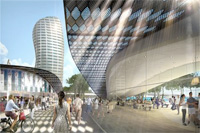 Foster + Partners Foster + Partners presented designs for a new waterfront development in Rimini. Revealed at a public presentation to the City last week, the proposal is designed to strengthen the relationship between the town centre and the seafront and to create a year-round attraction for an international tourist industry. The scheme comprises a new seafront promenade with a mix of related activities and public spaces including a hotel tower, which will extend Rimini’s historic beach culture and continue the existing urban grain. The project celebrates Rimini’s tradition of green boulevards, best characterised by the Via Vespucci. The waterfront will be pedestrianised at certain times and will link directly to a linear public park – or green spine – which will provide much needed shade during the hotter months. This currently links the seafront to the historic city and will be enhanced with improved connections to the new promenade area. A new hotel tower includes space for a Fellini film museum at its base. Its curving form anchors the wider project, while the building extends out to sea along a new 300m long pier, continuing the dialogue between the city and the water and referring to Rimini’s tradition of piers. The scheme will use new technologies, such as rainwater collection and photovoltaics, to establish a long-term, sustainable commercial and environmental strategy for the town that is balanced with its rejuvenation in the short-term. |
 |
 |
  |
 Ferrari Formula Uomo Ferrari Formula Uomo |
 |
June 28, 2008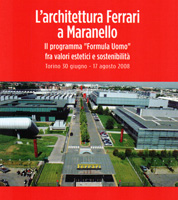 During the UIA World Congress of Architecture, Turin 2008, parallel events and initiatives will be held, the Off Congress Official Events: this will prolong the impact of the congress on the culture of architecture in Turin. The exhibition " Ferrari architecture in Maranello - The "Formula Uomo" program between aesthetic values and sustainability” will be held at the Automobile Museum in Turin and it's part of the Architecture Flows way, as a stop along the river Po, linking the Lingotto, seat of the Congress, to the city centre. Through photos, sketches, samples and projects, the exhibition, organized by Architect Marco Visconti, recounts how the agency of important architects, such as Renzo Piano, Jean Nouvel, Massimiliano Fuksas, Luigi Sturchio, and Marco Visconti, realized the will of a purchaser like Ferrari, focused on human, cultural and environmental values. The buildings reflect the most salient Ferrari features: extraordinary dynamism, high technological content and the peerless allure of the Maranello "Reds". Torino Esposizioni, Padiglione Giovanni Agnelli
Corso Massimo D’Azeglio, 15 - Torino
30 June - 17 August 2008 |
 |
 |
  |
 Frank Gehry Golden Lion for Lifetime Achievement Frank Gehry Golden Lion for Lifetime Achievement |
 |
June 27, 2008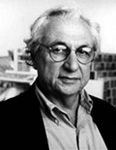 The Board of the Foundation La Biennale di Venezia, chaired by Paolo Baratta, gathered today in the offices of Palazzo Querini Dubois, and on the proposal of the Director, Aaron Betsky, attributed the Golden Lion for Lifetime Achievement for the 11th International Architecture Exhibition to Frank Gehry. With this award, the desire is to stress –in line with the spirit of the 11th Architecture Biennale– how much Gehry’s work is the significant result of years of experimentation. “ Frank Gehry has transformed modern architecture”; writes Aaron Betsky in his motivation. “He has liberated it from the confines of the ‘box’ and the constraints of common building practices. As experimental as the art practices that have been his inspiration, Frank Gehry’s architecture is the very modern model for an architecture beyond building”. The Board has also underlined the important presence Gehry will have in Venice with his Venice Gateway, the water gate linking the city to the airport. |
 |
 |
  |
 XXIII World Congress of Architecture XXIII World Congress of Architecture |
 |
June 27, 2008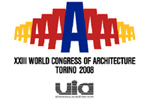 After hosting the Olympic Games, Turin is about to play a central role at international level once again. Indeed, following a period dedicated to physical competition, it’s now time for an intellectual, scientific and cultural event. Between June 29th and July 3rd 2008 the XXIII edition of the World Congress of Architecture, promoted by the UIA ( International Union of Architects), will be taking place here. The event, which dates back to 1948 and represents both the state of the art and the debate on the future of world Architecture in the 21st century, within an increasingly complex and global society, will be taking place in Italian city for the first time. Indeed, following Barcelona, Beijing, Berlin and Istanbul, Turin, a city that is constantly undergoing change and transformation, will be hosting the world event that every three years brings together thousands of architects and students to discuss subjects concerning architecture’s perspectives in relation to great social and cultural issues of the moment. The topic chosen for the 2008 congress is particularly ambitious and stimulating: Transmitting Architecture, in other words the strength and ability architecture has of expressing and communicating values, feelings and diverse cultures through time. It’s a title enclosing two meanings: architecture communicates its social and design action, but at the same time, gathers the positive energy and emerging phenomena expressed by society. It’s important for the values transmitted to be given recognition, not just appreciation for what it produces. The event takes place at the Congress Centre Lingotto in Turin and at the Palavela. |
 |
 |
  |
 The public lend a hand at the launch of the London Festival of Architecture The public lend a hand at the launch of the London Festival of Architecture |
 |
June 23, 2008 Foster + Partners Foster + Partners successfully built a conical structure, interwoven with fabric panels hand-printed by the public to kick off the Kensington and Chelsea hub of the London Festival of Architecture on 21 June. A focal point of the Exhibition Road Festival, the tensile structure was hauled into place with a tug-of-war rope by the public at 2pm. More than 4,000 visitors walked through the ten metre-high structure in the afternoon and enjoyed its sound installation by Bill Fontana. Overall turnout on the day was high – more than 30,000 visitors were reported at the event. |
 |
 |
  |
 London Festival of Architecture 2008 London Festival of Architecture 2008 |
 |
June 19, 2008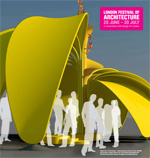 Tomorrow is the inauguration of The London Festival of Architecture 2008, a celebration and exploration of the city's buildings, streets and spaces. The Festival runs from 20 June – 20 July and includes street installations, exhibitions, guided walks, cycle rides, boat tours of the city's river and canals, parties, design workshops, debates, breakfast talks, and weekend street markets. Headline events include lectures by leading international architects David Chipperfield, Daniel Libeskind, Cesar Pelli and Rem Koolhaas and by LFA President, Peter Ackroyd as well as Big Breakfasts at spectacular venues such as the British Museum, with speakers including Jon Snow and Janet Street-Porter sharing their views of London. Over twenty-five international embassies are exhibiting architecture from their particular countries, and a dozen temporary installations will occupy streets across the city as part of the National Architecture Student Festival. » For details and information |
 |
 |
  |
 European Goals with Reactive Casings European Goals with Reactive Casings |
 |
June 6, 2008 Tomorrow begin the European Soccer Championships 2008. Theatre of the inaugural game, between Switzerland and the Czech Republic, will be the St. Jakob Stadium of Basel, designed by Herzog & de Meuron, built in 2001, and enlarged last year, precisely in view of this event. And it will be an exceptional theatre, considering that the two great Swiss architects have designed a structure capable of setting off an osmotic reaction that involves architecture and its function. The structure casing consists of a series of “cupolas” made of white polycarbonate (transparent), which react to the events that occur inside the stadium. The sports event dynamic is thus “recounted” on the outside in real time: with each goal, the casing turns red, transforming the stadium into a great pulsating heart. St. Jakob-Park can be considered as the forefather of the Allianz Arena of Munich, also designed by the Herzog & de Meuron Studio, and venue of the inaugural game of the World Soccer Championships 2006. The stadium will be the most important venue of these championships in Switzerland, organised by Switzerland and Austria. It will indeed also host the two games of the quarter-finals and a semi-final, before the conclusion with the final in Vienna. |
 |
 |
  |
 Lord Foster honored as 'Britain’s Best 2008' Lord Foster honored as 'Britain’s Best 2008' |
 |
May 20, 2008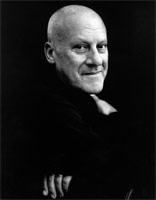 Norman Foster Norman Foster has been named ‘Britain’s Best 2008’ for ‘his ground-breaking designs around the world’. Accepting the award by video link to a ceremony attended by Gordon Brown, he beat stiff competition from J K Rowling, Damien Hirst and ‘Atonement’ Director, Joe Wright to win the Arts category. There were seven award categories in total, with one award presented in each to ‘honour those that have achieved the highest level of international acclaim in their chosen fields over the past twelve months’. The panel of judges featured Lord Coe and Marks & Spencer Chief Executive, Sir Stuart Rose. Norman Foster said: "I'm absolutely delighted to accept this prestigious award. It is wonderful for our team, which is spread around the world, to receive such recognition for our global achievements." In 2007 Foster + Partners celebrated its fortieth anniversary and greatly extended its international reach. With a staff of 1,250 and a talented team from more than fifty nations, the practice is now working across five continents, with offices in 20 cities worldwide. During this period, the practice completed several major international projects, including Beijing International Airport Terminal 3, the world’s largest covered structure, the Robert and Arlene Kogod Courtyard for the Smithsonian Institution, as well as Wembley Stadium, closer to home. |
 |
 |
  |
 Villa Celestina in Castiglioncello reopens Villa Celestina in Castiglioncello reopens |
 |
May 16, 2008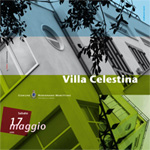 The doors of Villa Celestina in Castiglioncello reopen tomorrow. An important example of Italian Rationalism, the villa occupies a splendid position, facing the sea, between the pine forest and the cliffs. The building owes its current form to architect Vittorio Cafiero from Rome, one of the most prestigious names of his epoch. The decline of Villa Celestina, which reduced it to a state of near decrepitude, had begun in the 80s when, following various functional destinations, it was closed for safety reasons. In 1998, the State Property Administration granted the structure to the Commune of Rosignano Marittimo which began restoration, thanks to a joint agreement with the University of Pisa and the Ministry of the Environment. The premises of the first and second basement floors will be destined to the Laboratory of Ecology and Marine Biology, which will become a veritable detached headquarters of the Department of Biology of the University of Pisa. Direct access to the sea indeed makes the building particularly suited for the research activity that will be conducted there. The premises of the elevated floor will instead continue to be used by the Commune of Rosignano Marittimo which will set up a Centre for Environmental Education and organise courses, small conferences and other public events. |
 |
 |
  |
 New tower for Willis in the City of London by Foster + Partners New tower for Willis in the City of London by Foster + Partners |
 |
May 14, 2008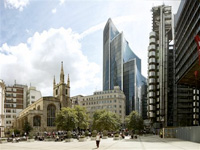 Foster + Partners Foster + Partners has completed a new UK headquarters for Willis at 51 Lime Street in the City of London. The project is significant in both urban and environmental terms. Open and integrated at street level, its shops and cafés extend the spirit of nearby Leadenhall Market; and its progressive environmental strategy surpasses statutory carbon reduction targets by more than 20 per cent. The development comprises two separate buildings which step down to a public plaza. Located to the east of the Lloyd’s Building, the 9-storey building at 1 Fenchurch Street responds to the smaller scale of Billiter Street and Fenchurch Avenue, while the 28-storey Willis Building rises to the west of the site. The smaller building’s concave façade shapes the plaza and its curved corners maintain important view corridors, as well as reinstating an historic route through the site. A fringe of shops, cafés and bars at its base together with linear seating and landscaping, combine to enhance the public realm. Norman Foster said: "Thirty years ago we worked with Willis to challenge the conventions of an office building. Today, we are delighted to have completed their new UK headquarters at 51 Lime Street. A collaboration with both Willis and British Land, this building has come out of a very different design process, yet continues the practice’s commitment to developing humane, flexible and dynamic workplaces that are both informed by, and woven into, the urban fabric." |
 |
 |
  |
 Lisbon's "Oriente", West of Europe Lisbon's "Oriente", West of Europe |
 |
April 26, 2008
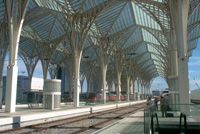 The westernmost station of the European High-Speed network will be called “Oriente Station”. The westernmost station of the European High-Speed network will be called “Oriente Station”.
We are in Lisbon, of course, where Santiago Calatrava’s famous work will become object of considerable enlargement in order to adapt to the new function introduced by the RAVE (Rede de Alta Velocidade).
The initial plan of the Ministry for Public Works was to assign the commission by competition. This decision was revised, however, precisely by virtue of the strong architectural characterisation of the existing structures, of which the Spanish architect holds the copyright. Calatrava is indeed the only one who can step in, and consequently the commission was entrusted directly to him.
Works to adapt the station to its new function mainly provide for constructing two new platforms and lengthening the existing ones from 300 to 415 metres.
The overall cost will amount to 8.2 million euros, and work is expected to be completed by 2013. |
 |
 |
  |
 The Pritzker Prize to Jean Nouvel The Pritzker Prize to Jean Nouvel |
 |
April 1, 2008
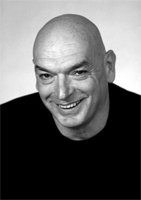 Jean Nouvel Jean Nouvel of Paris, France has been chosen as the 2008 Laureate of the Pritzker Architecture Prize. The formal ceremony for what has come to be known throughout the world as architecture’s highest honor will be held on June 2 in Washington D.C. at the Library of Congress. At that time, a $100,000 grant and a bronze medallion will be bestowed on the 62-year old architect. Nouvel who came to international attention with the completion of his Institut du Monde Arabe (usually referred to as IMA) in 1987 as one of President Francois Mitterand’s Grands Travaux in Paris, now has several projects in the United States, including the Guthrie Theater in Minneapolis completed in 2006, a 75-story tower ( Tour Verre) next door to MOMA in New York, and recently announced plans for a high rise condominium ( Suncal Tower) in the Century City district of Los Angeles. In Europe, some of his other important works are the Cartier Foundation for Contemporary Art ( Paris 1994), the Branly Museum ( Paris 2006), the Agbar Tower ( Barcelona 2005), a Courthouse ( Nantes 2000), a Cultural and Conference Center ( Lucerne 2000), an Opera House ( Lyon 1993), and Expo 2002 ( Switzerland). Also currently under construction is a concert hall in Copenhagen. In announcing the jury’s choice, Thomas J. Pritzker, chairman of The Hyatt Foundation, quoted from the jury citation, “Of the many phrases that might be used to describe the career of architect Jean Nouvel, foremost are those that emphasize his courageous pursuit of new ideas and his challenge of accepted norms in order to stretch the boundaries of the field.” And further, Pritzker added, “The jury acknowledged the ‘persistence, imagination, exuberance, and, above all, an insatiable urge for creative experimentation’ as qualities abundant in Nouvel’s work.”
» Read more |
 |
 |
  |
 Exhibition "Fifteen Roman Studies" Exhibition "Fifteen Roman Studies" |
 |
March 13, 2008
 On 14 March, at 19:30 Friday opens in Rome, San Lorenzo, via dei Bruzi 4, the New gallery architecture «come se» with the Exhibit «Fifteen roman architects, new challenges for the City of tomorrow». On 14 March, at 19:30 Friday opens in Rome, San Lorenzo, via dei Bruzi 4, the New gallery architecture «come se» with the Exhibit «Fifteen roman architects, new challenges for the City of tomorrow».
Invited architects: AeV Architects | Architecture and Vision | Centola & associated | Delogu Architects associated | John D'Ambrosio | Bioprojectgroup | King Roselli Architects | Giammetta & Giammetta | IaN + | Labics | Ma0 | Nemesi | n! Studio | JM Schivo & associated | T Studio.
The exhibition "Fifteen roman architects, new challenges for the City of tomorrow " is curated by prof. Antonino Saggio. It offers to a new generation of protagonists of the debate in Rome in these years an opportunity to present their researches. The exhibit deals with the city of tomorrow in a context where the challenges to be addressed involve an increasingly global dimension of choises. The exhibition presents a vast range of experiments and achievements that have affected both the city of Rome and other metropolitan areas and indicate a series of innovative and challenging ideas to be followed even more intensively in the coming years.
Download the pdf of opening invitation: www.comese.me.it |
 |
 |
  |
 “Architecture ... doing and redoing” “Architecture ... doing and redoing” |
 |
March 7, 2008
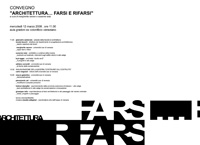 Architects have always tackled the old and what was conceived and built at different times. Architecture has always been more interesting and valuable when it proves capable of being reconceived in the continuity and discontinuity of its making. Architects have always tackled the old and what was conceived and built at different times. Architecture has always been more interesting and valuable when it proves capable of being reconceived in the continuity and discontinuity of its making.
Starting out from presentations that on different scales enact reciprocity and integration between the new and the existing, the “Architettura … farsi e rifarsi” (“Architecture ... doing and redoing”) conference proposes an encounter between architects, university teachers and the representatives of the principal bodies charged with the protection of the architectural heritage on the themes of planning and transforming buildings of historical interest.
The papers and architectures presented will highlight the planning problems as well as the qualifying factors generated by rethinking architecture in its relation to what precedes and produces it.
Today, many are called to recognize architecture in order to built as well as protect it, while architects are increasingly more called to know how to do and redo it in search of that extraordinary unity, capable of recomposing the strata of constructions through time.
Wednesday, March 12, 2008, 11 am, Aula Gradoni in the former Cotton Mill of Venice.
» For details and information |
 |
 |
  |
 “Building on the Built-up” Architecture Show “Building on the Built-up” Architecture Show |
 |
March 7, 2008
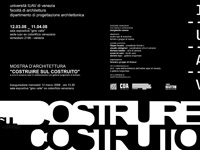 From March 12 to April 11, 2008 in the “Gino Valle” Room of the former Santa Marta cotton mill of Venice, the IUAV University of Venice presents “Costruire sul costruito” (“Building on the Built-up”), an exhibition curated by Susanne Waiz in collaboration with the Galleria Lungomare of Bolzano. From March 12 to April 11, 2008 in the “Gino Valle” Room of the former Santa Marta cotton mill of Venice, the IUAV University of Venice presents “Costruire sul costruito” (“Building on the Built-up”), an exhibition curated by Susanne Waiz in collaboration with the Galleria Lungomare of Bolzano.
The exhibition has already showed in various venues in Austria and Italy. Inaugurated in October 2006 at the Baugeschichte Archive of Adambräu in Innsbruck (A), in March 2007 it was presented in Dornbirn (Vorarlberg - A) at the Vai Vorarlberger Architektur Institut, and in October 2007 it showed in Bergamo at Porta S. Agostino as part of the “Bergamo architettura 2007” event.
In the contexts of “town” and “city”, the two sections of the Venice show focus in on a selection of new works realised in Alto Adige from 1998 to 2004 in view of revealing several specific modalities whereby contemporary architecture relates to the protection needs of the preexisting. Planning as it modifies valuable constructions is synthesised here and presented by means of graphic panels and pictures by fine photographers, supported by narrations of the buildings’ history and the outcome of their new configurations.
» For details and information |
 |
 |
  |
 Landscape Theories and Methods in France Landscape Theories and Methods in France |
 |
March 1, 2008
 To reflect on the relationship between quality of places and the human condition: this is the purpose of the Landscape Theories and Methods in France conference which Professor Yves Luginbühl will hold on March 5 at 5:30 pm in the auditorium of the Bomben spaces for culture on Via Comarotta 7-9 in Treviso, organised by the Fondazione Benetton Studi Ricerche. To reflect on the relationship between quality of places and the human condition: this is the purpose of the Landscape Theories and Methods in France conference which Professor Yves Luginbühl will hold on March 5 at 5:30 pm in the auditorium of the Bomben spaces for culture on Via Comarotta 7-9 in Treviso, organised by the Fondazione Benetton Studi Ricerche.
With this conference, Professor Luginbühl offers the opportunity to become acquainted with the ideal genesis, cultural and political process that in the second half of the 90s led to the draft and successive declaration (Florence, October 20, 2000) of the European Convention for the Landscape.
Text edit by Linda Ciacchini, il paesaggista digitale
» Read the news in full |
 |
 |
  |
 Guided Tour: Itineraries in Milan Guided Tour: Itineraries in Milan |
 |
March 1, 2008
 On the occasion of the Salone del Mobile to be held in Milan in April 2008, the Centro di Architettura ACMA is organizing three days of itineraries to visit the most important works of architecture of this past century: rationalism in Como with the Casa del Fascio, the Novocomum and the Sant’Elia Kindergarten by Giuseppe Terragni, the districts on the outskirts of Milan built in the course of the twentieth century and the first years of this century, from the QT8 by Piero Bottoni to the Gallaratese by Carlo Aymonino and Aldo Rossi, to the Metanopoli at San Donato Milanese with the Gabetti and Isola office building, to the new Mondadori headquarters by Oscar Niemeyer and Vittorio Gregotti’s complex project for the Bicocca. The itineraries also include a visit to the principal works built in Milan from the 1920s till after the war, including the Pirelli Skyscraper, the Ca’ Brütta by Muzio, Gio Ponti’s Montecatini, BBPR’s Velasca Tower and Terragni’s Casa Rustici. On the occasion of the Salone del Mobile to be held in Milan in April 2008, the Centro di Architettura ACMA is organizing three days of itineraries to visit the most important works of architecture of this past century: rationalism in Como with the Casa del Fascio, the Novocomum and the Sant’Elia Kindergarten by Giuseppe Terragni, the districts on the outskirts of Milan built in the course of the twentieth century and the first years of this century, from the QT8 by Piero Bottoni to the Gallaratese by Carlo Aymonino and Aldo Rossi, to the Metanopoli at San Donato Milanese with the Gabetti and Isola office building, to the new Mondadori headquarters by Oscar Niemeyer and Vittorio Gregotti’s complex project for the Bicocca. The itineraries also include a visit to the principal works built in Milan from the 1920s till after the war, including the Pirelli Skyscraper, the Ca’ Brütta by Muzio, Gio Ponti’s Montecatini, BBPR’s Velasca Tower and Terragni’s Casa Rustici.
» For details and information |
 |
 |
  |
 The Cities of the Future. The Project of Reason. Architecture, Science, Technology, Communication The Cities of the Future. The Project of Reason. Architecture, Science, Technology, Communication |
 |
February 25, 2008
 Saturday 1st of March 2008, h. 9:30 a.m., in the Auditorium Parco della Musica in Rome, will take place an international convention on "The Cities of the Future. The Project of Reason. Architecture, Science, Technology, Communication", promoted by City of Rome, Assessorato all'Urbanistica. Partecipants will include prestigious international speaker also John M. Johansen, John Allen, Luo Li, Serkan Anilir and will be concluded by Walter Veltroni, Roberto Morassut, Gianni Alemanno. Saturday 1st of March 2008, h. 9:30 a.m., in the Auditorium Parco della Musica in Rome, will take place an international convention on "The Cities of the Future. The Project of Reason. Architecture, Science, Technology, Communication", promoted by City of Rome, Assessorato all'Urbanistica. Partecipants will include prestigious international speaker also John M. Johansen, John Allen, Luo Li, Serkan Anilir and will be concluded by Walter Veltroni, Roberto Morassut, Gianni Alemanno.
In parallel with the conference, in the Auditorium foyer, will be open the exhibition "Fifteen Roman Studies. New Challenges for the City of Tomorrow", edited by Antonino Saggio that presents, for the first time in many years in Rome, a selection of studies protagonists of the architectural debate: AeV Architetti Associati | Giovanni D'Ambrosio | Bioprojectgroup | King Roselli Architetti | Giammetta & Giammetta | Ian + | Labics | Ma0 | Nemesi | N! Studio | Schivo | T Studio.
They will be exhibited a vast range of experiments and achievements that have affected both the city of Rome and other metropolitan areas, indicated a series of innovative and exciting roads to follow more intensively in the coming years.
» For details and informations |
 |
 |
  |
 Daniel Libeskind to be focal point of Cincinnati CAC Daniel Libeskind to be focal point of Cincinnati CAC |
 |
February 20, 2008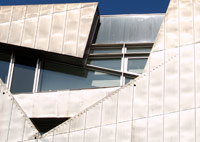 The intuition, dynamism and creative ingenuity of world-renowned architect Daniel Libeskind is the subject of a new exhibition at the Contemporary Arts Center ( CAC) in the Lois & Richard Rosenthal Center for Contemporary Art, curated by art historian Cynthia Goodman and Studio Daniel Libeskind. The CAC exhibition moves architectural designs beyond constructive forms to the realm of creative acts as illustrated by Libeskind, the architect of the nearly completed residential project, The Ascent at Roebling’s Bridge in Covington, Kentucky, near Cincinnati ( Ohio). This exhibition brings together represented by three independent, but related structures and allowing for an interactive relationship between the visitor and architecture. Images of Libeskind’s first North American high-rise project, the Ascent, as well as the aforementioned projects, are on view. Exhibition dates: Saturday, February 23 – Sunday, May 11, 2008 » For details and information |
 |
 |
  |
 Gilles Clément in Vicenza for the Tenth Appointment of Creative R’evolution 2 Gilles Clément in Vicenza for the Tenth Appointment of Creative R’evolution 2 |
 |
February 1, 2008
.jpg) Following the success of the first cycle of Creative R’evolution, winner of the first edition of the Premio Longhi for innovation, the Veneto will again host the meetings that join culture, enterprise and the territory on the theme of the genius loci with three declinations: landscape and city, production and society, art and development. Following the success of the first cycle of Creative R’evolution, winner of the first edition of the Premio Longhi for innovation, the Veneto will again host the meetings that join culture, enterprise and the territory on the theme of the genius loci with three declinations: landscape and city, production and society, art and development.
Protagonist of the tenth appointment of the series will be the great French landscape architect Gilles Clément, author of the “Manifesto of the Third Landscape”, and will be held in Vicenza at the Monotono headquarters (Viale Milano, 60) on Thursday, February 7 at 8:30 pm. Participants will also include Flavio Albanese, director of Domus.
The project is promoted and organised by Fuoribiennale, production realities of the contemporary, and by the Veneto Region administration.
The press folder and complete catalogue of the event can be downloaded at www.fuoribiennale.org. To book a place for the evening and for all other information, contact: Fuoribiennale_Agenzia del contemporaneo at press@fuoribiennale.org or call 0444.327166. |
 |
 |
  |
 Formula 1 Buildings Formula 1 Buildings |
 |
January 8, 2008
 Following the presentation of the new Ferrari, it’s now the turn of German automakers to showcase their jewels: not only racing cars, but also museums and showrooms. Following the presentation of the new Ferrari, it’s now the turn of German automakers to showcase their jewels: not only racing cars, but also museums and showrooms.
Yesterday marked the presentation of the McLaren-Mercedes F1 for the 2008 season, the car destined to relaunch the world-cup ambitions of the young Lewis Hamilton. The car was unveiled inside the Mercedes-Benz Museum of Stuttgart designed by UNStudio/Ben van Berkel, and inaugurated in 2006.
Next Monday will be BMW’s turn to present its new F1 which this year aims to occupy a stable place among the top teams. The presentation venue will, of course, be the brand new BMW Welt in Munich, designed by Coop Himmelb(l)au. |
 |
 |
  |
 Oscar Niemeyer hits 100 Oscar Niemeyer hits 100 |
 |
December 15, 2007
 One of the greatest protagonists of twentieth-century architecture, Oscar Niemeyer is today one hundred years old. The Brazilian architect was born in Rio de Janeiro on December 15, 1907, and still continues a career that has made him a leading figure in international architecture. One of the greatest protagonists of twentieth-century architecture, Oscar Niemeyer is today one hundred years old. The Brazilian architect was born in Rio de Janeiro on December 15, 1907, and still continues a career that has made him a leading figure in international architecture.
Niemeyer is considered one of the first to experiment new architectural concepts, developing a fluid sculptural style and using reinforced concrete to create sensational structures that reflect the natural sinuous curves of the mountains, the beaches and the bay of Rio de Janeiro. He has designed great projects like his numerous public buildings in Brasilia. In Italy, Niemeyer is famous for designing the Mondadori headquarters in Segrate, which was opened in 1975.
The president of Brazil, Lula, has paid tribute to the man and the great architect and honoured him by visiting him today, the day of his hundredth birthday. |
 |
 |
  |
 The Territory in a Bottle The Territory in a Bottle |
 |
November 28, 2007
The 7th issue of Locus magazine is out, dedicated to the theme “Grapevine and Wine”. The issue centres on the historical, territorial and promotional aspects of winegrowing: the magazine’s table of contents ranges from grapevine archaeology to the recovery of autochthonous grapevines, from the roads of wine to designer winery, and features contributions by Mario Botta and Renzo Piano, among others, who have both designed great cellars in Tuscany.
It is “a territory in a bottle – write Giuliana Biagioli and Rossano Pazzagli in the editorial – in the twofold sense of the promotional value of wine, but also of the pressure that the new forms of winegrowing wind up exerting on the rural environment and on the landscape, which represents a primary resource of modern Tuscany”.
Locus aims at all those interested in getting better acquainted with the past and the future of their territory, in revisiting history in light of today’s most issues, reflecting on the delicate relationship between man and natural resources, typical products and landscape. Classical and more recent disciplines, studies and debates, become entwined in a monographic section (which in this issue is reserved to “Grapevine and Wine”), and in several regular columns addressing town planning, industrial archaeology, the territory and the environment. |
 |
 |
  |
 Coop Himmelb(l)au wins commission for the Center of Performing Arts Zarautz, Spain Coop Himmelb(l)au wins commission for the Center of Performing Arts Zarautz, Spain |
 |
November 27, 2007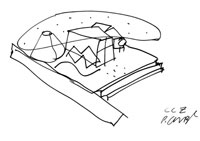
The Mayor of Zarautz, Jon Urien, just announced that out of the entries by co-finalists Zaha Hadid, Eduardo Arroyo, FOA and Kengo Kuma the design by Coop Himmelb(l)au had been elected as the winning project.
The Zarautz Scenic Arts Center is an 11,000 sq. meter Cultural Arts Center located in the Basque country of Spain in Zaruatz, 10 km from San Sebastian. The project contains a 600 seat Recital and Drama multi-use theater, a 400 sq. meter experimental Black Box auditorium, a school of music and public lobby space including a cafe-bar and a public exhibition space. A distinctive roof organizes the different elements by sheltering the open space while simultaneously working as a highly visible sign. The exterior landscaped gardens include an outdoor stage and are adjacent to the historic monastery of Zarautz and Train Station. |
 |
 |
  |
 Pisa to Come: the Chipperfield Project for the Santa Chiara Area Pisa to Come: the Chipperfield Project for the Santa Chiara Area |
 |
November 26, 2007
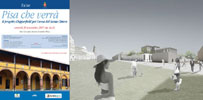 With the realisation of the new hospital-university centre, located in the modern part of the city, greater access will be afforded to the buildings and premises of the Santa Chiara area that since 1257 have housed the hospital complex and the university clinics. The area measures more than 10 hectares and is located near the extraordinary world heritage site of the Piazza dei Miracoli with the Leaning Tower, the Cathedral and Baptistery. The international competition to redo the area, returning it to the citizens of Pisa and the world, was won by the British studio David Chipperfield Architects. Now, in view of presenting the project guidelines, Felici Editore, Locus magazine and the City of Pisa have promoted a conference that will be held on Friday, November 30, at 4.30 pm at Pisa’s Stazione Leopolda. The proceedings will be opened by Giuseppe Sardu (Chairman of the Department of Town Planning of the City of Pisa) and Cristiana Torti (editor of Locus magazine); speakers will be: Mario Pasqualetti (City of Pisa and Jury Foreman), Nicoletta Novelli (Editor of Architectour.net), Massimo Dringoli (University of Pisa and jury member), Fabrizio Rossi Prodi (University of Florence), Domenico Taddei (University of Pisa), Riccardo Ciuti (Locus editorial staff).The conference minutes will be published in a special issue of Locus magazine. |
 |
 |
  |
 Convention "Cinema e Architettura" Convention "Cinema e Architettura" |
 |
November 26, 2007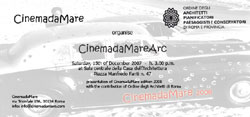
Saturday 15th of December 2007, h. 3:00 p.m. will take place a convention on Cinema and Architecture at Sala Centrale of Casa dell'Architettura (Piazza Manfredo Fanti n. 47).
This initiative is promoted by the Cultural Association CinemadaMare with the collaboration of Ordine degli Architetti of Rome. Amedeo Schiattarella, President of the Ordine, and Franco Rina, Director of CinemadaMare, will give you the welcome to the convention. During the convention there will also be other Architects, Journalist, and Assessors speaking. The aim is to meet, Italian and foreign, young filmmakers with Architects in order to produce audiovisual and to share everybodies, knowledge in this field.
In order to partecipate let us Know sending us an e.mail info@cinemadamare.com or call us 06.39.75.41.55. |
 |
 |
  |
 Calatrava in Reggio Emilia, I act Calatrava in Reggio Emilia, I act |
 |
October 19, 2007
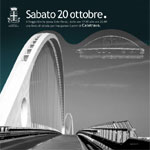 Tomorrow in Reggio Emilia, the Fiera area will witness the inauguration of the express highway that connects the city to the territory of Bagnolo. Tomorrow in Reggio Emilia, the Fiera area will witness the inauguration of the express highway that connects the city to the territory of Bagnolo.
This road is the site of three bridges designed by Santiago Calatrava, and the day will represent a unique opportunity for all those concerned to admire them from close up, before they are finally opened to traffic.
The ceremony will be attended by designer Santiago Calatrava and numerous authorities, including Prime Minister.
These bridges constitute only the first part of the development scheme of the area, destined to become the new entrance to the city. The forthcoming realisations, again on projects by Santiago Calatrava, are the tollhouse and the futuristic Mediopadana Station, the only intermediate stopover of the high-velocity railway line between Bologna and Milan. |
 |
 |
  |
 BMW World by Coop Himmelb(l)au BMW World by Coop Himmelb(l)au |
 |
October 17, 2007
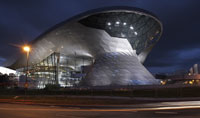 The BMW Welt (BMW World) was inaugurated today in Munich. The ceremony was attended by Wolf D. Prix, principal in charge of Coop Himmelb(l)au, the firm that designed the work, Prime Minister of Bavaria Dr. Günther Beckstein, Mayor of Munich Christian Ude, and about 800 guests. The BMW Welt (BMW World) was inaugurated today in Munich. The ceremony was attended by Wolf D. Prix, principal in charge of Coop Himmelb(l)au, the firm that designed the work, Prime Minister of Bavaria Dr. Günther Beckstein, Mayor of Munich Christian Ude, and about 800 guests.
On October 20 at 10:00 am, the building will be open for two days to visitors, offering a unique opportunity to experience the various areas and highlights of the building.
The building is located between two other architectural landmarks which are the BMW offices and headquarters, the by now “historical” four-cylinder tower by Karl Schwanzer, and the Olympic Park by Günther Benisch and Frei Otto. The main function will be that of a large showroom for delivering cars to customers but inside, it also houses space for artistic events, scientific conferences and technical presentations.
Special attention in the design has been attributed to sustainability: a series of expedients, the most evident of which are natural ventilation and the photovoltaic panels on the roof, will result in energy savings along the order of 30% compared to a traditional building.
The technical bravura includes the roof structure which, with a surface area of some 16,000 sqm., is supported by only 11 pilasters.
Pictures and details in the work’s file. |
 |
 |
  |
 Kisho Kurokawa died Kisho Kurokawa died |
 |
October 13, 2007
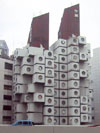 Kisho Kurokawa Kisho Kurokawa, one of the greatest exponents of contemporary architecture, has died in Tokyo at the age of 73 from a heart attack. A student of Kenzo Tange, in the 1960s he was one of the youngest founders of the Metabolist Movement, which sprang from the desire to promote an architecture that would follow the rapid growth of Japanese cities. This theory distinguished many of his works and is characterised by a structural basis inspired by DNA cells or other, similar structures. The Nakagin Capsule Tower in Tokyo (in the photo) remains perhaps his most famous work, known also to non experts. |
 |
 |
  |
 Coop Himmelb(l)au design wins competition for the Museum of Contemporary Art in Shenzhen, China Coop Himmelb(l)au design wins competition for the Museum of Contemporary Art in Shenzhen, China |
 |
October 4, 2007
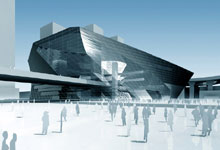 The Shenzhen Municipal Culture Bureau/Shenzhen Municipal Planning Bureau has commissioned Coop Himmelb(l)au to design the Museum of Contemporary Art & Planning Exhibition in Shenzhen, China. The Shenzhen Municipal Culture Bureau/Shenzhen Municipal Planning Bureau has commissioned Coop Himmelb(l)au to design the Museum of Contemporary Art & Planning Exhibition in Shenzhen, China.
The design is an urban meeting point and serves as a dynamic element in the progressive system of the city of Shenzen in the middle of their new center, the "Futian Cultural Center". The building integrates itself in the language of the established master plan with a site area of approximately 30.000 sqm and represents the discovery of an individual exciting object.
The form of the 40 m high building is a result of a vertical extrusion and rotation from the rectangular ground floor through to the roof level. A new entry orientation has been achieved through this rotation to the axial center of the cultural zone of the Futian Central District and to the main circulatory flows. The resulting rotation generates a dynamic building in the form of an "active wave". By using black anodized metal and black glass, the active wave is frozen into an urban monolith. |
 |
 |
  |
 Frank Lloyd Wright on Show in Volterra Frank Lloyd Wright on Show in Volterra |
 |
September 28, 2007
 The city of the Etruscans pays homage to Frank Lloyd Wright. The city of the Etruscans pays homage to Frank Lloyd Wright.
Tomorrow is in fact the inauguration of the exhibition “Frank Lloyd Wright, Precursor of Modern Architecture”, organised by the Friends of Frank Lloyd Wright Association in the splendid backdrop of Villa Palagione near Volterra, on the occasion of the 140th anniversary of the birth of the great American master.
Among the side events, we cite the conference that will be held Saturday 13 and Sunday 14, October at the Centro Studi Santa Maria Maddalena in Volterra, which will also witness the participation of Eric Lloyd Wright, the architect’s grandson and founder of Wright Way Organic Resource Centre in Malibu.
The cellar of Palazzo Minucci Solaini in Volterra will host Carol Bishop’s exhibition “Frank Lloyd Wright, the Romantic Spirit”, pictorial elaborations based on photographs of the architect’s works.
The exhibition will run until November 11, 2007.
»For details and information |
 |
 |
  |
 The Return of “Blade Runner” The Return of “Blade Runner” |
 |
September 3, 2007
 The Venice Film Festival witnessed the presentation of “Blade Runner: The Final Cut”. The Venice Film Festival witnessed the presentation of “Blade Runner: The Final Cut”.
Director Ridley Scott defined this “version” of the film as “the definitive version”, that is to say the one he would have made at the time of its first release (1982) without constrictions from production. He in fact did not stop at restoring, remastering and scanning the film in high definition; he added scenes that in the first version had been cut, and others were revised and corrected. This in effect can be considered an out-and-out new version of the film.
Blade Runner also left a sign in architecture, and Architectour.net, particularly attentive to the relationship between cinema and architecture, is pleased to give the news, inviting you to discover which of its fascinating sets were, in reality, important existing works of modern architecture.
In the “Advanced Search” section of the Architectour.net database (horizontal navigation bar above), it is indeed possible to make searches by simply inserting in the “film” field, a word of the title, the name of the director or of one of the interpreters.
In so doing, you will discover that many scenes in “Blade Runner” were shot in the Ennis-Brown House by Frank Lloyd Wright and in the Bradbury Building by George Herbert Wyman. |
 |
 |
  |
 Jean Nouvel “Ferrarist” Jean Nouvel “Ferrarist” |
 |
July 16, 2007
 The duel between Ferrari and McLaren continues. After the challenges on the track and the recent spy-story, the confrontation continues in architecture. While the British team has decided to entrust the construction of a brand-new headquarters to Norman Foster, some time ago Ferrari decided to restructure and progressively enlarge its historic headquarters astride the towns of Maranello and Fiorano. Operations came one after the other, following a master plan, based on directives personally laid out by Luca di Montezemolo. The duel between Ferrari and McLaren continues. After the challenges on the track and the recent spy-story, the confrontation continues in architecture. While the British team has decided to entrust the construction of a brand-new headquarters to Norman Foster, some time ago Ferrari decided to restructure and progressively enlarge its historic headquarters astride the towns of Maranello and Fiorano. Operations came one after the other, following a master plan, based on directives personally laid out by Luca di Montezemolo.
After the Wind Tunnel by Renzo Piano, the buildings for production and the new company cafeteria by Marco Visconti, the “box” for the Sports Management by Studio Sturchio, the Development Centre by Massimiliano Fuksas, now is the time of Jean Nouvel.
The French architect has been appointed to design the building where the cars will be assembled, an operation that will follow the policy of a “company on a human scale” that the Modenese house pursues.
The roads of Jean Nouvel and Ferrari had already met up, though indirectly, in the by-now famous Kilometro Rosso, the technological centre built at Stezzano by Brembo, the company that supplies the brakes for Ferrari, and conceived as a declared tribute to the “rosse”. |
 |
 |
  |
 Eco-sustainability: the UN Sets a Good Example Eco-sustainability: the UN Sets a Good Example |
 |
July 6, 2007
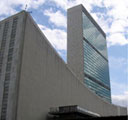 Built in the early 1950s, based on a project by Le Corbusier, the “Glass Building”, UN headquarters in New York, will soon be the object of a total renovation. Built in the early 1950s, based on a project by Le Corbusier, the “Glass Building”, UN headquarters in New York, will soon be the object of a total renovation.
Work will begin next year and be completed by 2014. The duration of renovation is due to the fact that work will be conducted by sectors of 10 floors at a time, so as not to interrupt the United Nations’ activity.
The purpose of the operation, which will cost 1.9 billion dollars, is to adapt the building to current necessities, as well as to reduce its energy needs by 30%, improving its efficiency and ecological impact, on the basis of the environment model in the United Nations Programme. |
 |
 |
  |
 Young Italian Architects on Show in Schio Young Italian Architects on Show in Schio |
 |
July 5, 2007
On the initiative of Gruppo 3+, a new edition of the exhibition of Young Italian Artists under 40 is being inaugurated in Schio (Vicenza).
The exhibition will be held in Palazzo Fogazzaro on Via Pasini, and run until July 22.
|
 |
 |
  |
 New Wineries: Here Comes Renzo Piano New Wineries: Here Comes Renzo Piano |
 |
July 4, 2007
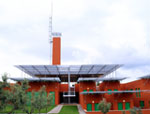 Also the prestigious firm of Renzo Piano joins those of architects who, in recent times, have designed wineries/showrooms for winegrowers. Last Saturday witnessed the inauguration of the Rocca di Frassinello winery in the Commune of Gavorrano. Also the prestigious firm of Renzo Piano joins those of architects who, in recent times, have designed wineries/showrooms for winegrowers. Last Saturday witnessed the inauguration of the Rocca di Frassinello winery in the Commune of Gavorrano.
Realised only a very short time after the Cantine Petra by Mario Botta, this operation contributes to placing the Maremma at the top of winegrowing.
On the same day, the Mayor of Gavorrano bestowed honorary citizenship on Renzo Piano at a public ceremony held in the city theatre.
With this operation, Tuscany can thus also boast on its territory a project by the greatest Italian contemporary architect, alongside the great master of the past. |
 |
 |
  |
 Wembley 2: the New “Temple” of Football Wembley 2: the New “Temple” of Football |
 |
March 16, 2007
Wembley Stadium opens tomorrow with a demonstrative game organised to test the structure’s functioning. The first official game will be played next Saturday (March 24) between the Under-21 teams of England and Italy, while the real inauguration will be held in May, with the final of the English Cup. In a few days, the first concert will also be held: singer George Michael, ex “Wham!” performing on stage.
The first Wembley Stadium, built in 1924 and considered the “temple” of European football, was demolished in 2002 to make way for this new futuristic complex designed by Sir Norman Foster with HOK Sport. Characterised by the large arch that supports the roof, the structure cost 757 million pounds, and at maximum capacity (football and rugby games) will count on a covered seating capacity of 90,000.
It will also be one of the principal venues for the Olympic games of 2012.
In addition to inheriting the name and football tradition of the old installation, the new stadium with the steel arch that surmounts it (133 metres high and a development of 315 metres) also proposes itself as one of London’s new landmarks. |
 |
 |
  |
 Banca del Gottardo: a new architectural award Banca del Gottardo: a new architectural award |
 |
May 4, 2007
In concurrence with the 150th anniversary of Swiss Life and its own 50th anniversary, the Banca del Gottardo of Lugano has decided to institute an architectural award.
From its very first edition, the Gottardo Architectural Award presents itself with all its credentials in order to acquire prestige in the sector. President of the jury will be Mario Botta, director of the Academy of Architecture of Mendrisio; the award will be of 100,000 Swiss francs, and will have a biannual cadence. The winner will be selected among candidates under 50 years of age who have realised at least 3 works that excel for their integration with the landscape and environmental context, and that reflect contemporary architectural culture.
This first edition of the award will be officialized next autumn, and the winner will be anno
unced one year later. |
 |
 |
  |
 Mies van der Rohe Award 2007 Mies van der Rohe Award 2007 |
 |
April 27, 2007
The Mies van der Rohe Award 2007 has been assigned to MUSAC (Museo de arte contemporáneo de Castilla y León) of León, designed by the Mansilla + Tuñón firm of Madrid, a structure externally characterised by polychromous glass facades.
The jury chaired by Richard Burdett selected this work, preferring it over the 6 other finalists (Lacaton & Vassal, Rudy Ricciotti, Zaha Hadid , UN Studio/van Berkel & Bos, David Chipperfield, Aires Mateus & Associados). With the patronage of the European Union, the award is assigned every 2 years to the work that stands out for innovative project features and for high quality construction.
Special mention reserved to emerging architects went to the Faculty of Mathematics of Ljubljana, designed by the Bevk Perović firm of Slovenia. |
 |
 |
  |
 A Leap into Empty Space A Leap into Empty Space |
 |
April 4, 2007
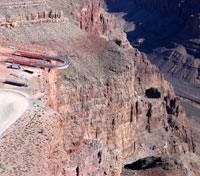
Last week marked the inauguration of the “Grand Canyon Skywalk”, the audacious footbridge suspended more than 4000 feet (about 1219 metres) over the floor of the Grand Canyon, with a projection of 70 feet (about 21 metres). The glass bottom of the walkway emphasises the walk into space, making it become a walk in the sky, speaking of which, astronaut Buzz Aldrin, one of the protagonists of the “walks” on the Moon, was invited to take the first “skywalk”. The footbridge is the cutting edge of a multipurpose complex that includes a hotel, a restaurant, a museum dedicated to the Grand Canyon and various conference rooms. The architectural project is by the M.R.J. Architects firm of Las Vegas which, for the structural part, availed itself of the collaboration of Lochsa Engineering, also from Las Vegas. The Hualapai Indian tribe, owner of the territories, were the promoters of the initiative that has led to the realisation of this complex and spectacular structure.Not recommended for people afraid of heights … |
 |
 |
  |
 The Pritzker Prize to Richard Rogers The Pritzker Prize to Richard Rogers |
 |
April 3, 2007
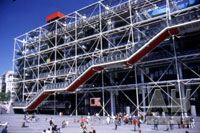 The 2007 Pritzker Prize for architecture has been awarded to Richard Rogers. Only a few months after the "Leone d’Oro alla Carriera" that he was assigned by the Venice Biennial, Rogers thus obtains the most important acknowledgement in the field of architecture. The 2007 Pritzker Prize for architecture has been awarded to Richard Rogers. Only a few months after the "Leone d’Oro alla Carriera" that he was assigned by the Venice Biennial, Rogers thus obtains the most important acknowledgement in the field of architecture.
Born in Florence in 1933, nephew of Ernesto Nathan Rogers, the British architect attained renown while still young by winning, with Renzo Piano, the competition for the construction of the Centre Georges Pompidou in Paris (better known as Beaubourg, in the photo), one of the most significant buildings of the 20th century.
In the course of his career, he has constructed many major buildings, such as Lloyd’s and the Millennium Dome, both in London, which have constantly qualified him as one of the leading protagonists of contemporary architecture, indeed to the point that this acknowledgement seems somewhat late in coming. |
 |
 |
  |
 |
 |
|
 |
 |
  |
 A Watery Appearance for Montecatini A Watery Appearance for Montecatini |
 |
March 12, 2007
The appearance of Montecatini Terme will radically change in the near future, and the task to perform this transformation has been entrusted to Massimiliano Fuksas.
The operations planned are quite a few: construction of new pools, renovation of existing systems, redefinition of the entire spa park, and construction of two exhibition centres, which will be dedicated to contemporary art.
The basic idea of the projects to be developed by the Roman architect is that of “showing water”. Today’s visitor to what is one of the most famous spa localities in Italy does not at all perceive the “presence” of water or its principal peculiarity. The task of the operation will therefore be to give Montecatini Terme the appearance it deserves: that of a “city of water”. |
 |
 |
  |
 New Museum Frontiers. Louvre and Guggenheim in Abu Dhabi New Museum Frontiers. Louvre and Guggenheim in Abu Dhabi |
 |
January 8, 2007
Large-scale manoeuvres underway in the Arab Emirates aim to import trademarks (and works) by the most famous names of western museums. The Guggenheim has already announced the construction in Abu Dhabi of what will be its largest exhibiting space: 30,000 square metres, ready in five years, obviously signed by Frank O. Gehry.
Meanwhile, the French government urged by president Chirac is also making moves to open an Arab branch of the world’s most famous museum. It should rise on the island of Saadiyat, offshore of Abu Dhabi, and be accompanied by an art city and a tourism centre with a five-star hotel and golf courses. The overall cost of the operation is estimated at one billion euros, and the leading candidate to design it, is reportedly Jean Nouvel. |
 |
 |
  |
 Berlin Alexanderplatz Berlin Alexanderplatz |
 |
February 14, 2007
Hans Kollhoff will redesign Berlin’s Alexanderplatz. Already author of one of the towers that characterise Potsdammer Platz, the German architect won the competition for the reconstruction of the square that is currently an enormous empty space, conceived by East Germany as a setting for the military parades and mass gatherings. The Kollhoff project, a large block in the shape of a horseshoe, takes off from an old project conceived in the 1920’s by Peter Behrens. The operation plans for the construction of 1,300,000 square metres, including offices, apartments and shops, while the square’s new symbol will be a skyscraper 150 metres high. In the intentions of the Municipality of Berlin, the operation will be completed in 2013, and Alexanderplatz will become the new city centre. |
 |
 |
  |
 Vito Acconci in Florence Vito Acconci in Florence |
 |
February 12, 2007
The Salone Brunelleschi of the Istituto degli Innocenti in Florence today hosts an encounter with American artist/architect Vito Acconci, dedicatee of a recent volume that illustrates his “body-art” period (1969-1973). The encounter opens the 2007 season of the Osservatorio sull’Architettura promoted by the Fondazione Targetti, and will deal with the theme “Reinventing public space”. |
 |
 |
  |
 Beaubourg's 30th Beaubourg's 30th |
 |
January 30, 2007
The “Centre Nationale d’Art et de Culture Georges Pompidou”, better known as Beaubourg, tomorrow celebrates its 30th year. On the day of its “birthday”, what has been one of the most important buildings of the entire XX century, will receive the visit of President of the Republic, Jacques Chirac. For the two days following, the structure will instead be open until 11 pm, and throughout the month of February, the square in front of it will host the projection of a video that tells its story. In its 30 years of life, the building by Renzo Piano and Richard Rogers has been visited by more than 180 million people and has already been the object of renovation, precisely to adapt it to an extraordinary success among the public, greater than even the most optimistic forecasts. |
 |
 |
  |
 Architecture and Formula 1 Architecture and Formula 1 |
 |
January 15, 2007
The new formula 1 McLaren-Mercedes was presented today in Valencia at the “Ciutat de las Ciènces” by Santiago Calatrava. With this Spanish presentation, the Anglo-German team pays tribute to its new driver Fernando Alonso, the two-year world champion, who will be joined by young debutant Lewis Hamilton. After rendering fully operative its new headquarters, designed by Norman Foster, McLaren once again repeats the formula 1-architecture combo. |
 |
 |
  |
 Rocket Targets Gropius Embassy Building in Athens Rocket Targets Gropius Embassy Building in Athens |
 |
January 12, 2007
At dawn this morning, a rocket was launched against the American Embassy of Athens, designed by Walter Gropius with TAC group (The Architects Collaborative).
The Greek terrorist organisation “Revolutionary Struggle” claimed responsibility for the attack which caused neither victims nor wounded, and damages to the building are limited to the third-floor bathrooms. The building has been closed as a preventive measure and is presently guarded by police. |
 |
 |
  |
 Frank O. Gehry. Another “flash” in the Basque Country Frank O. Gehry. Another “flash” in the Basque Country |
 |
September 1, 2006
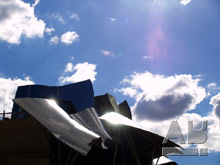 Today marked the inauguration of the “Ciudad del Vino Marqués de Riscal”, Frank O. Gehry’s new work that brings the Californian architect back to the Basque Country almost ten years after the planetary success of his Bilbao Guggenheim. Today marked the inauguration of the “Ciudad del Vino Marqués de Riscal”, Frank O. Gehry’s new work that brings the Californian architect back to the Basque Country almost ten years after the planetary success of his Bilbao Guggenheim.
Elciego is a small “border” town whose inhabitants (Basques) are forced to refer to the very close region of Rioja whose capital city, Logroño, is much closer than the Basque cities. From Rioja, Elciego has taken the economy, fundamentally based on wine production, one of the world’s best. Bodegas Paternina came into existence in the 17th century. Loved also by Hemingway, it is known as the “Sistine Chapel of Wine”.
Also in Elciego, AMP y Asociados is building a new cellar for Bodegas Domecq; a few kilometres away, Santiago Calatrava has built the Bodegas Ysios and, in Haro, Zaha Hadid is building the Bodegas López de Heredia.
Gehry’s new building is a luxury hotel with adjoining Spa for wine-therapy, a restaurant, conference rooms, and a museum. Its titanium roof in the basic colours of pink, gold and silver, inspired by those of the vineyards and bottles, have already won it the title of “pequeño Guggenheim”.
All the photos can be viewed in exclusive in the Architectour.net file. |
 |
 |
| Back |
|
|
 |
  |
 |
|
|